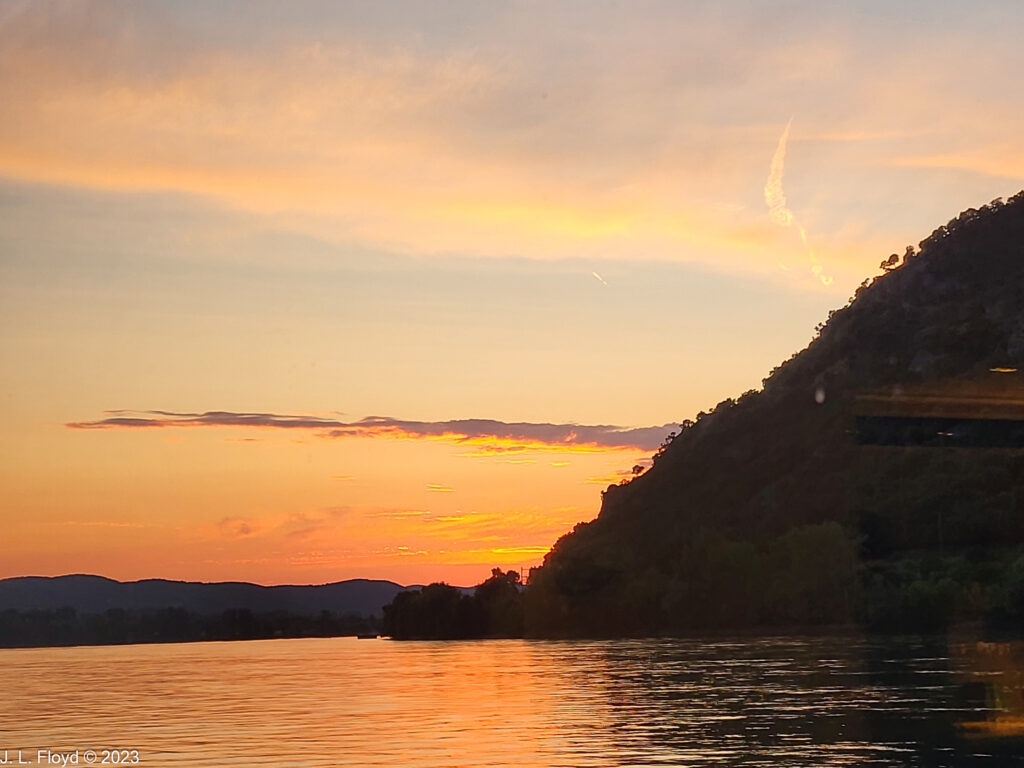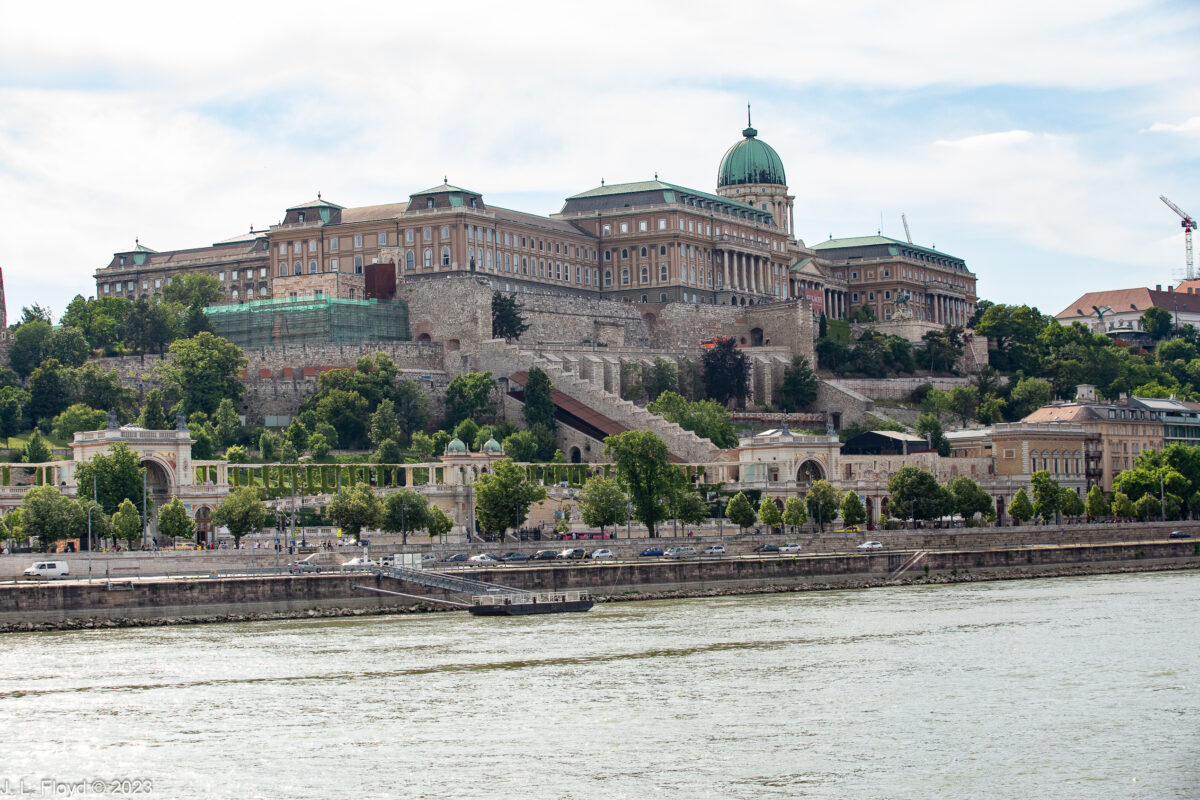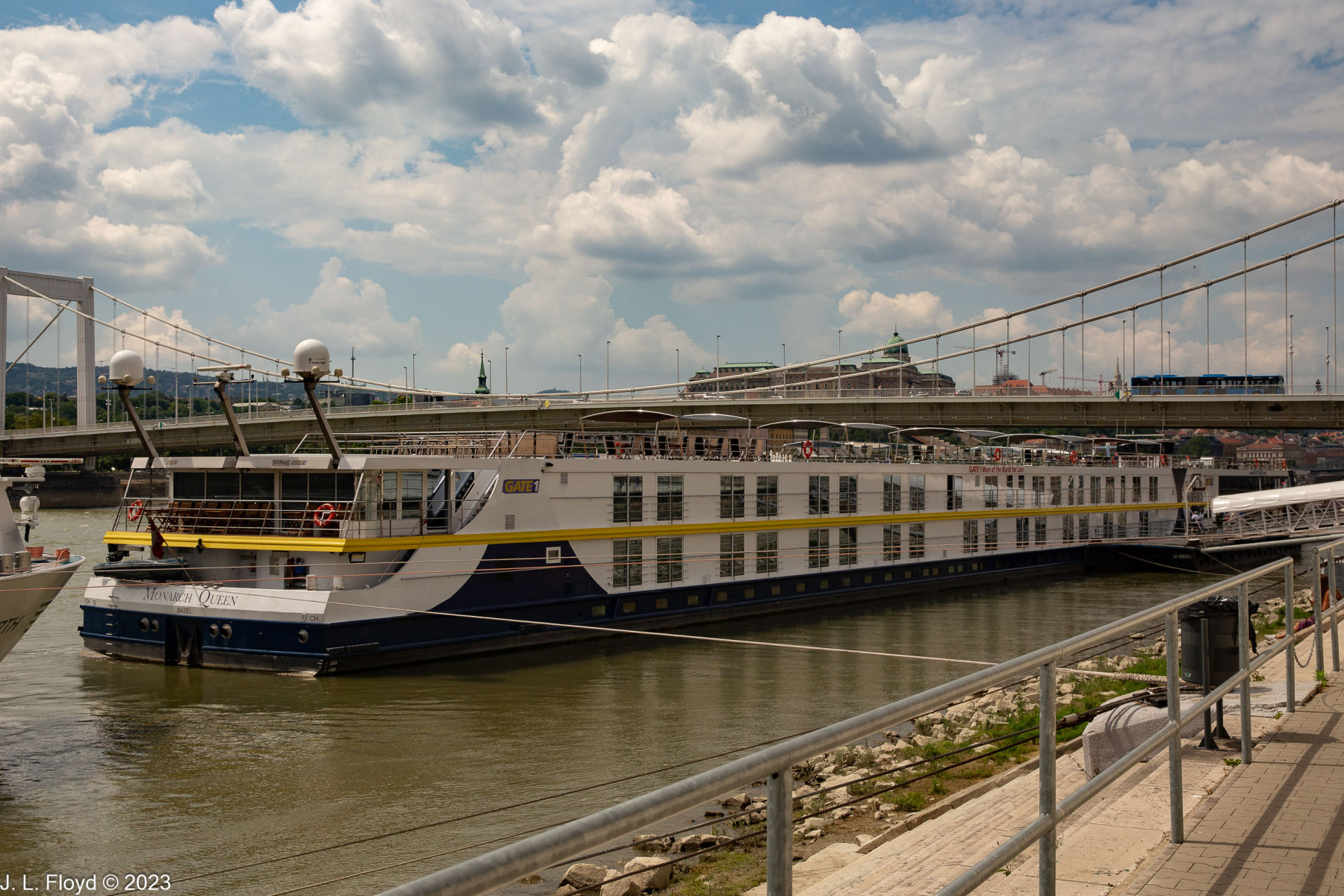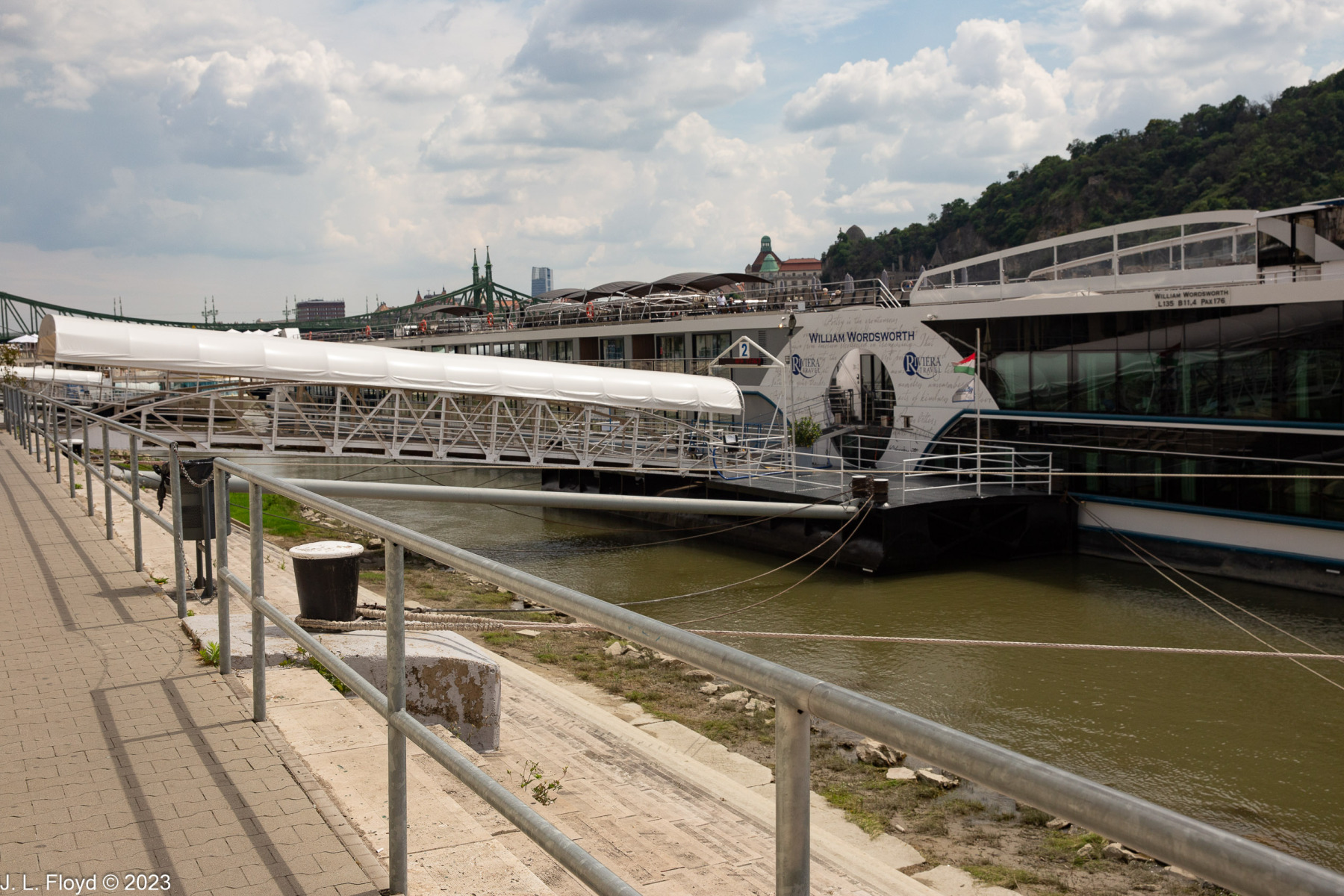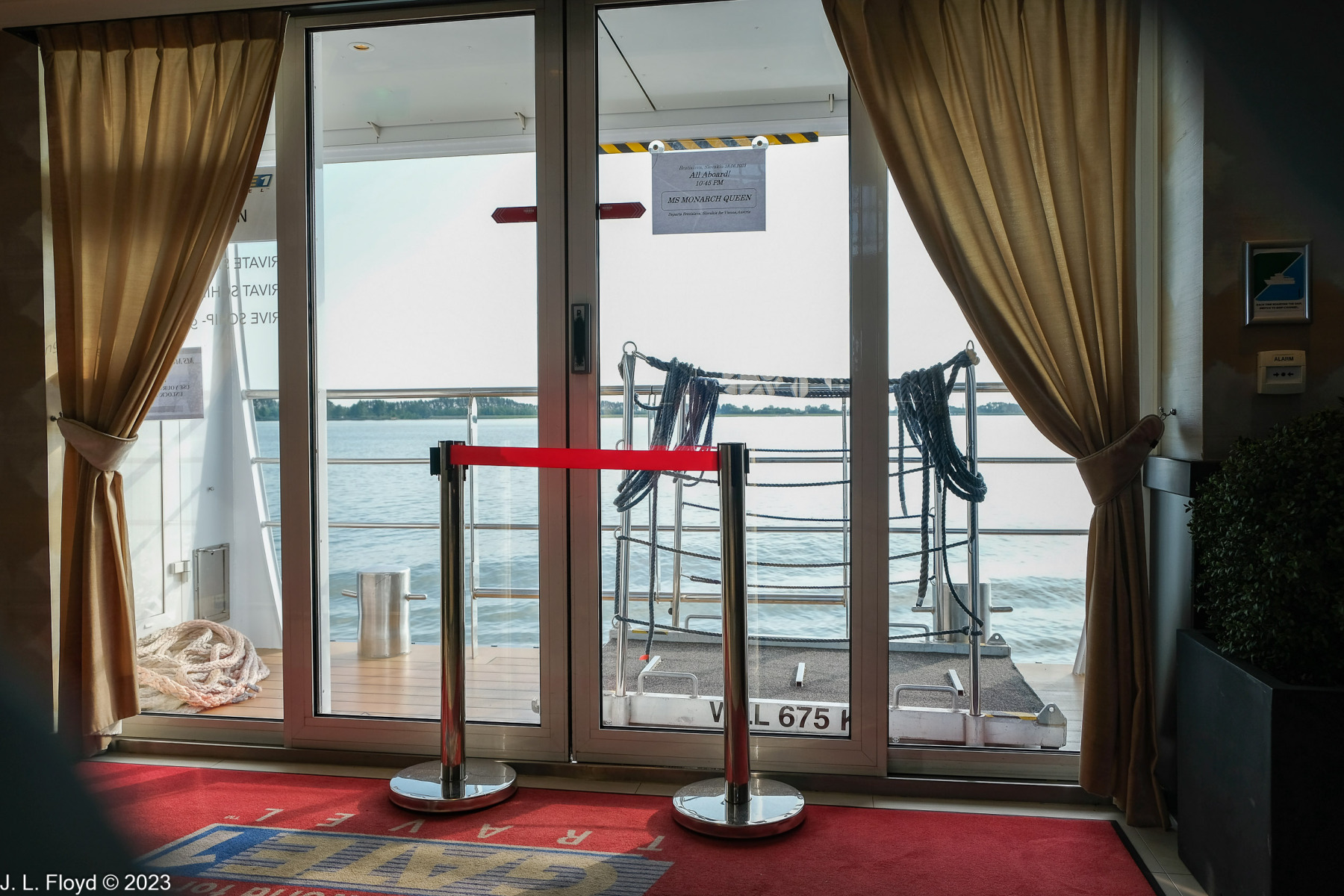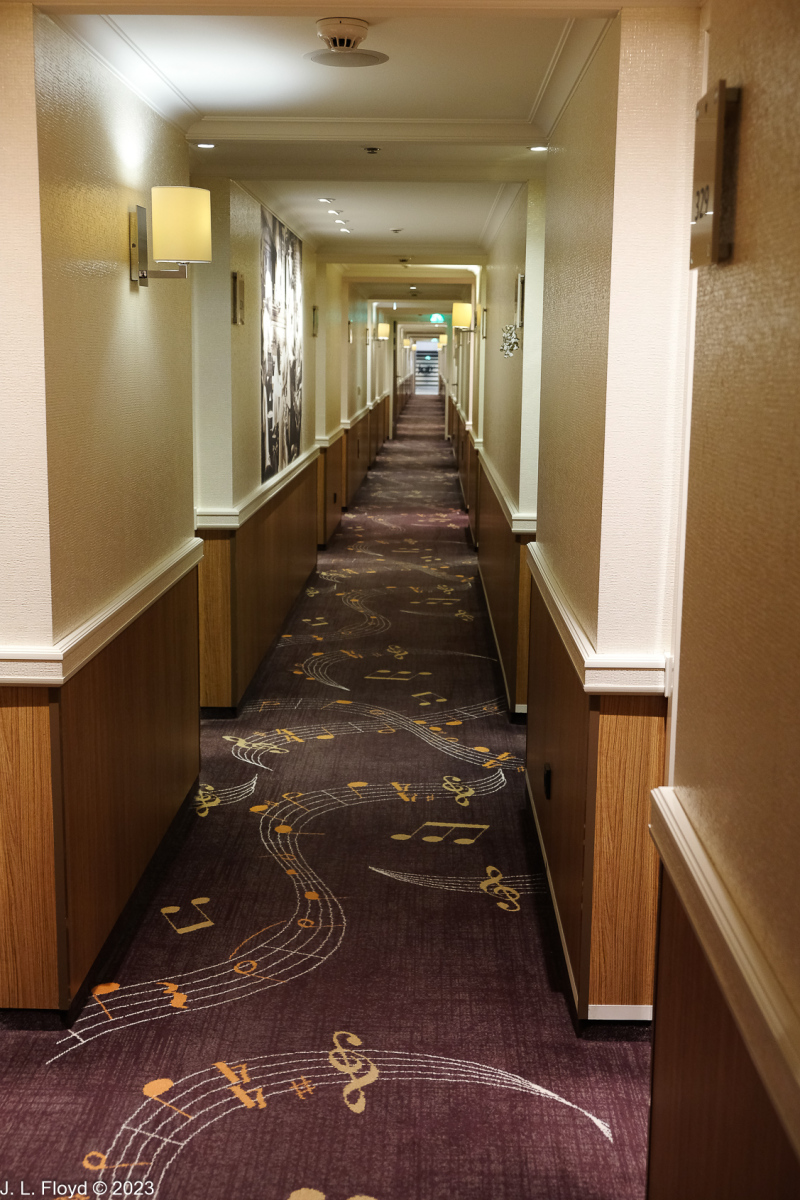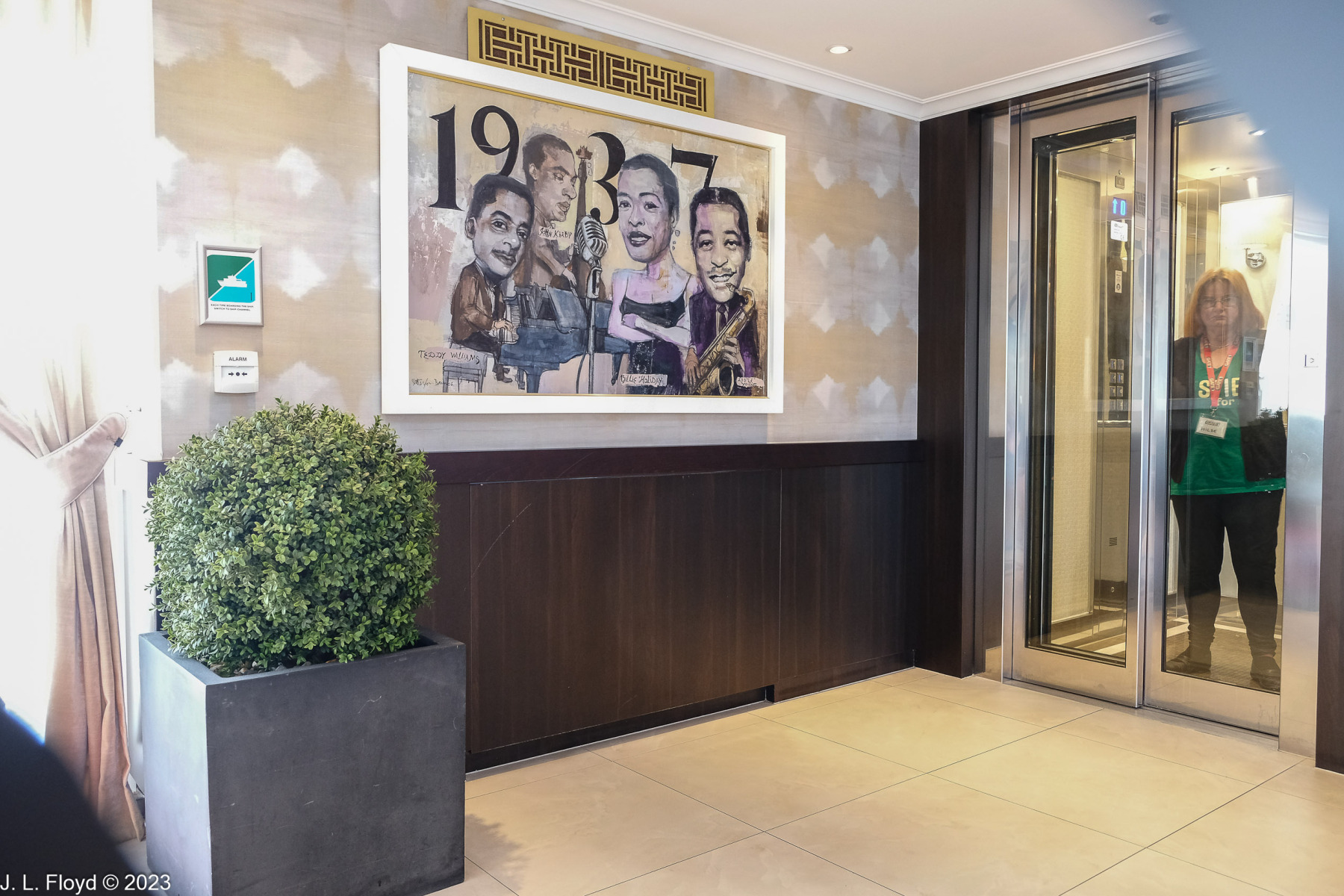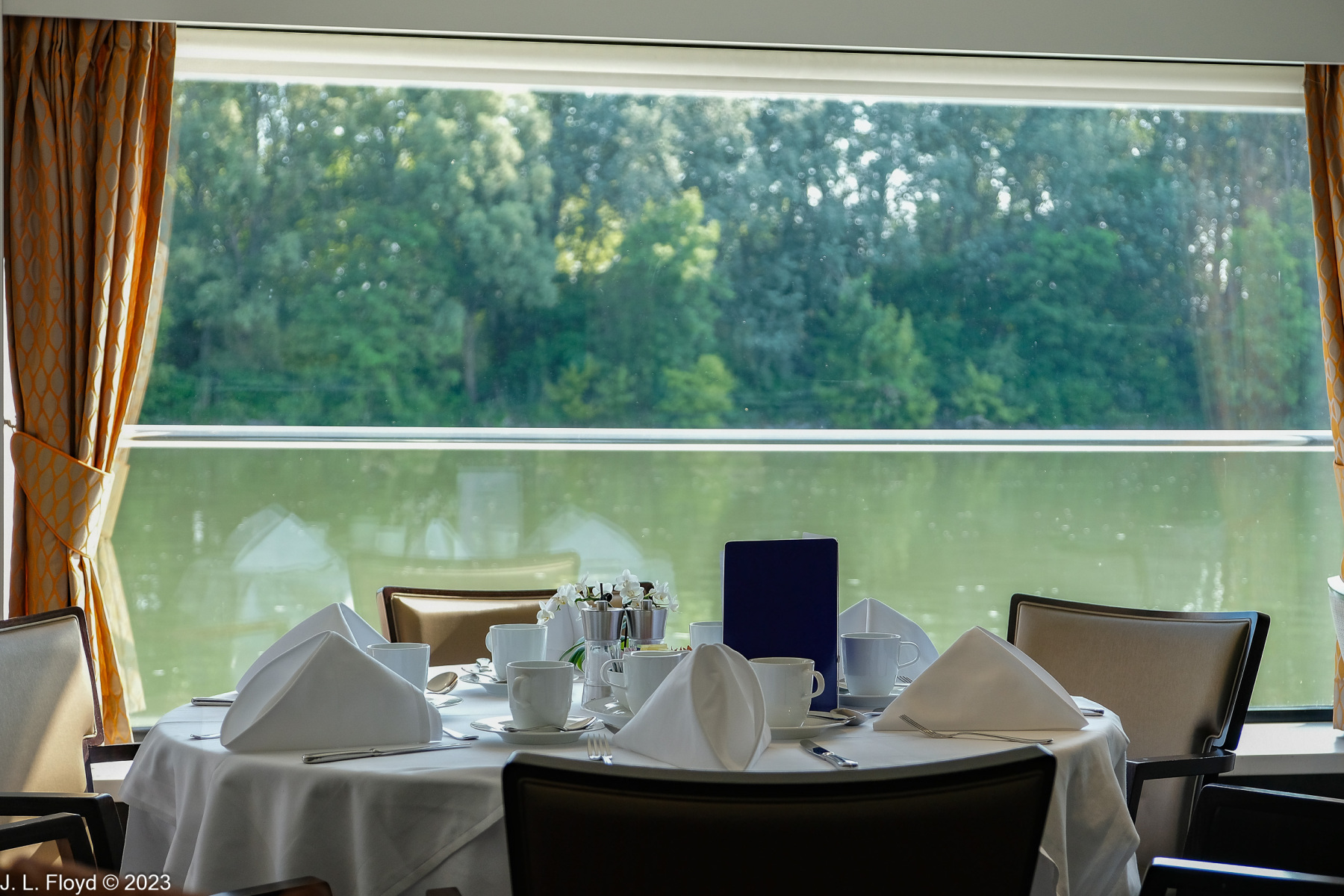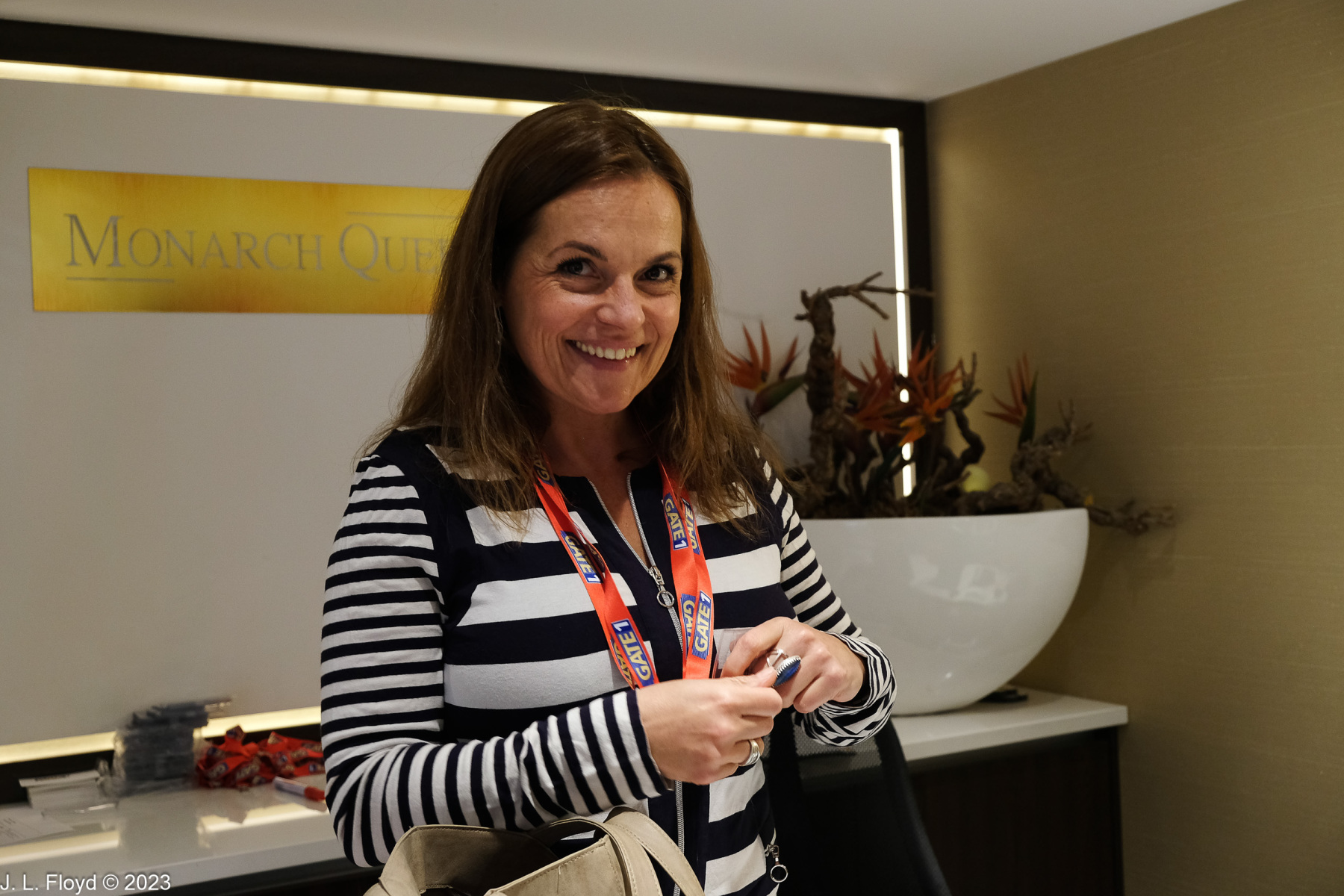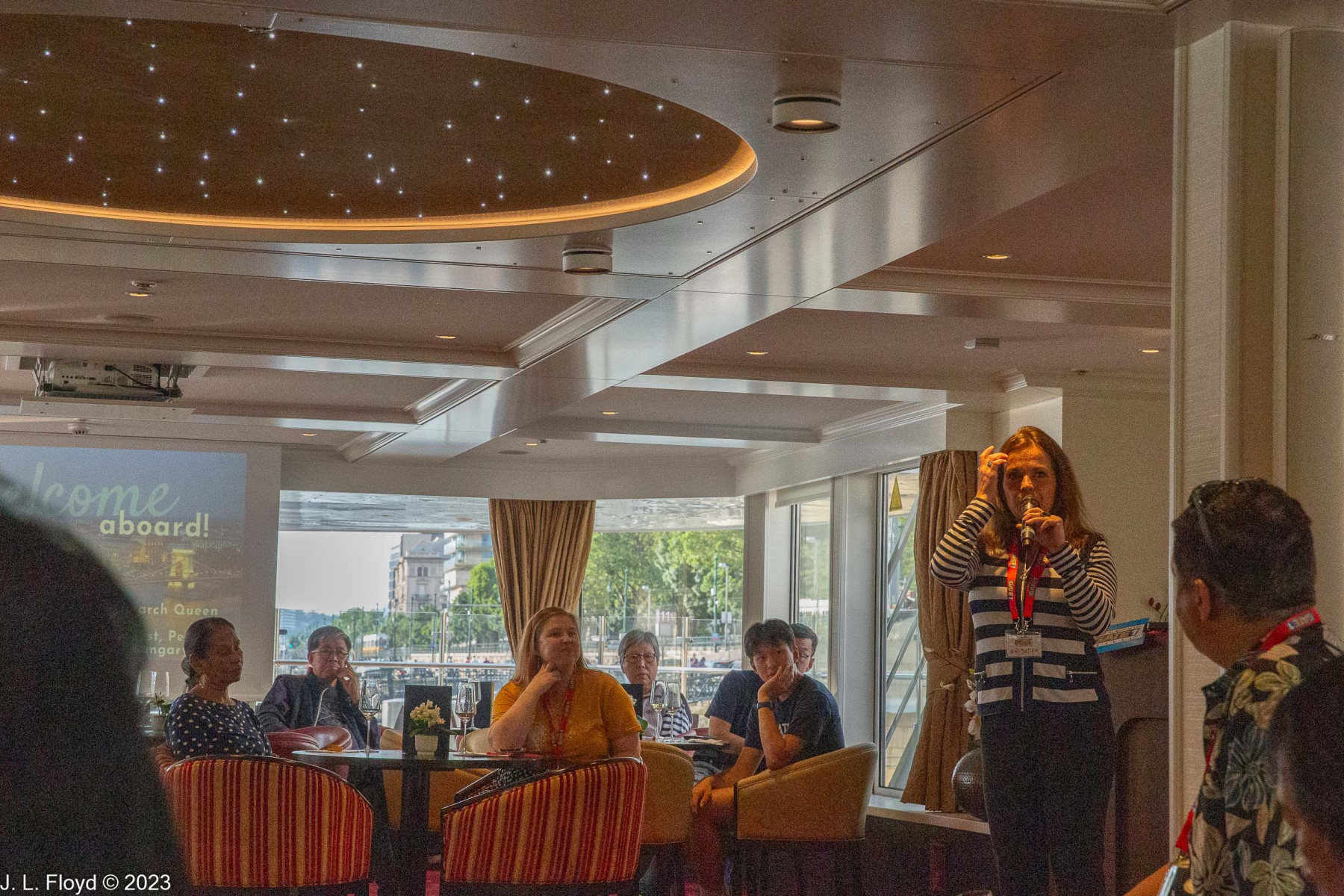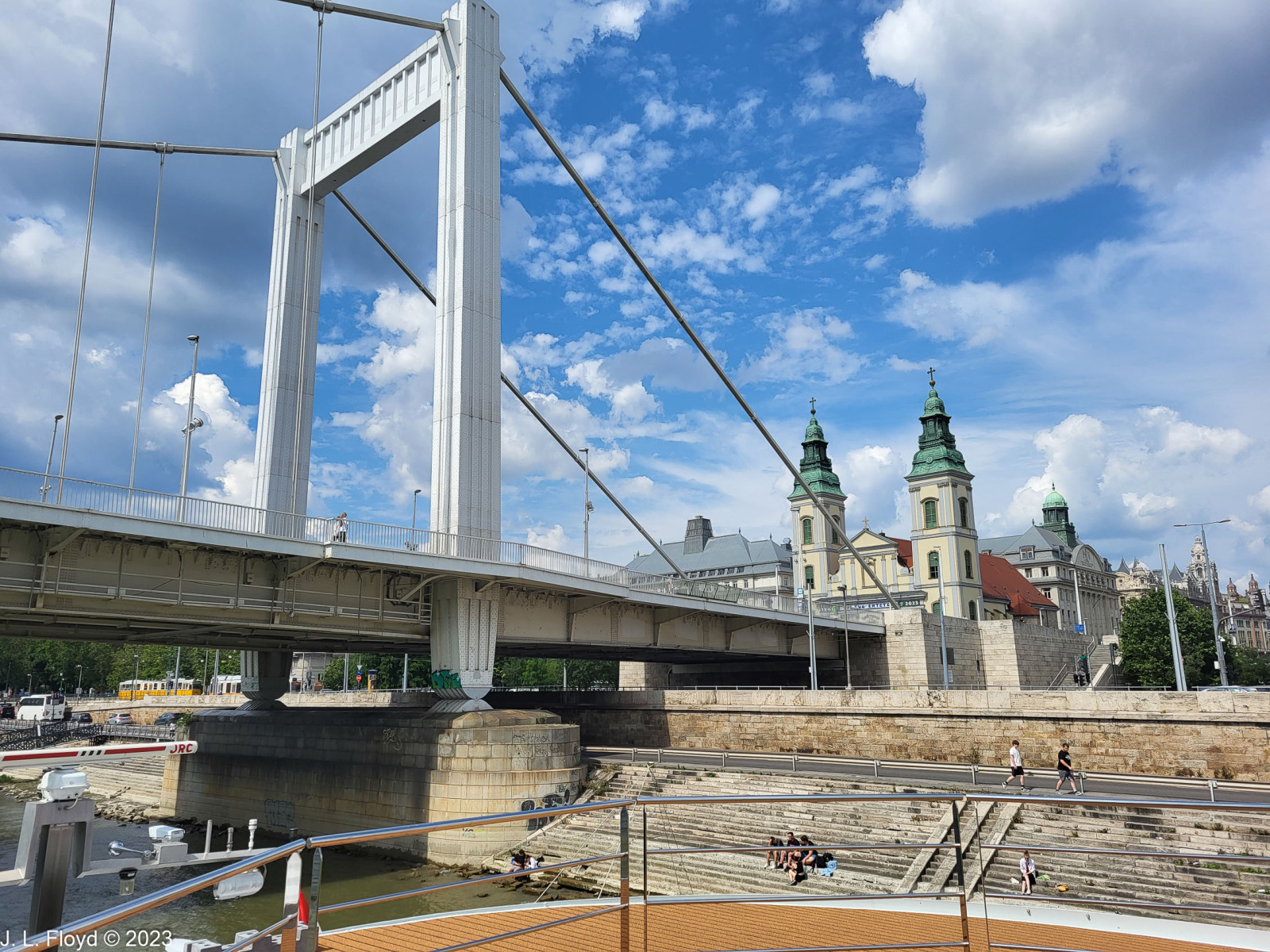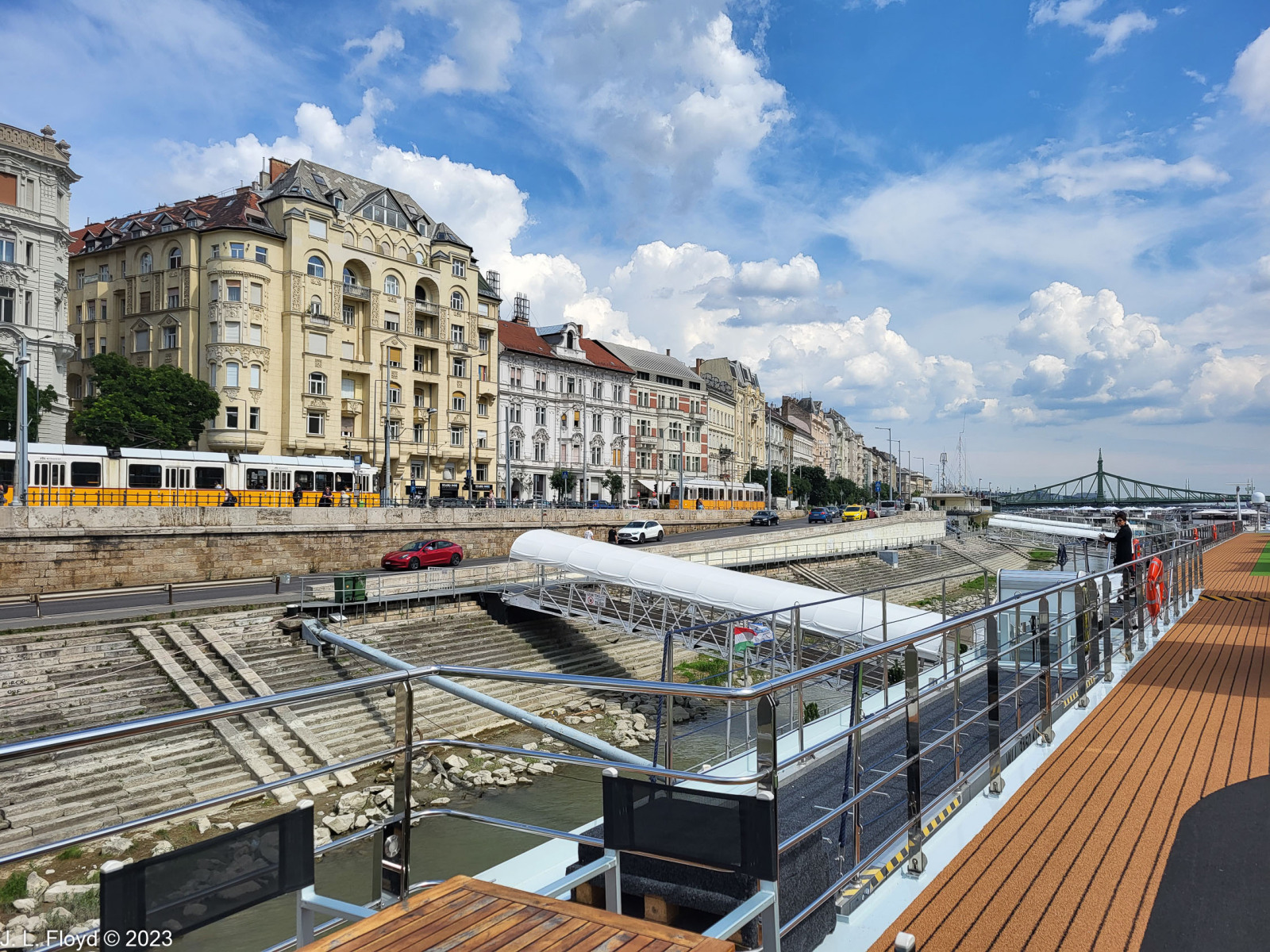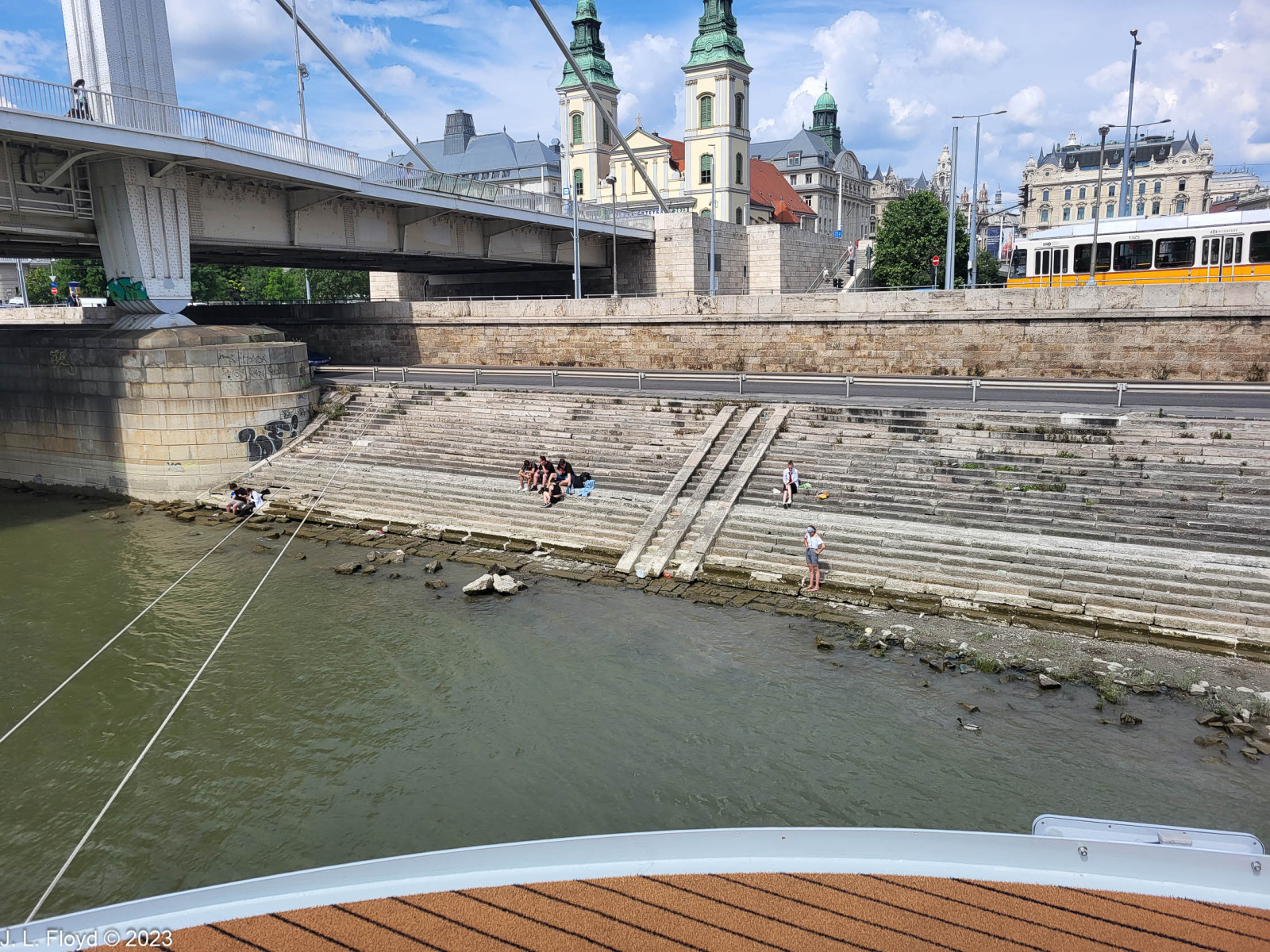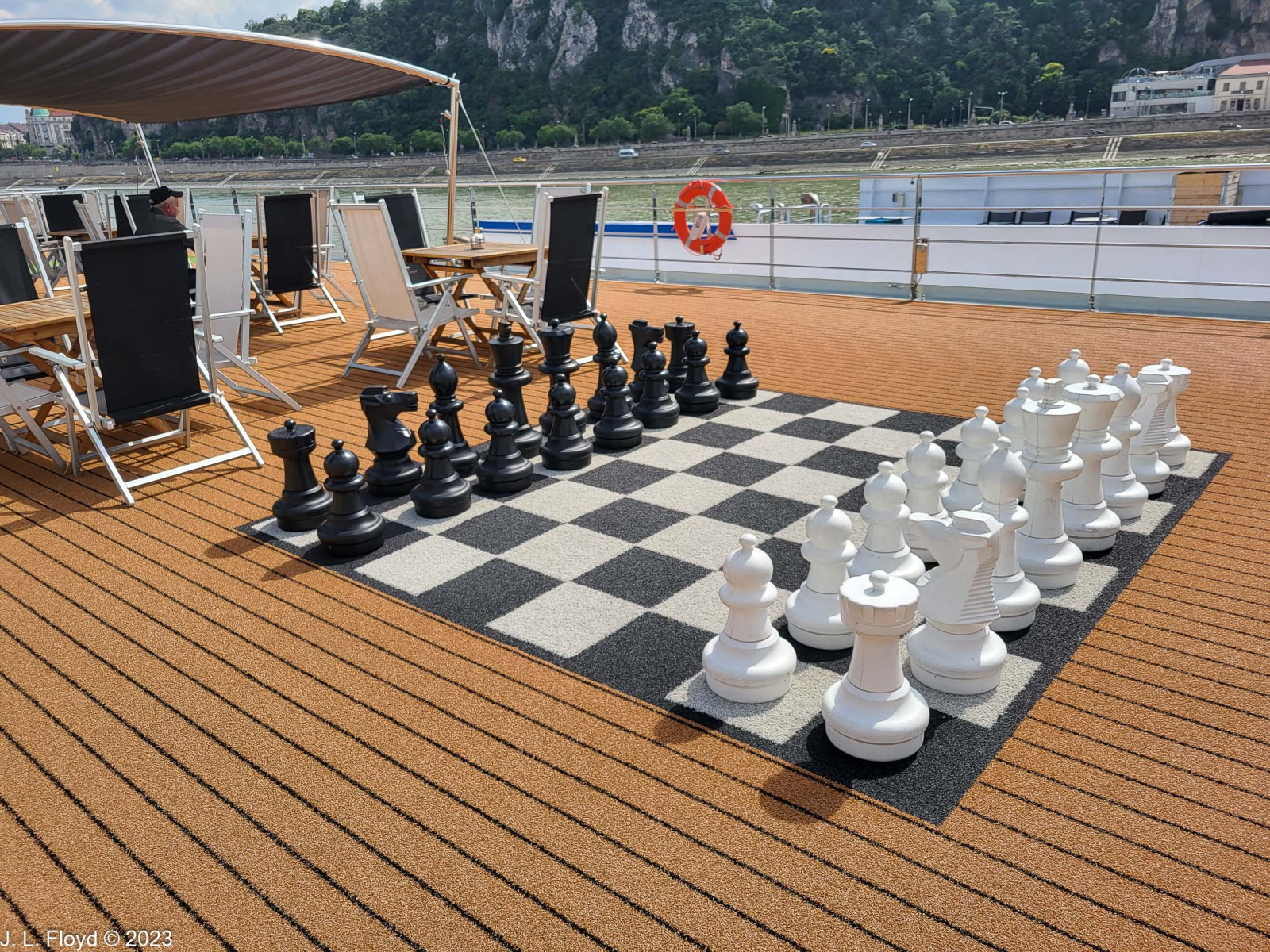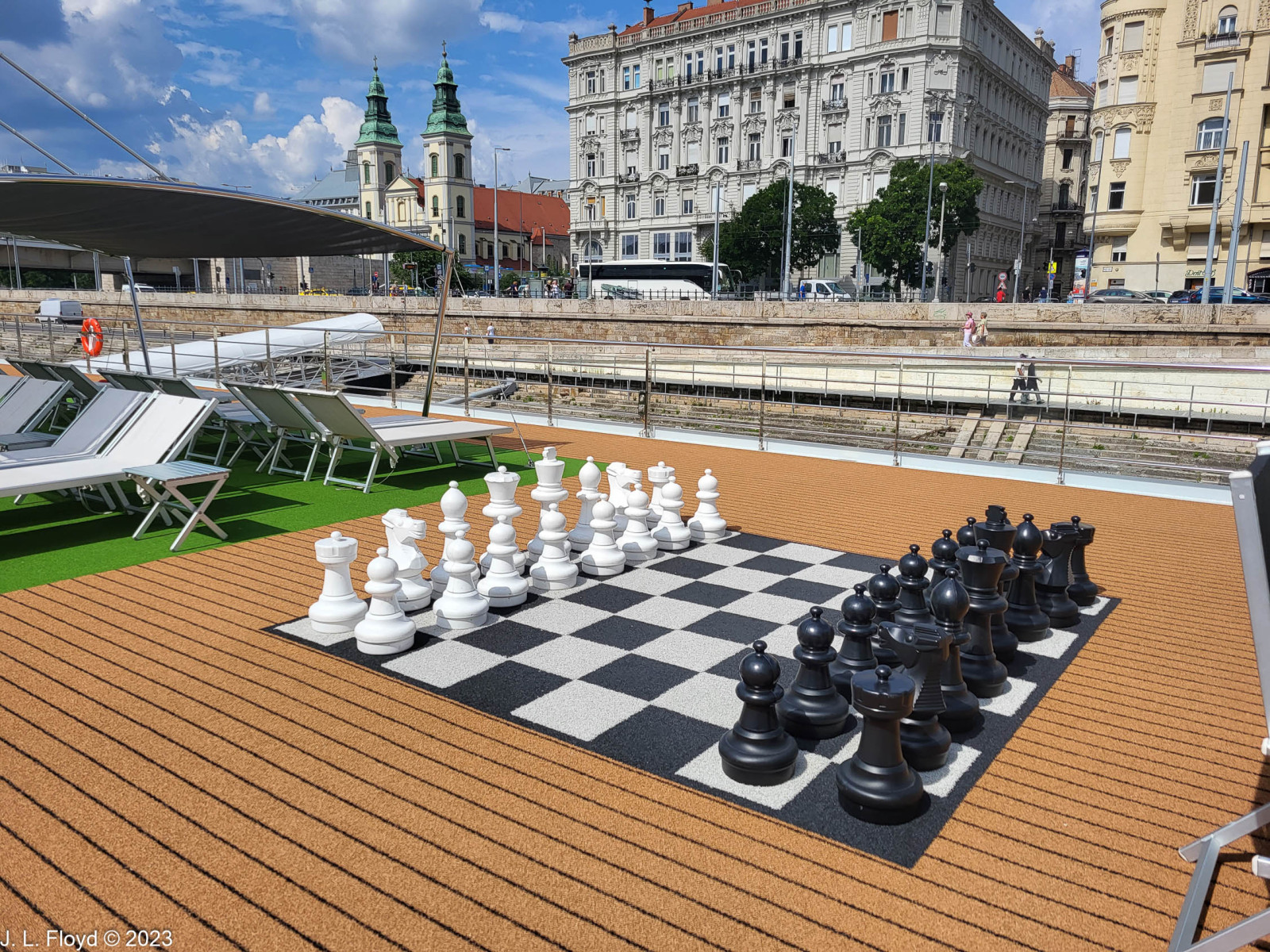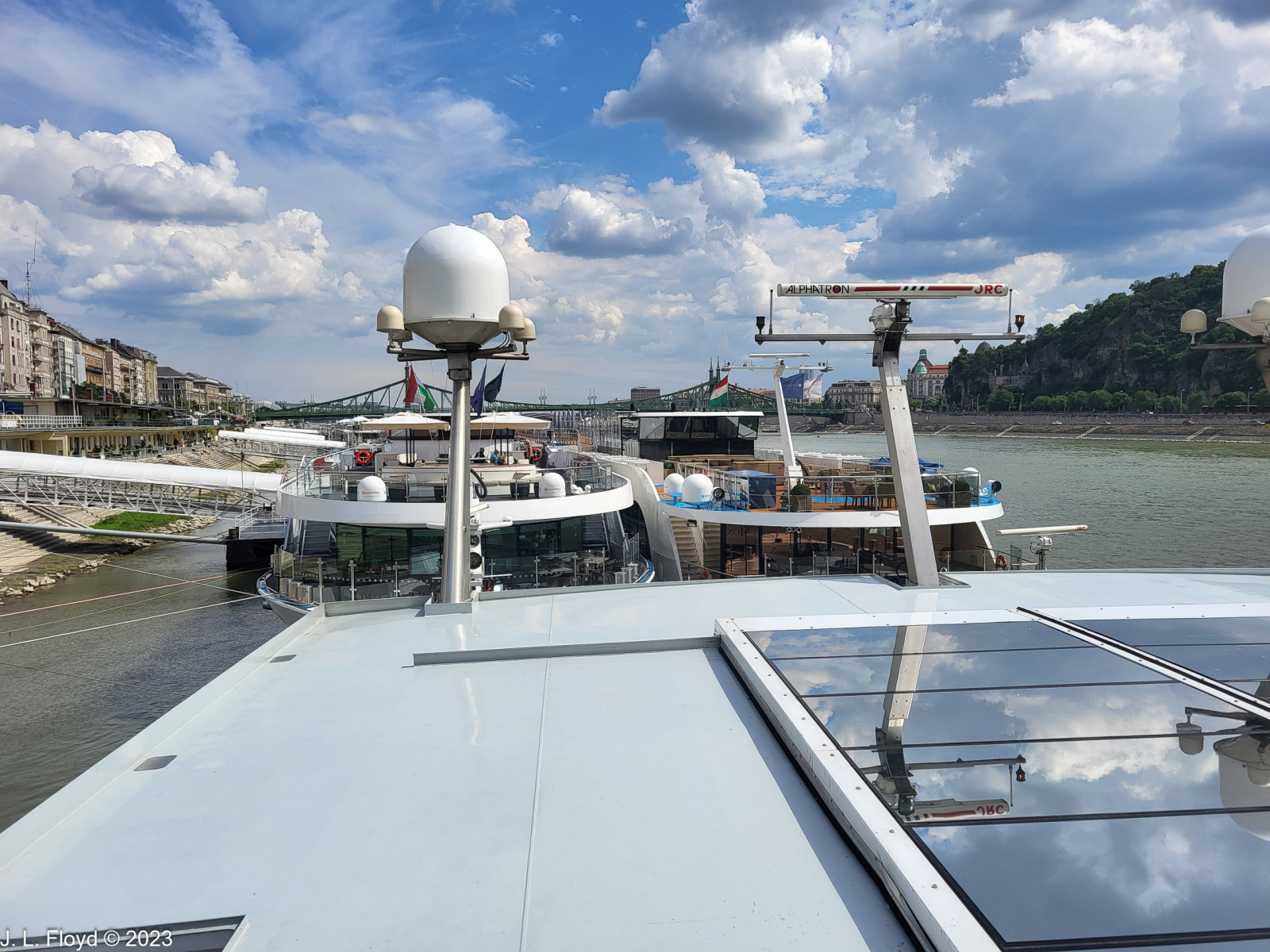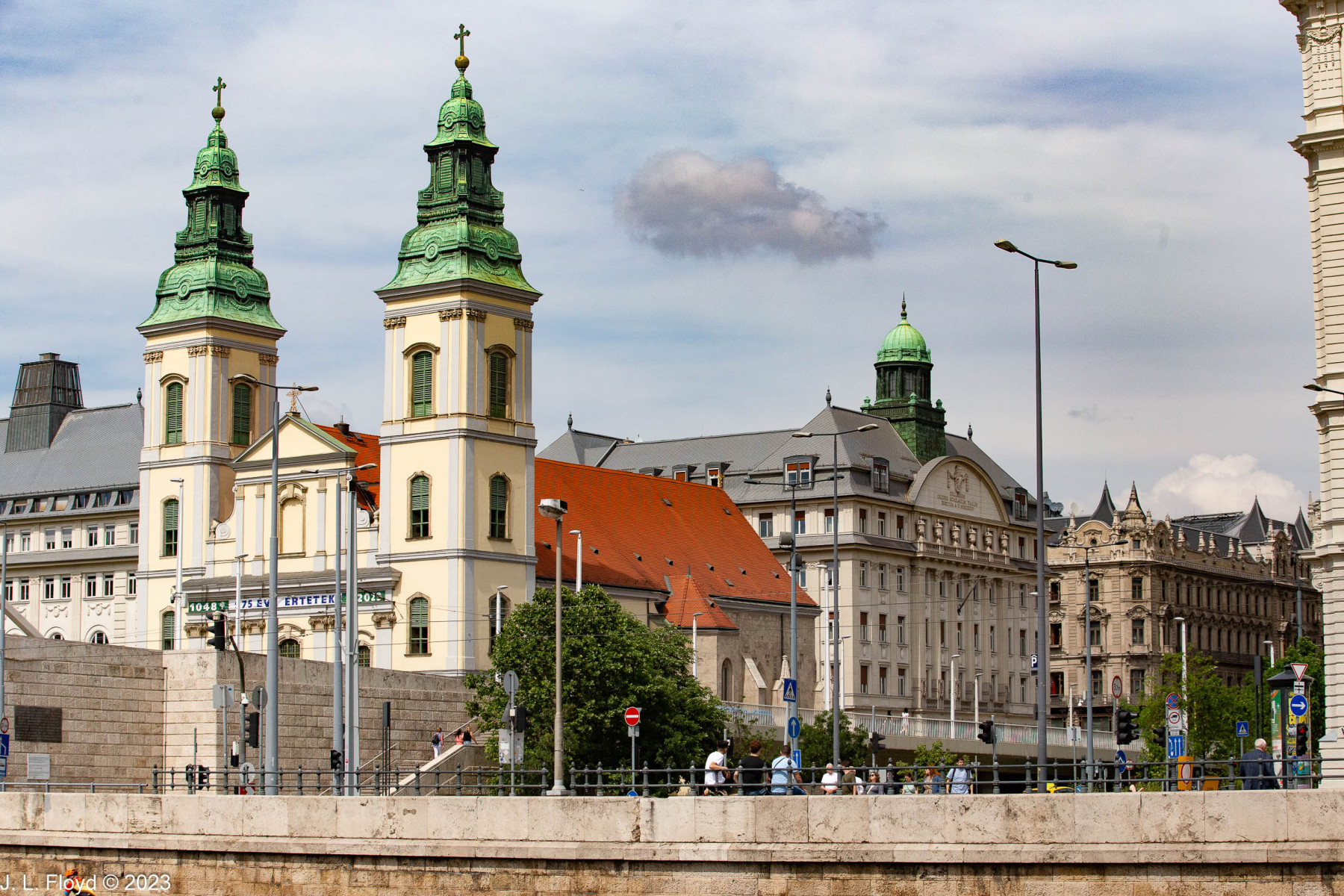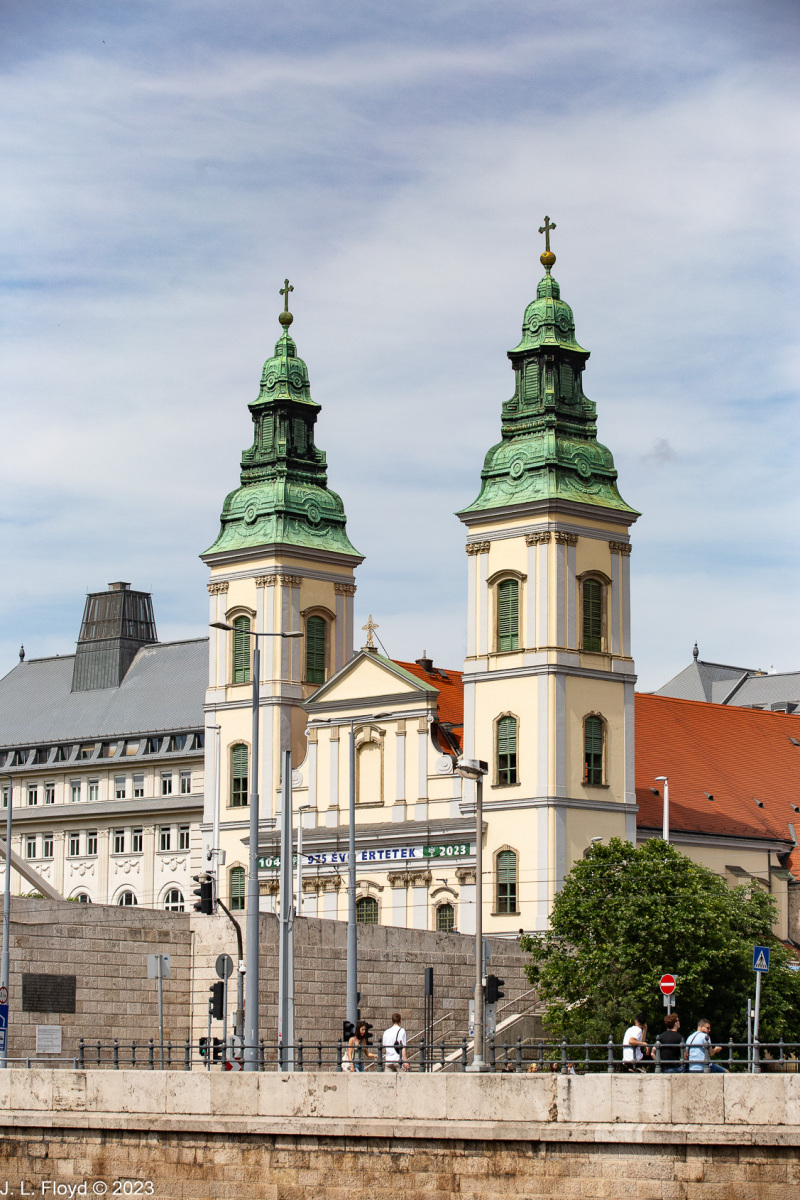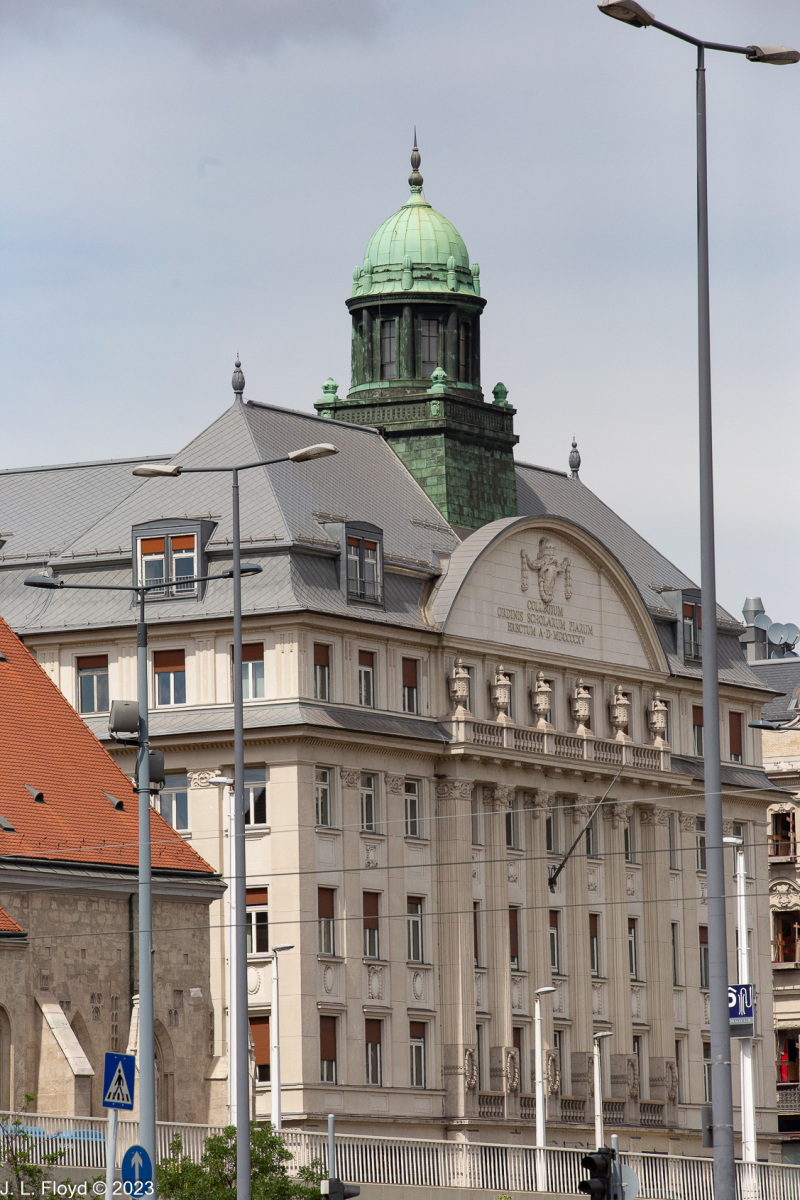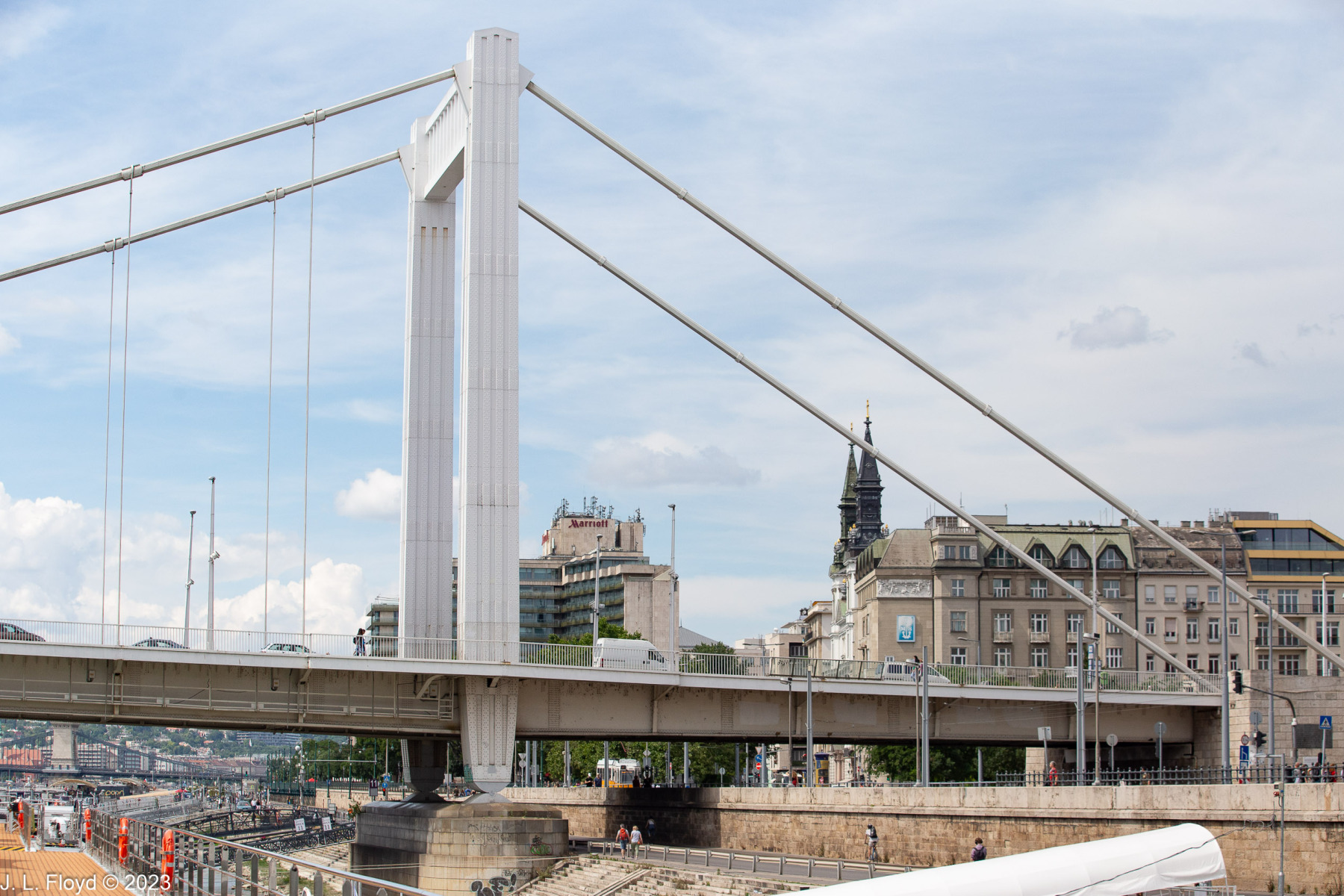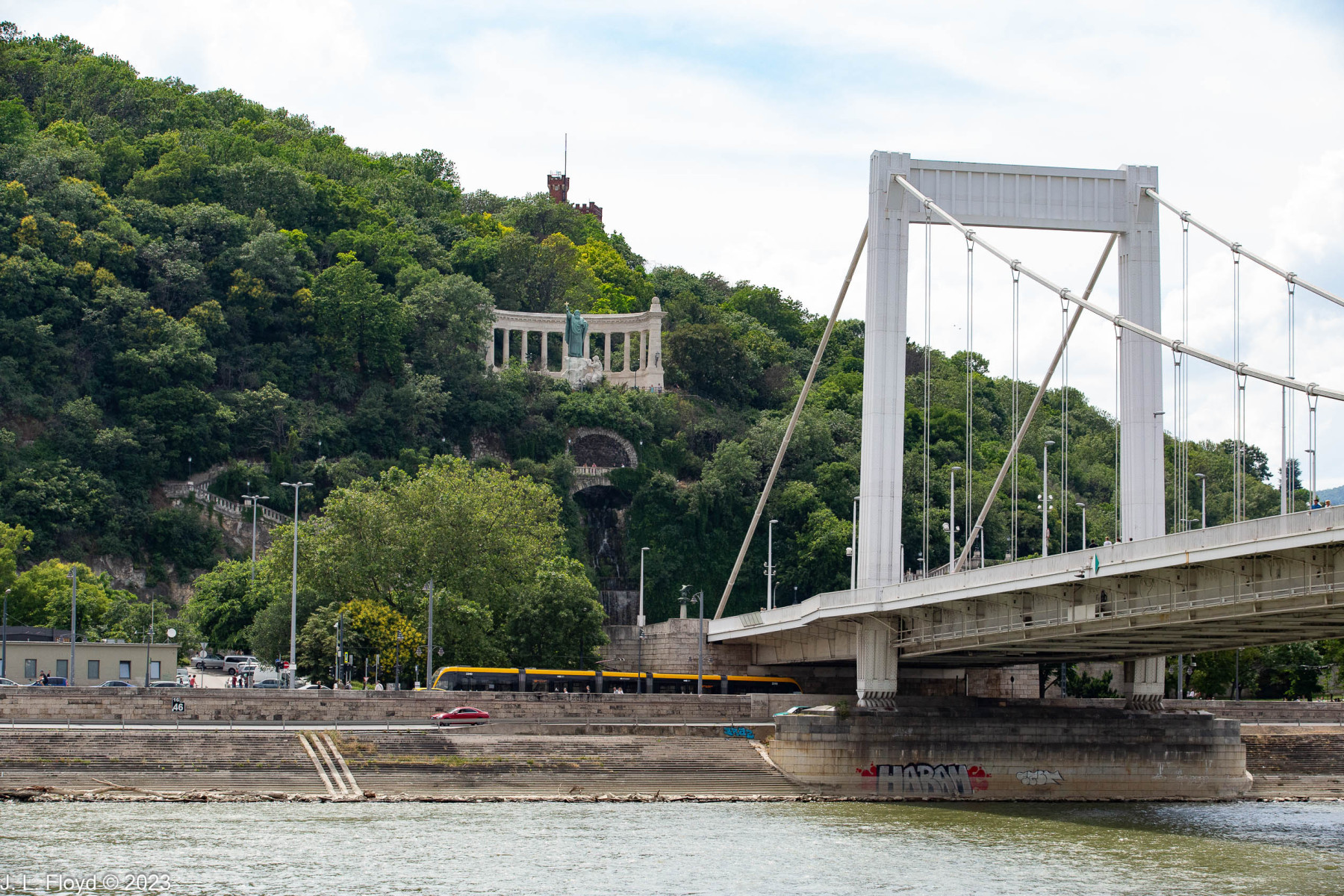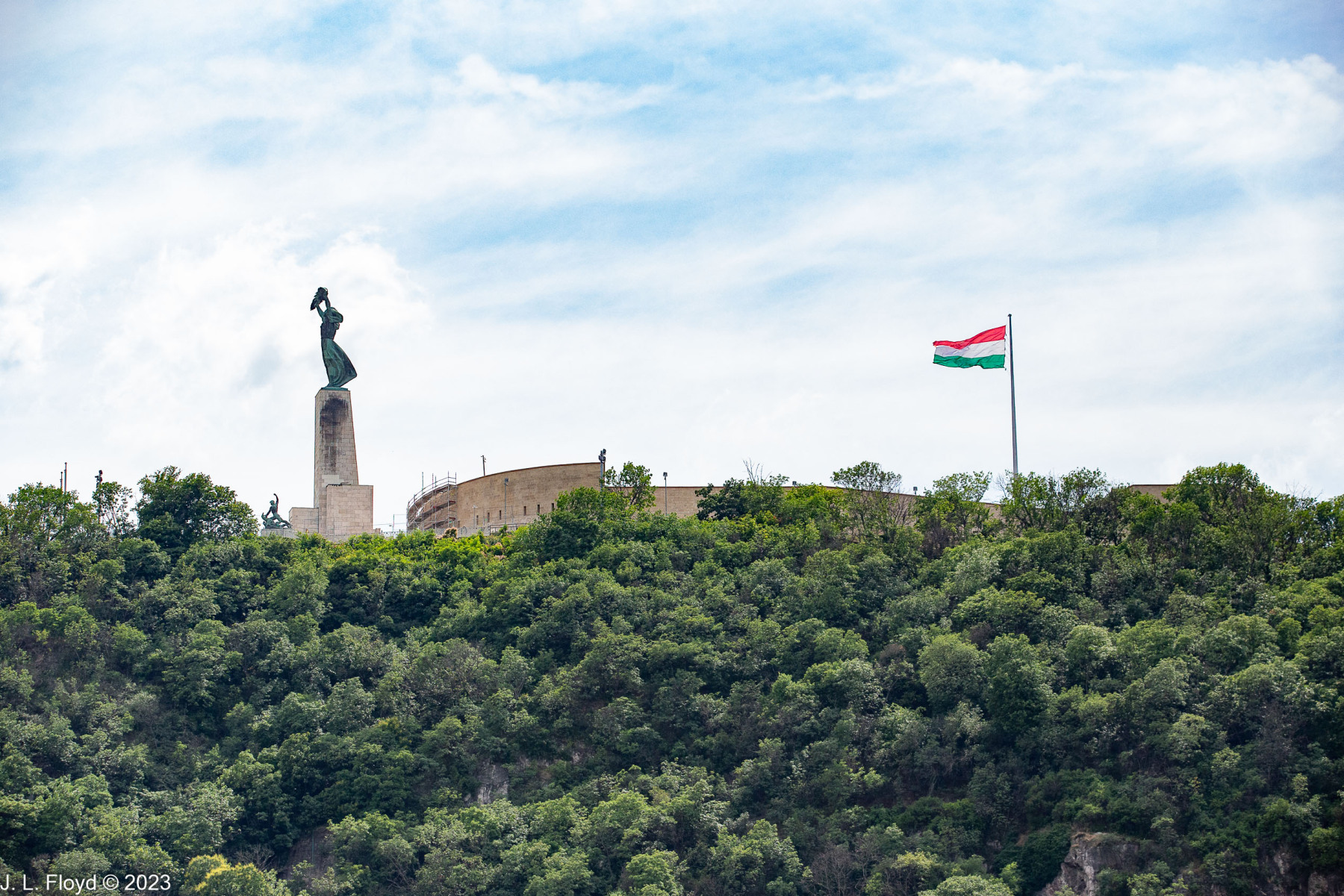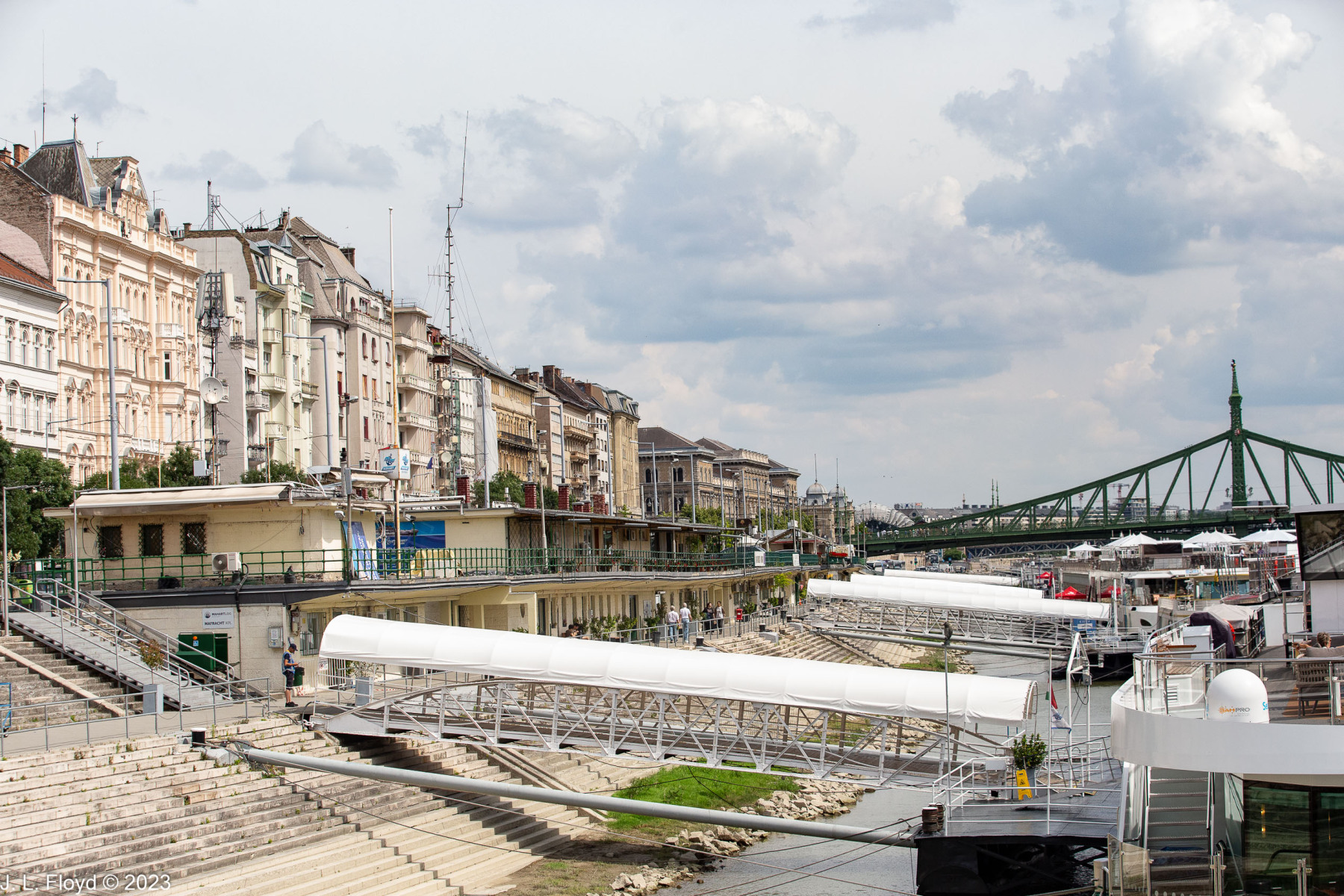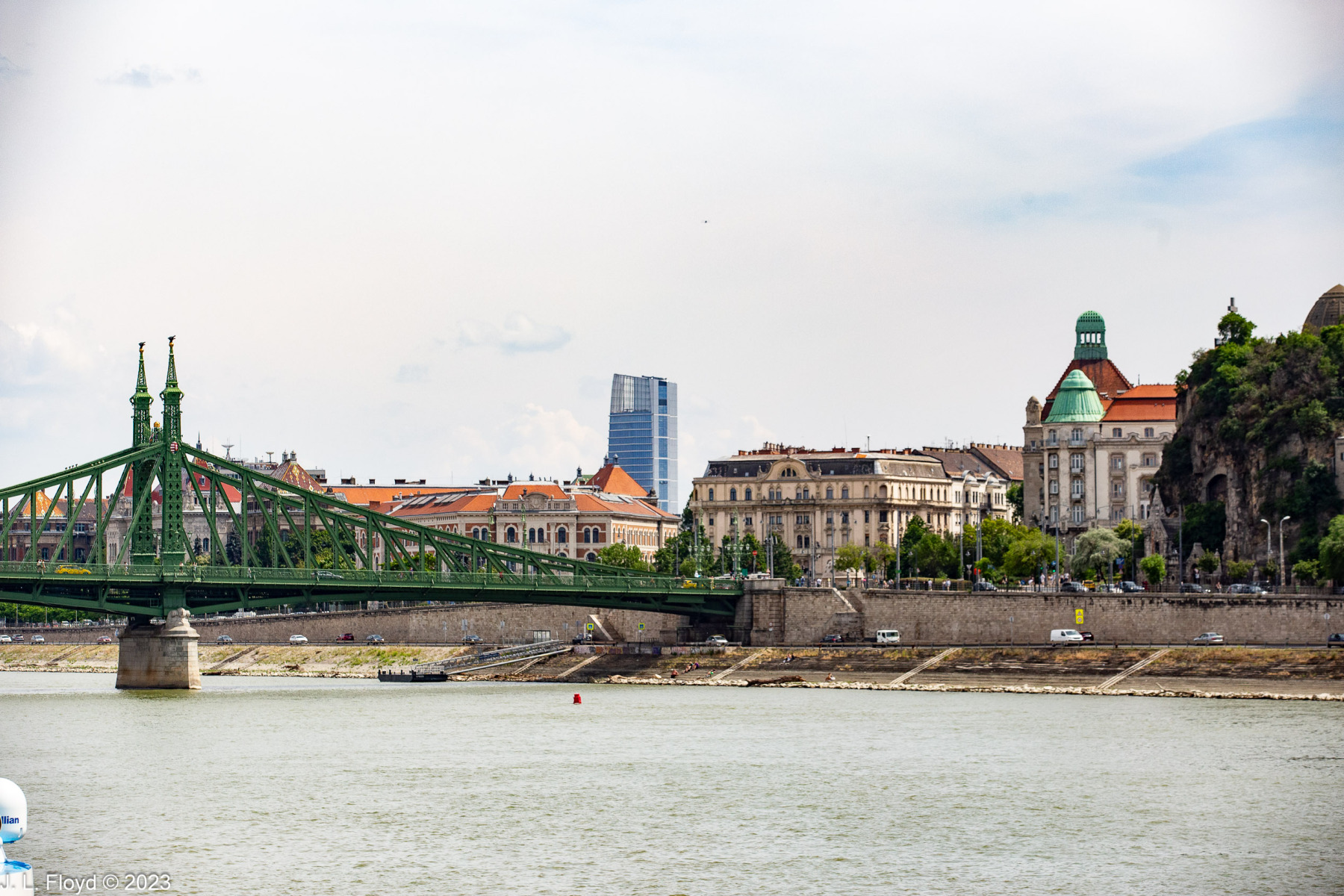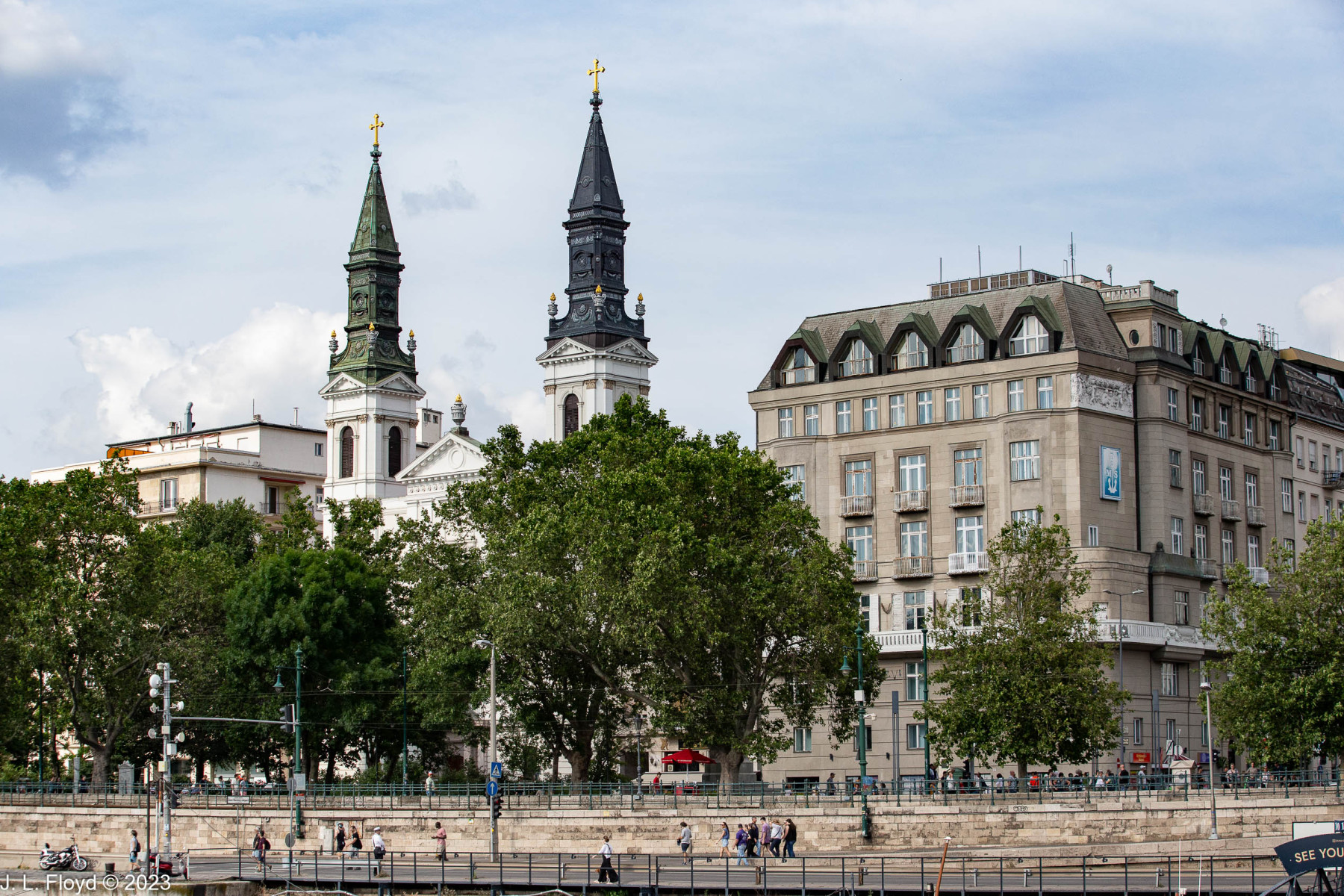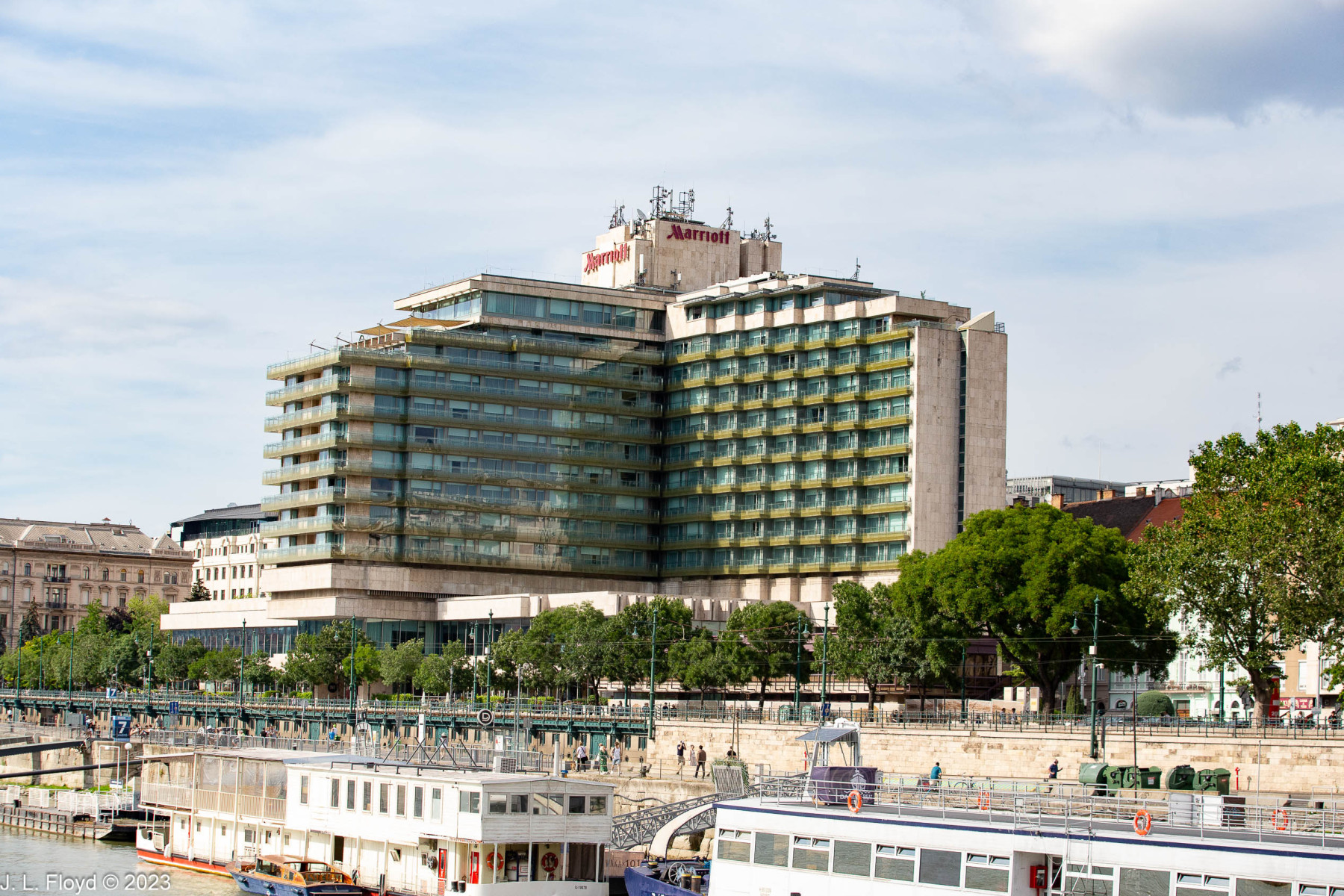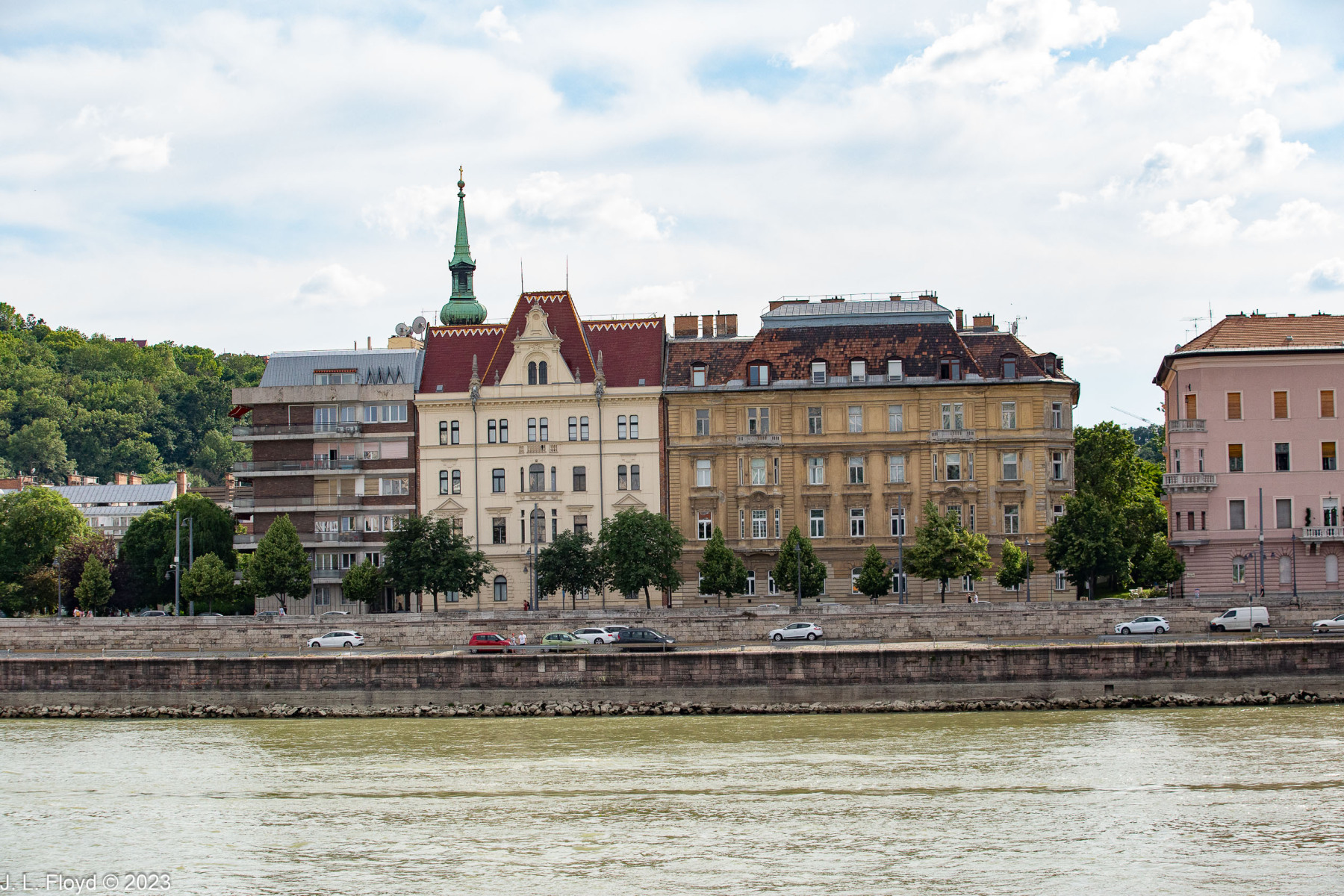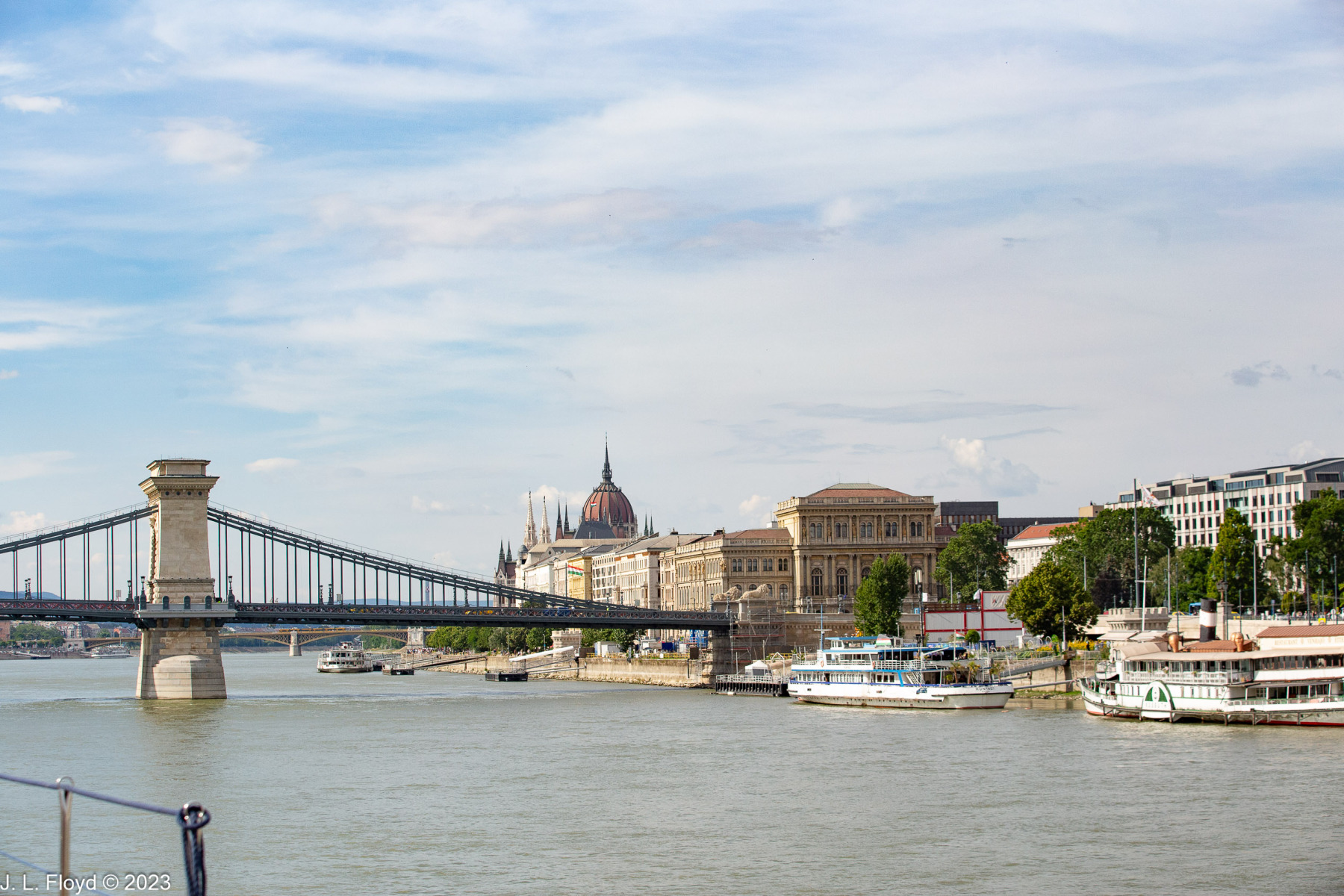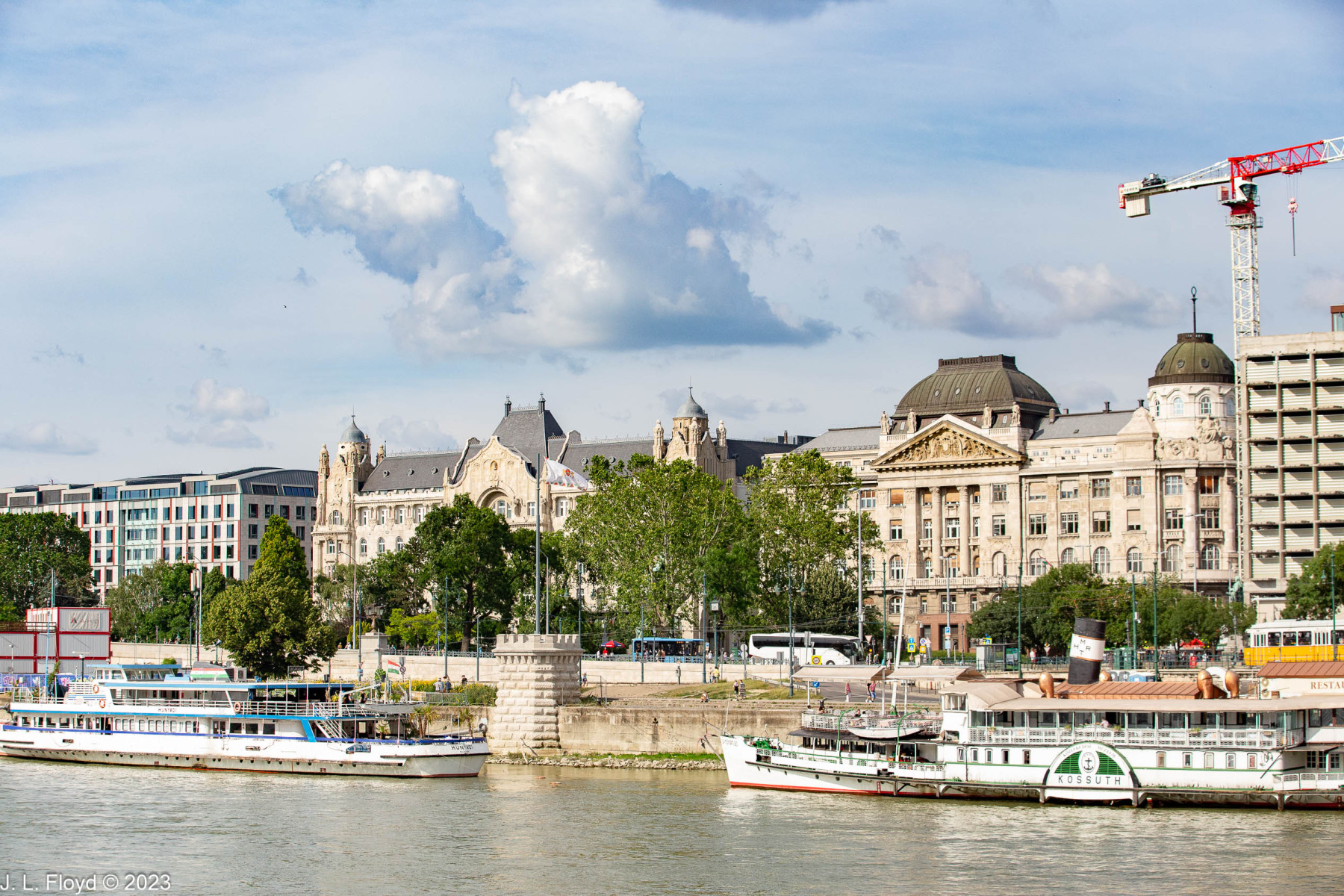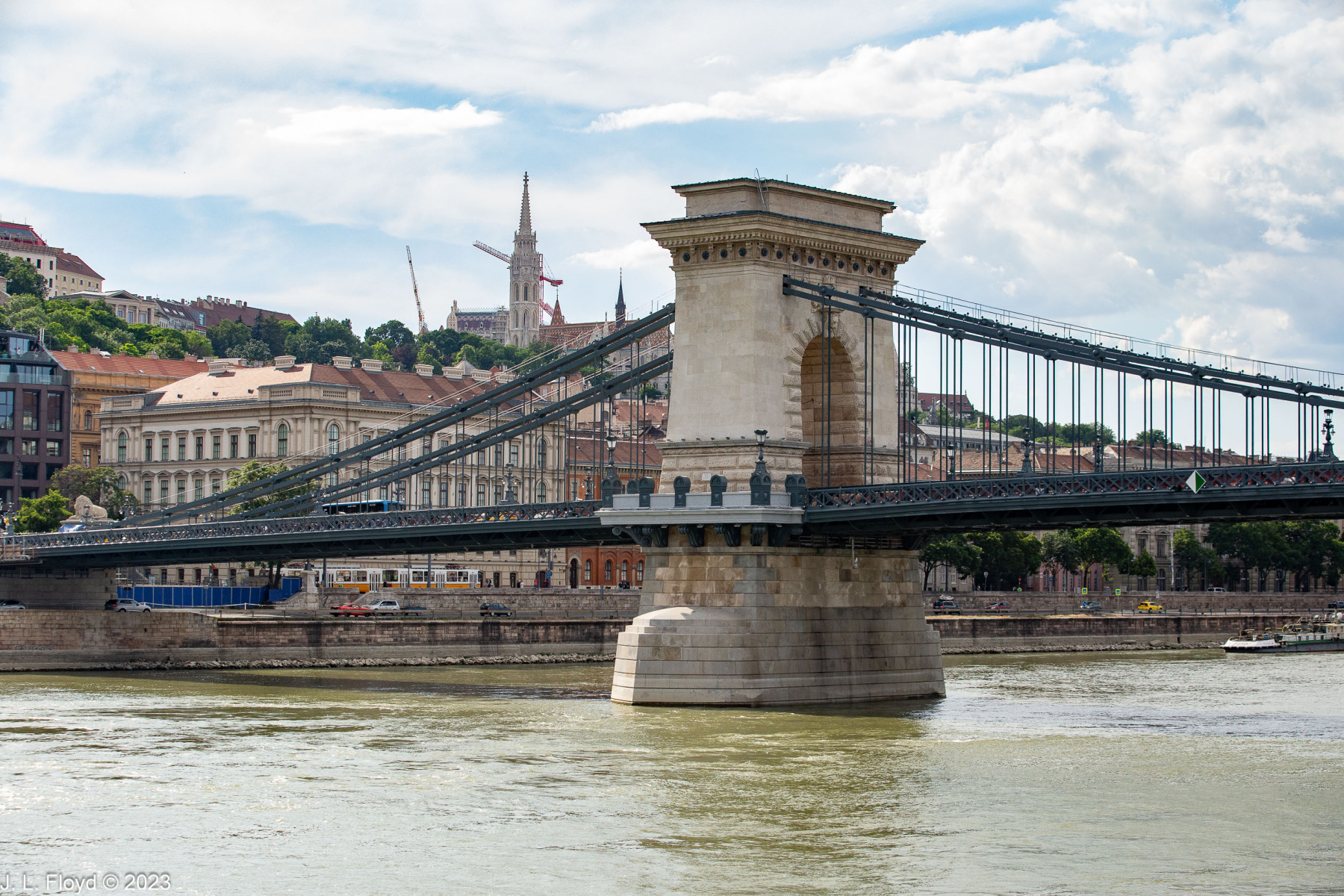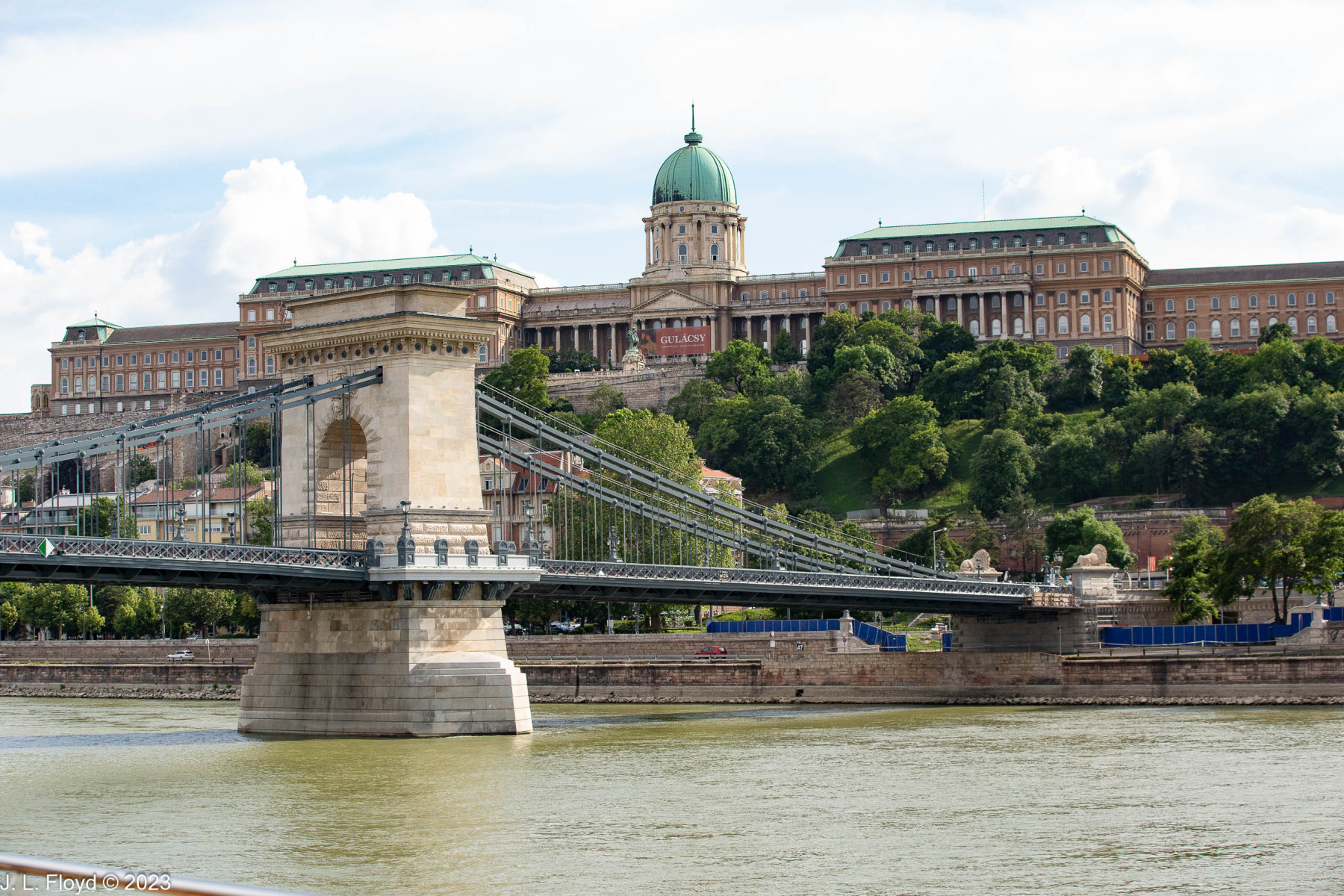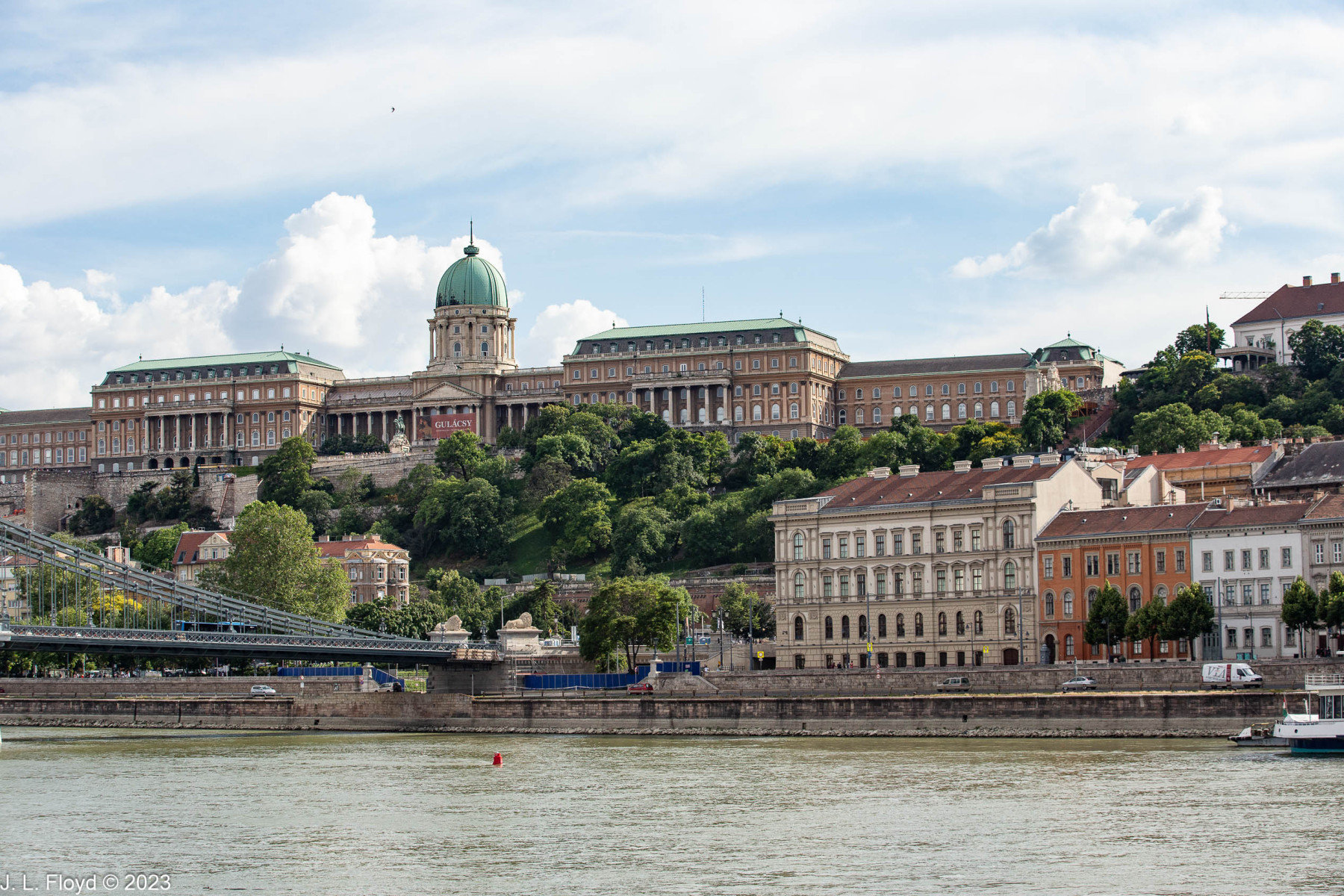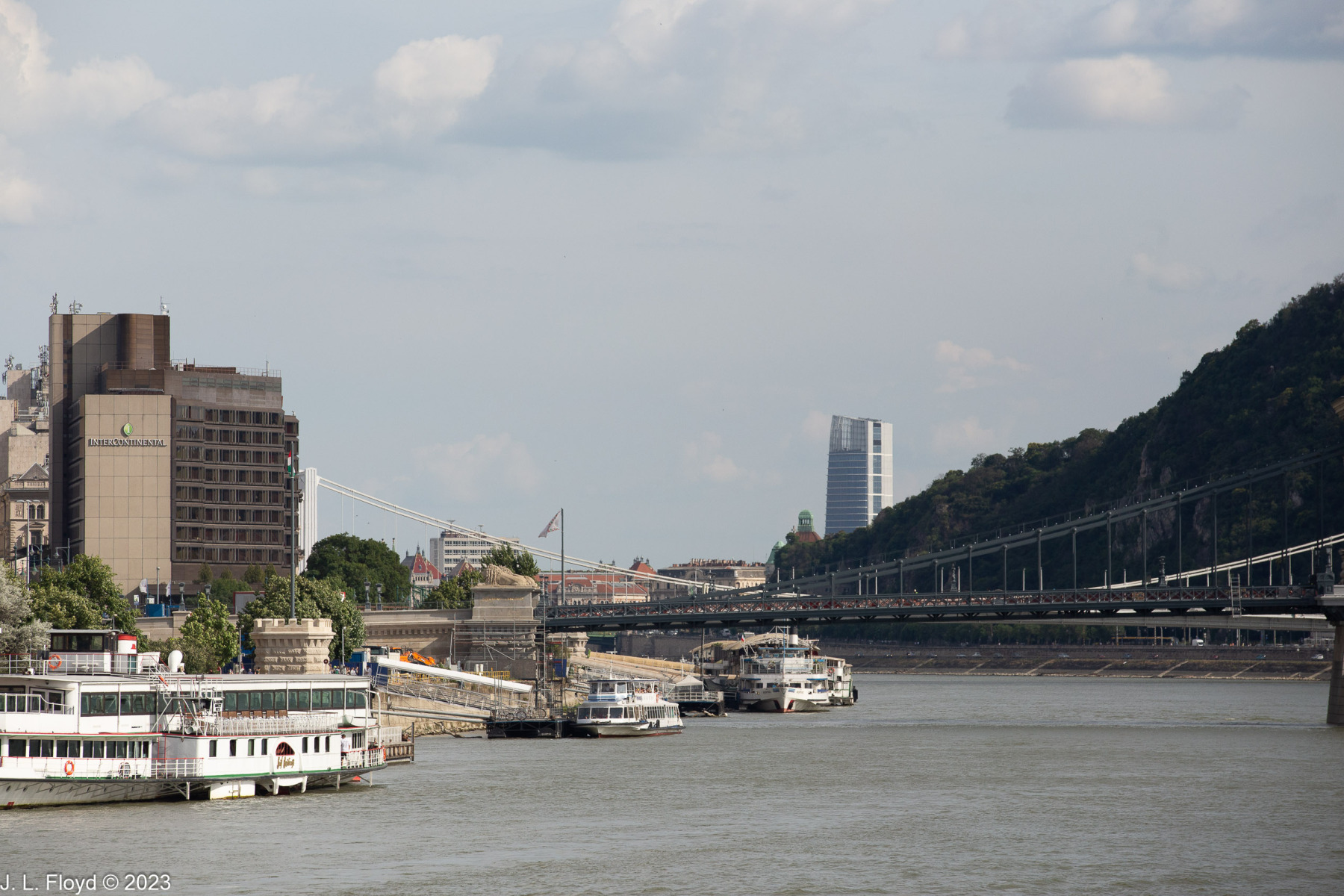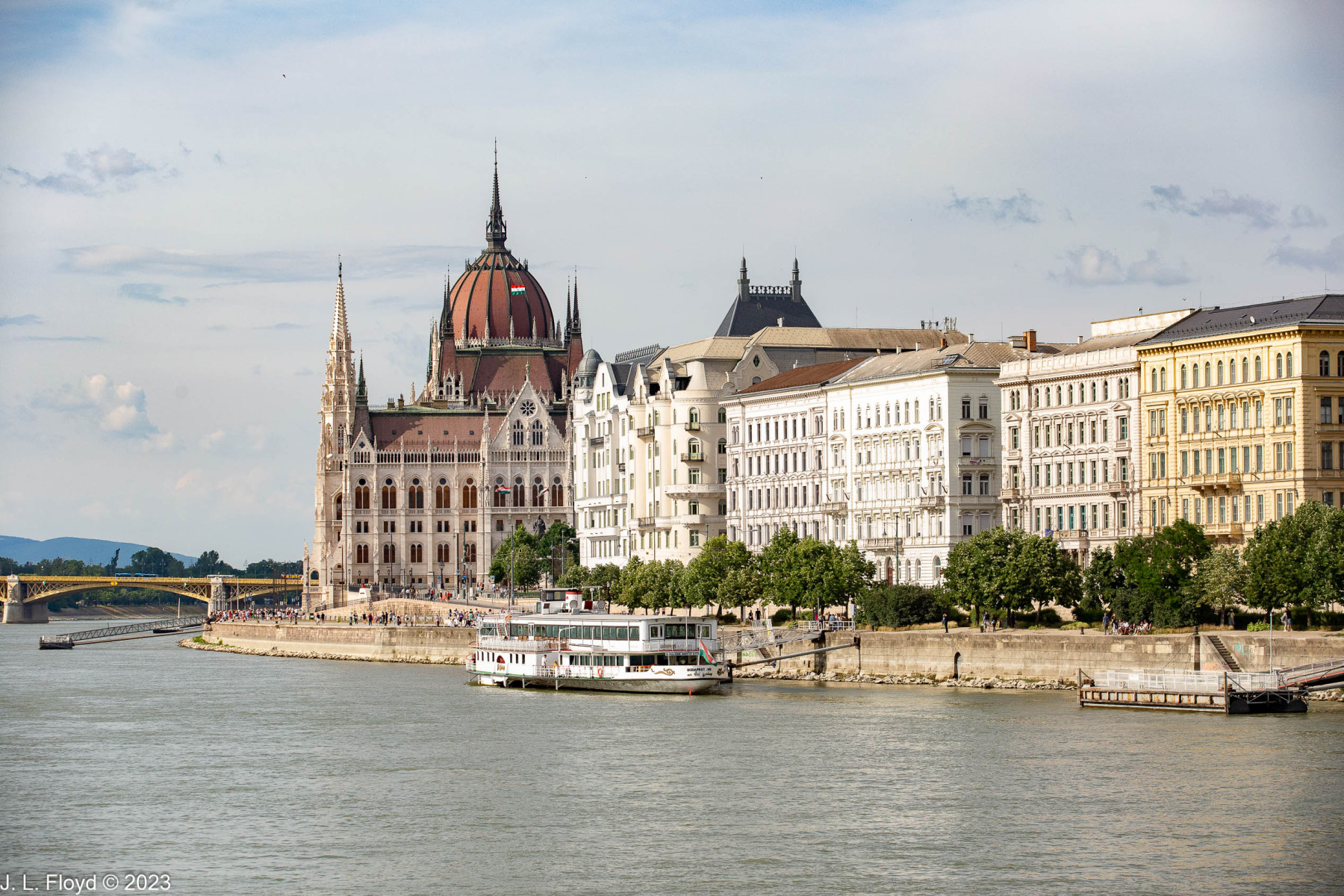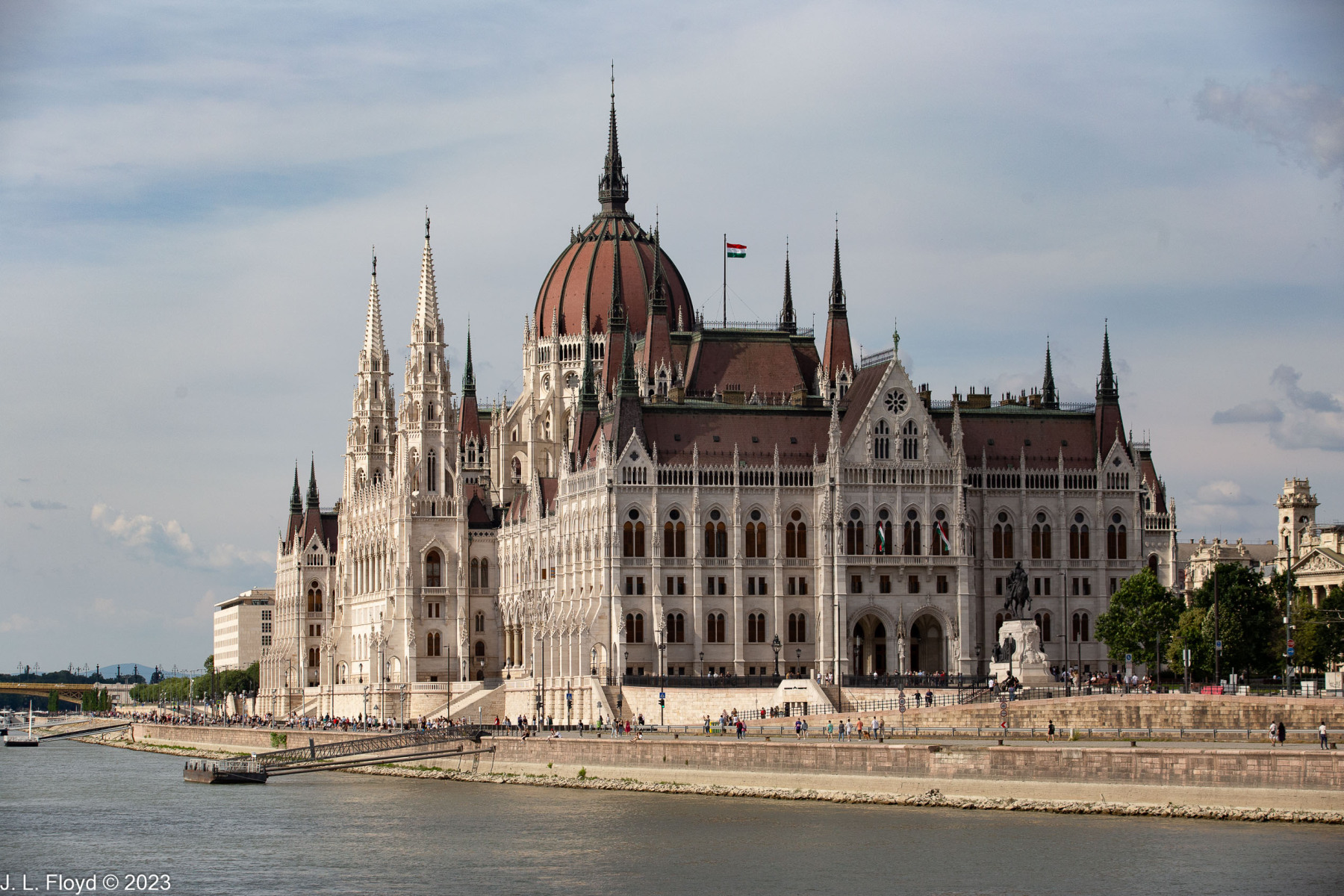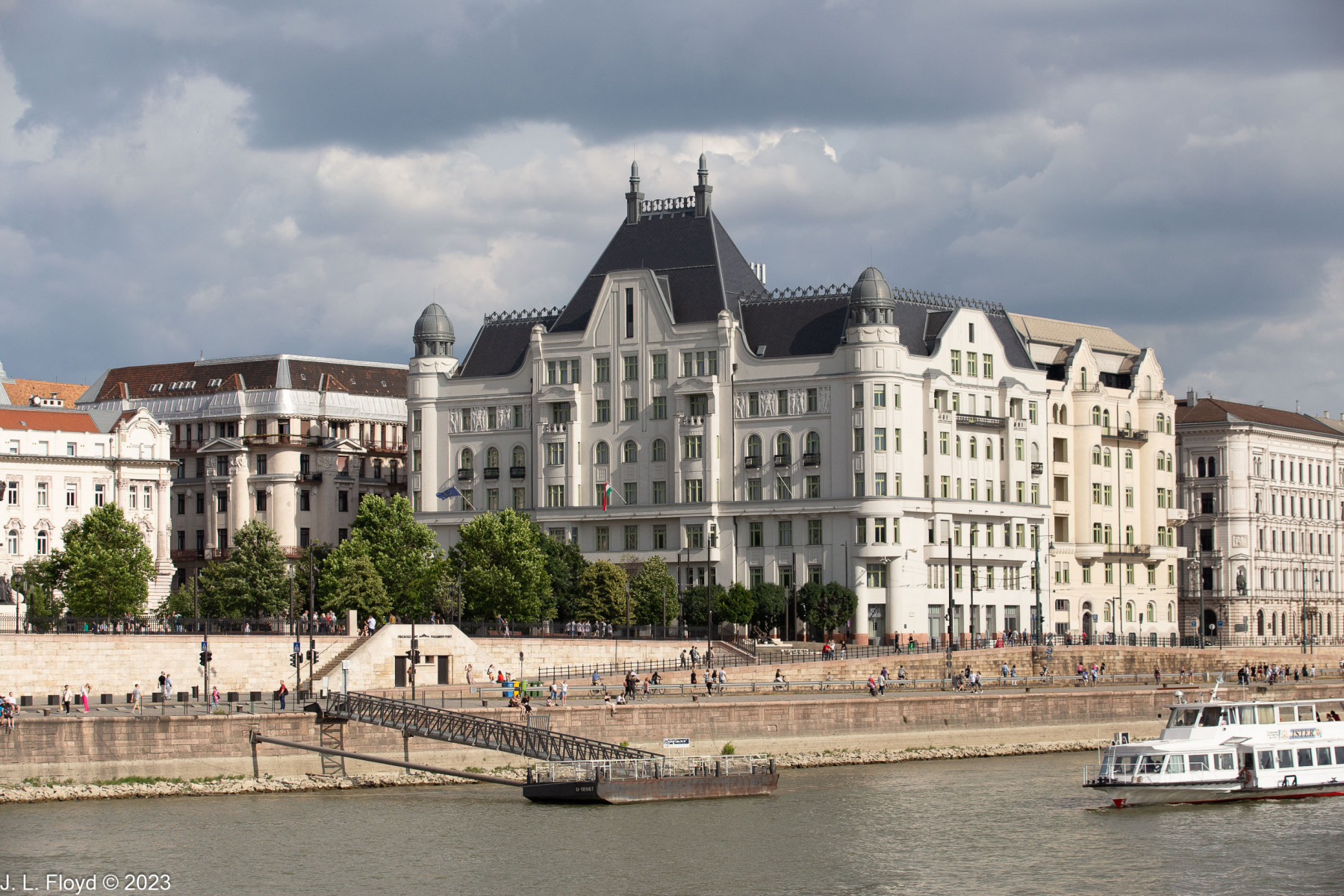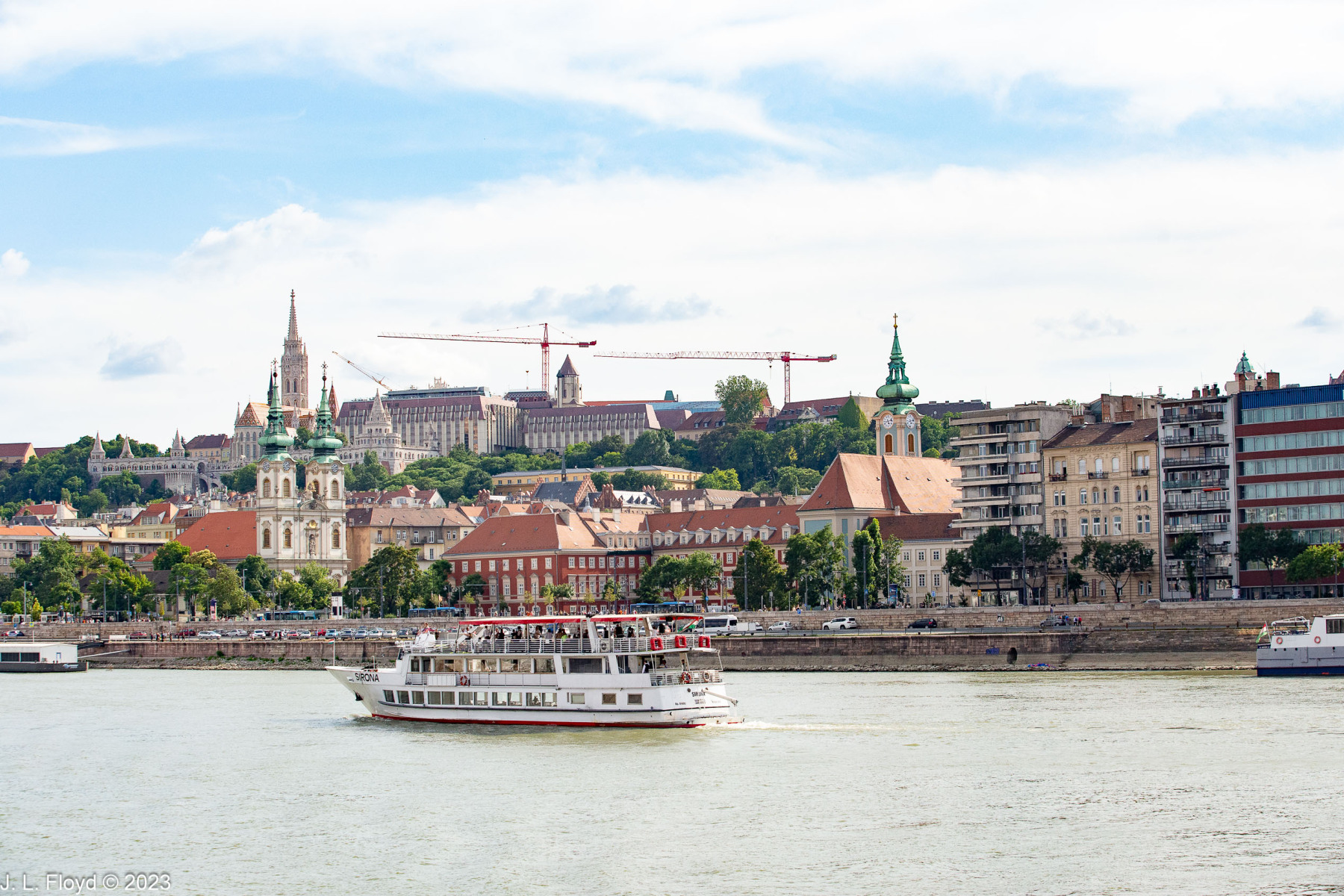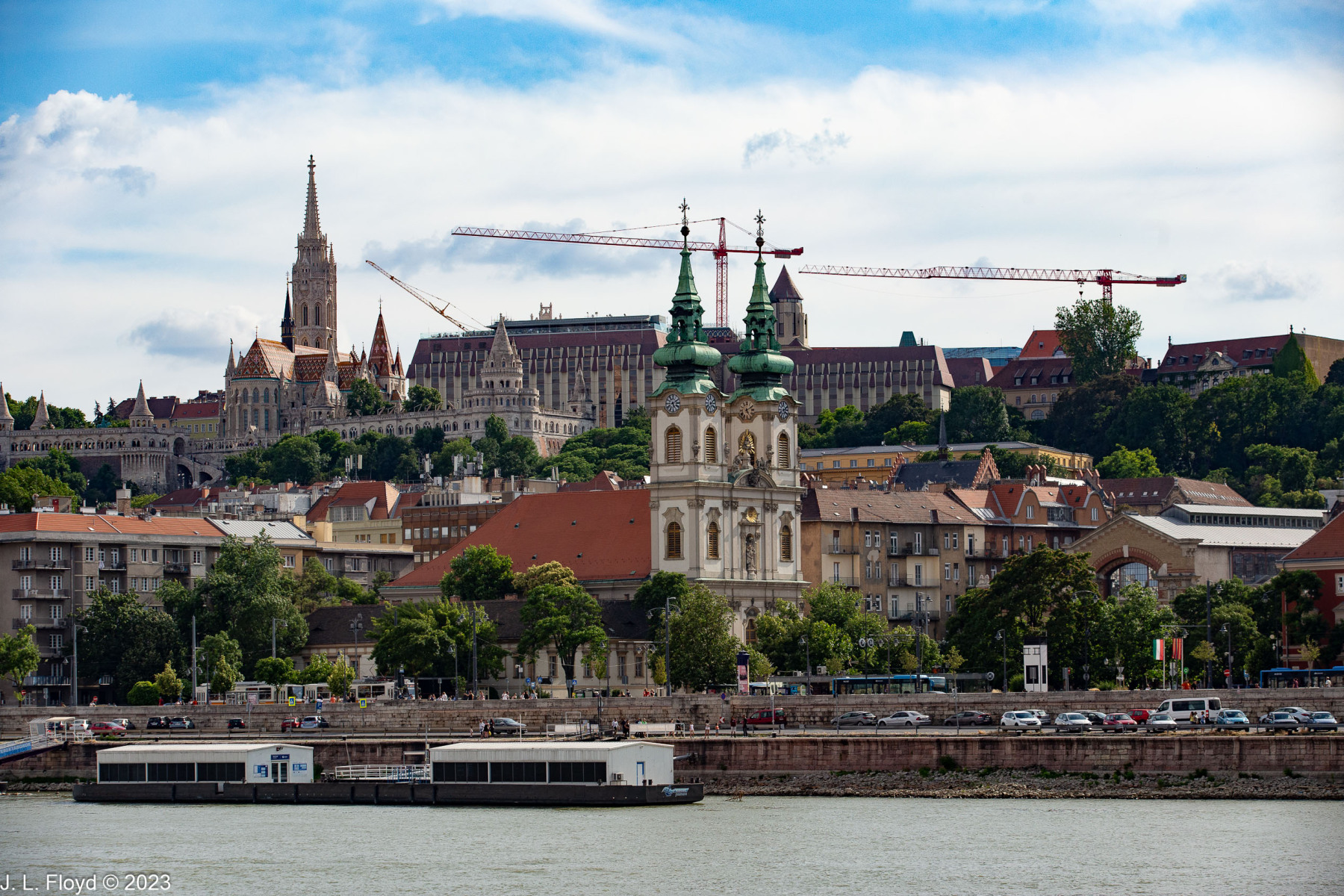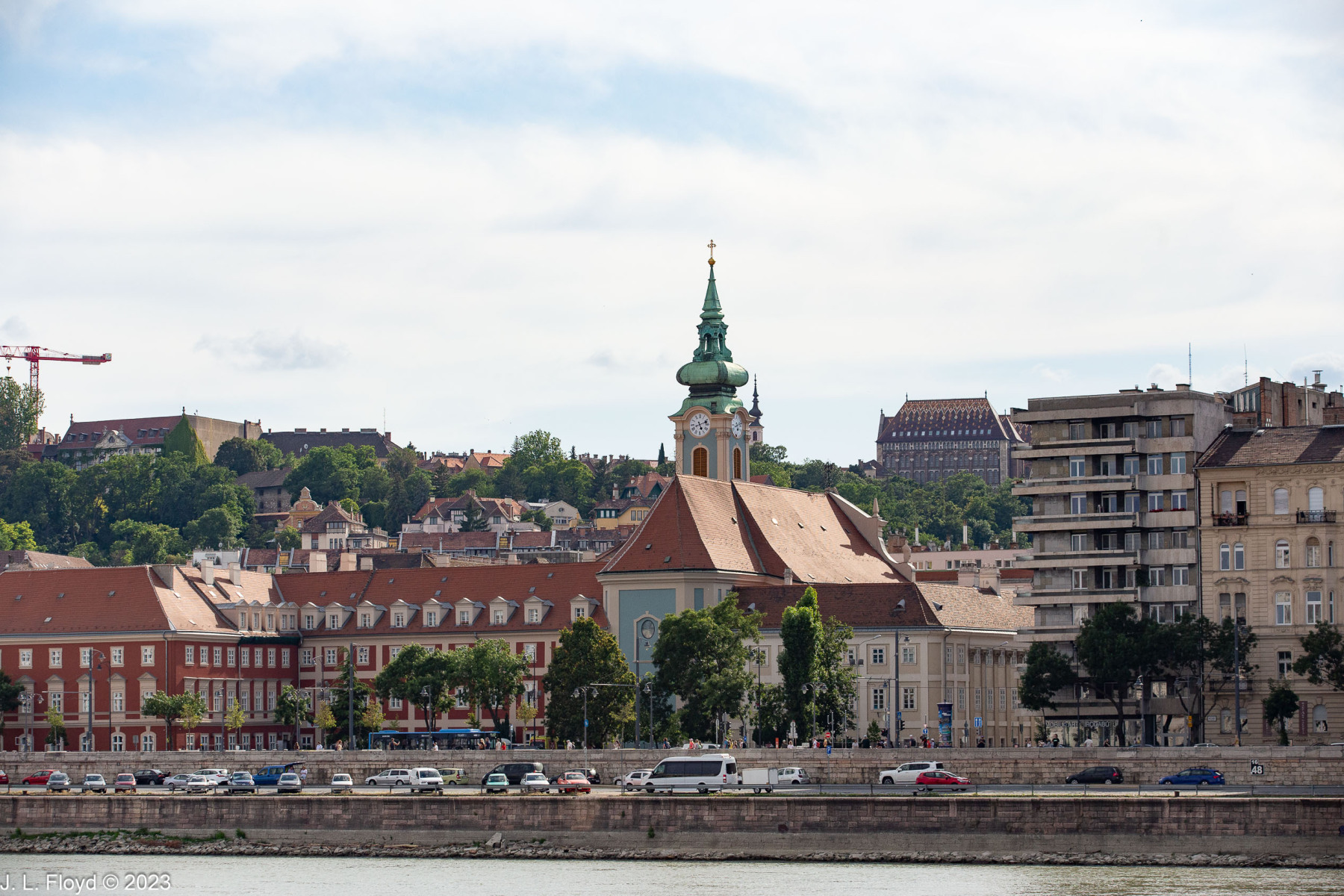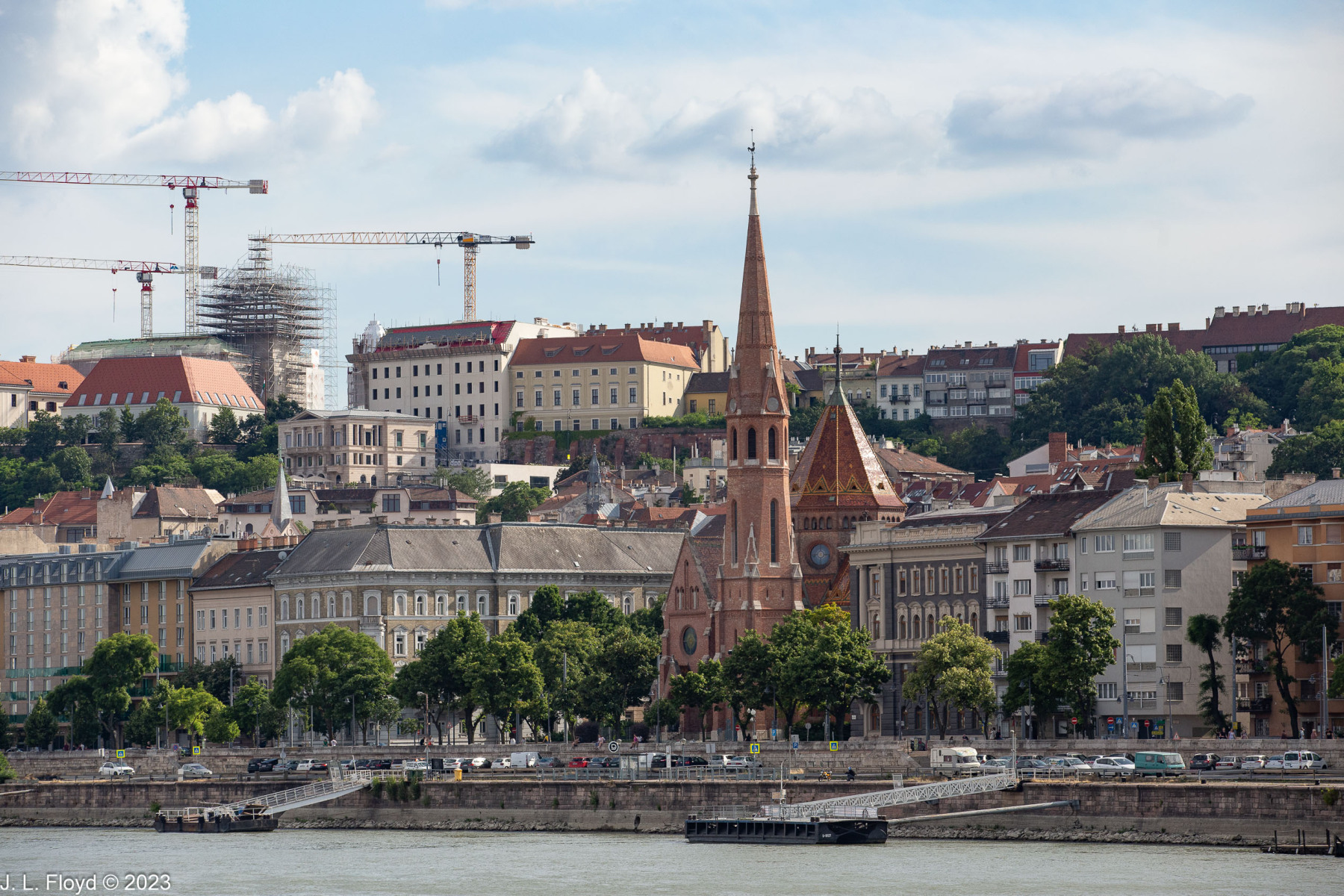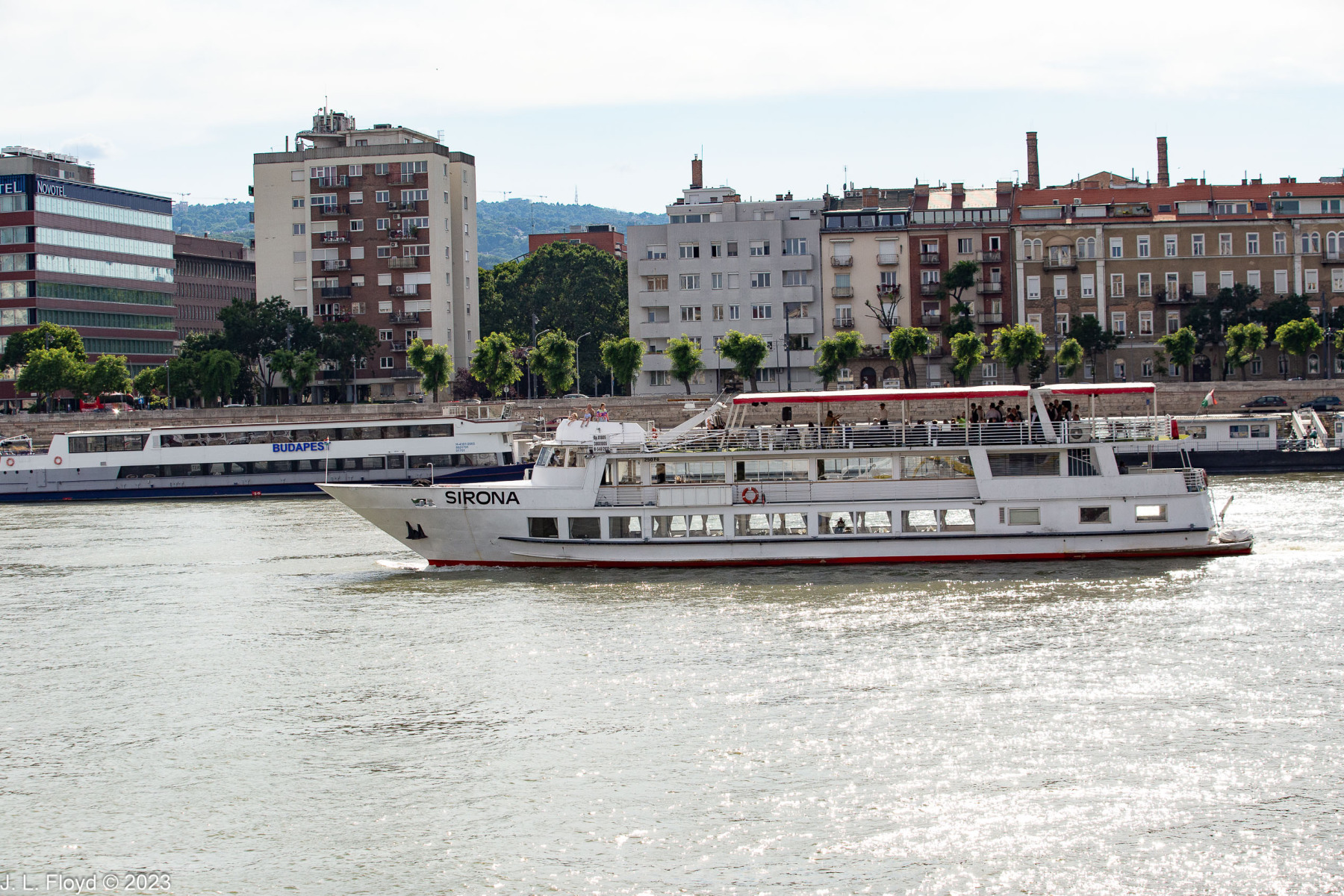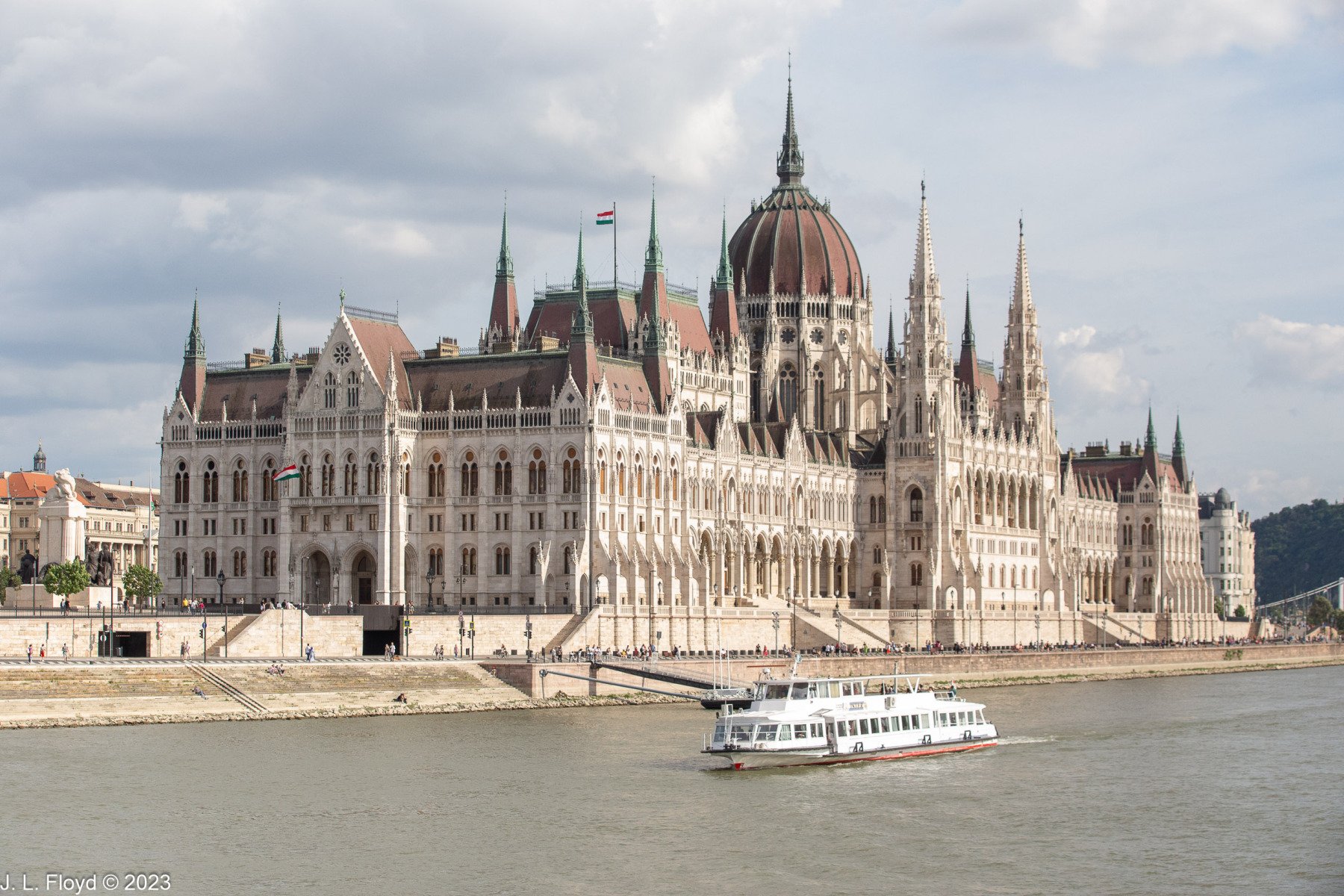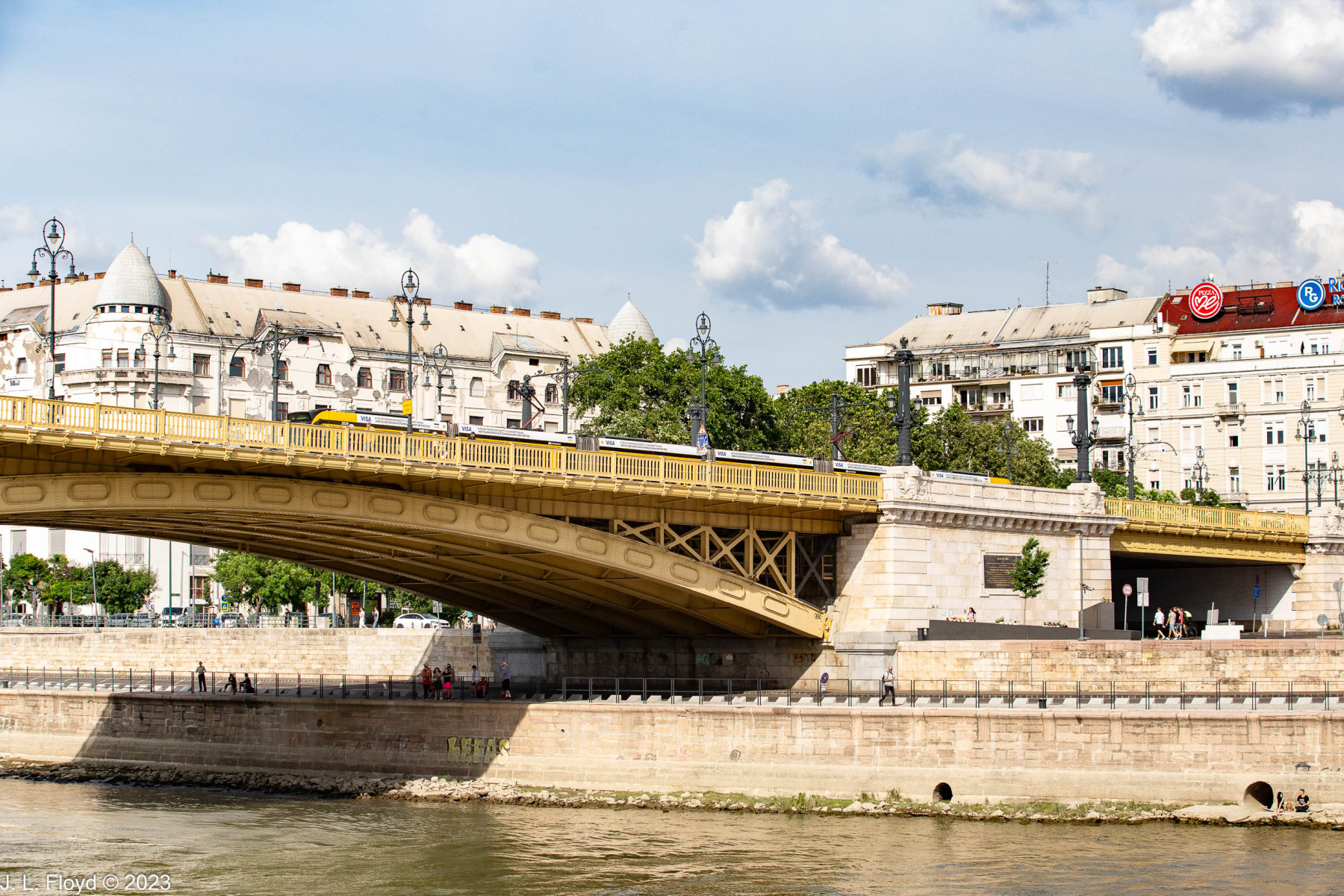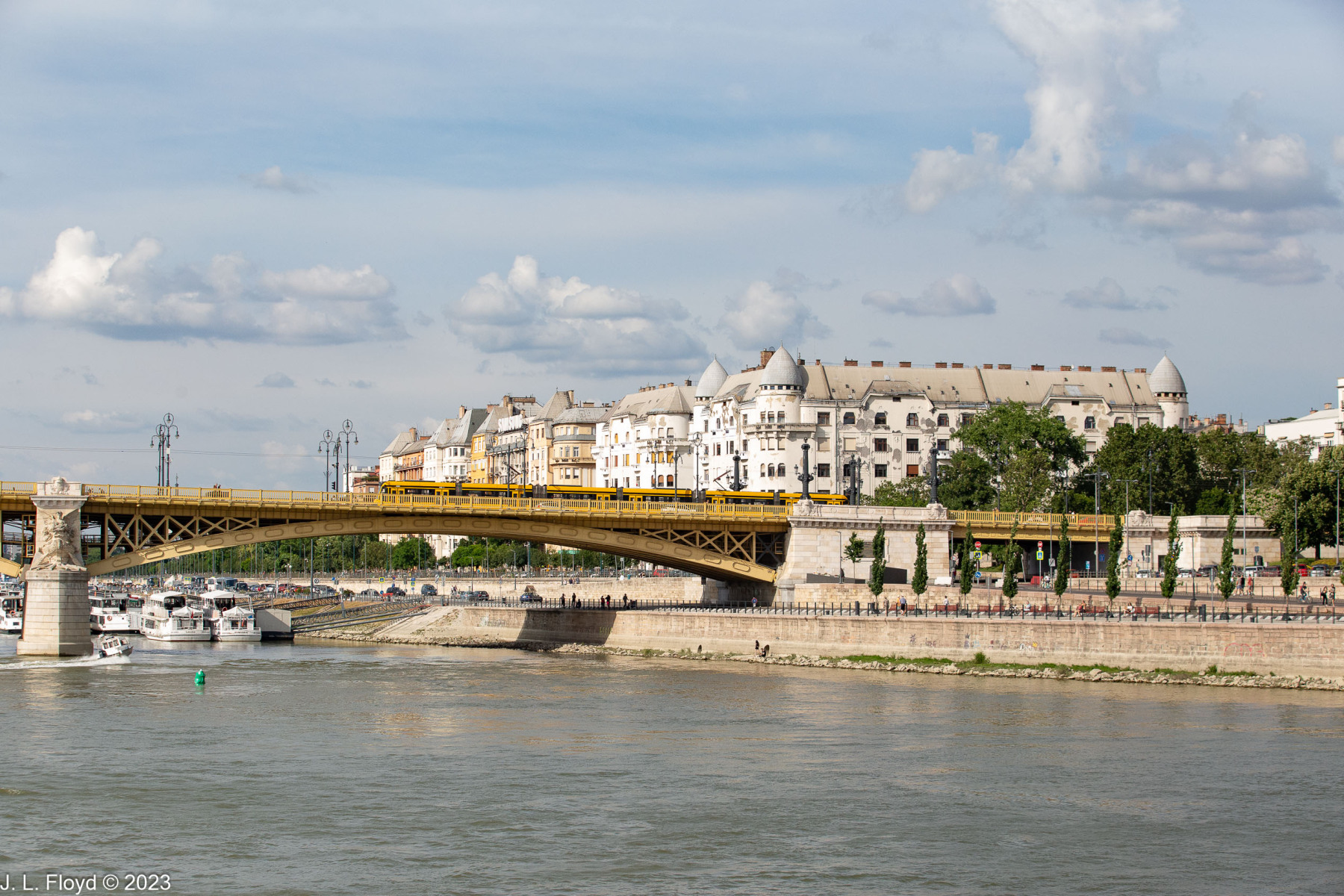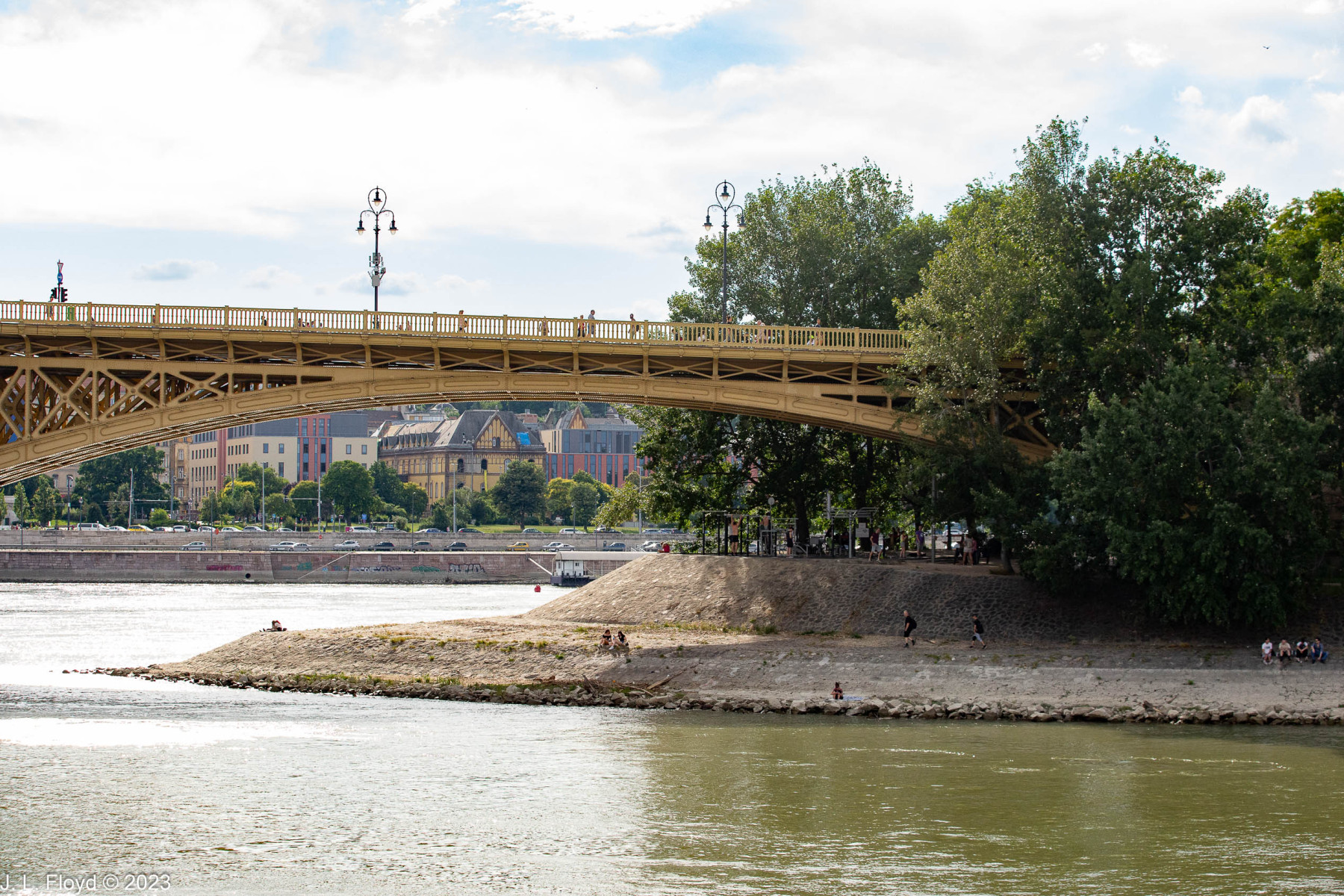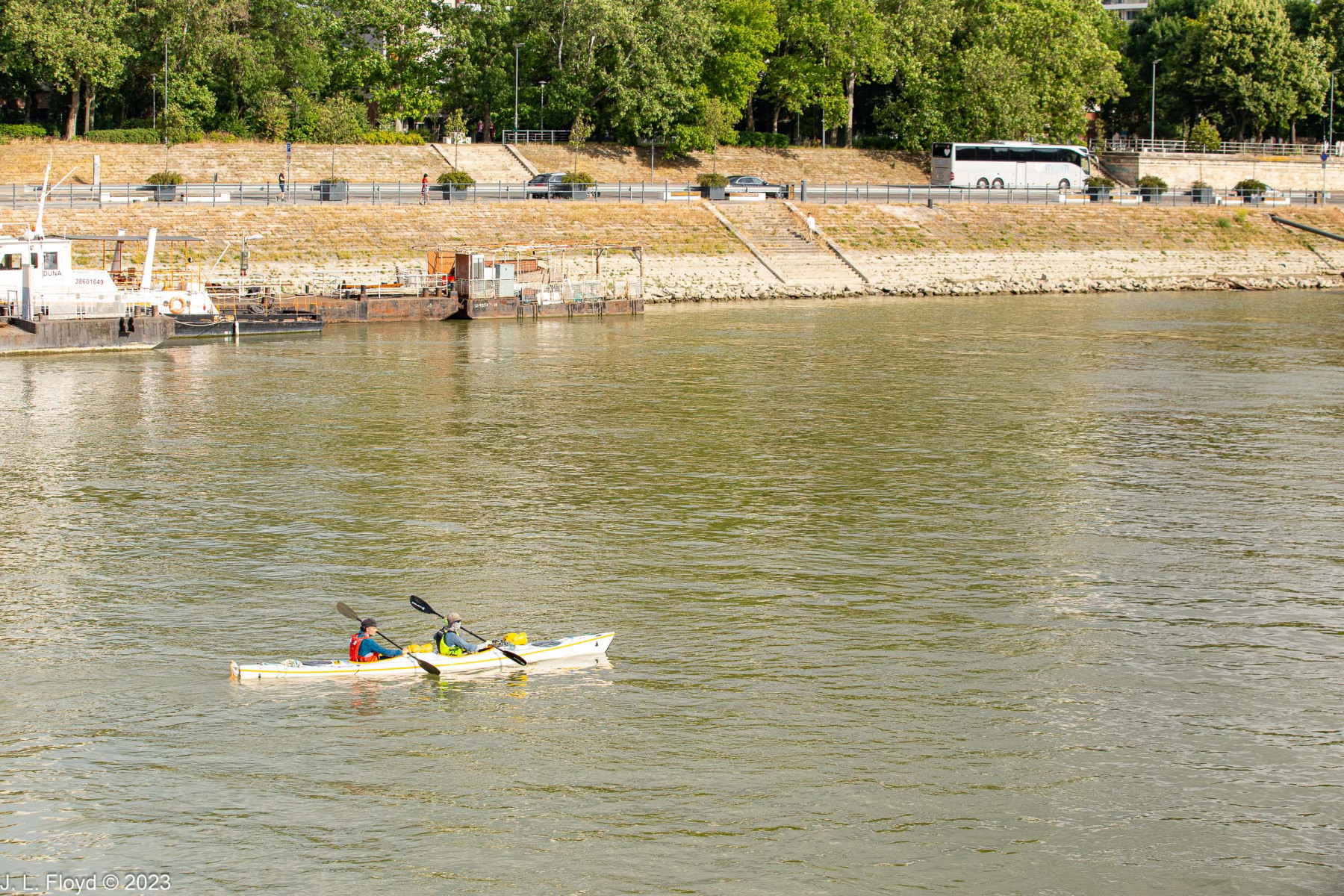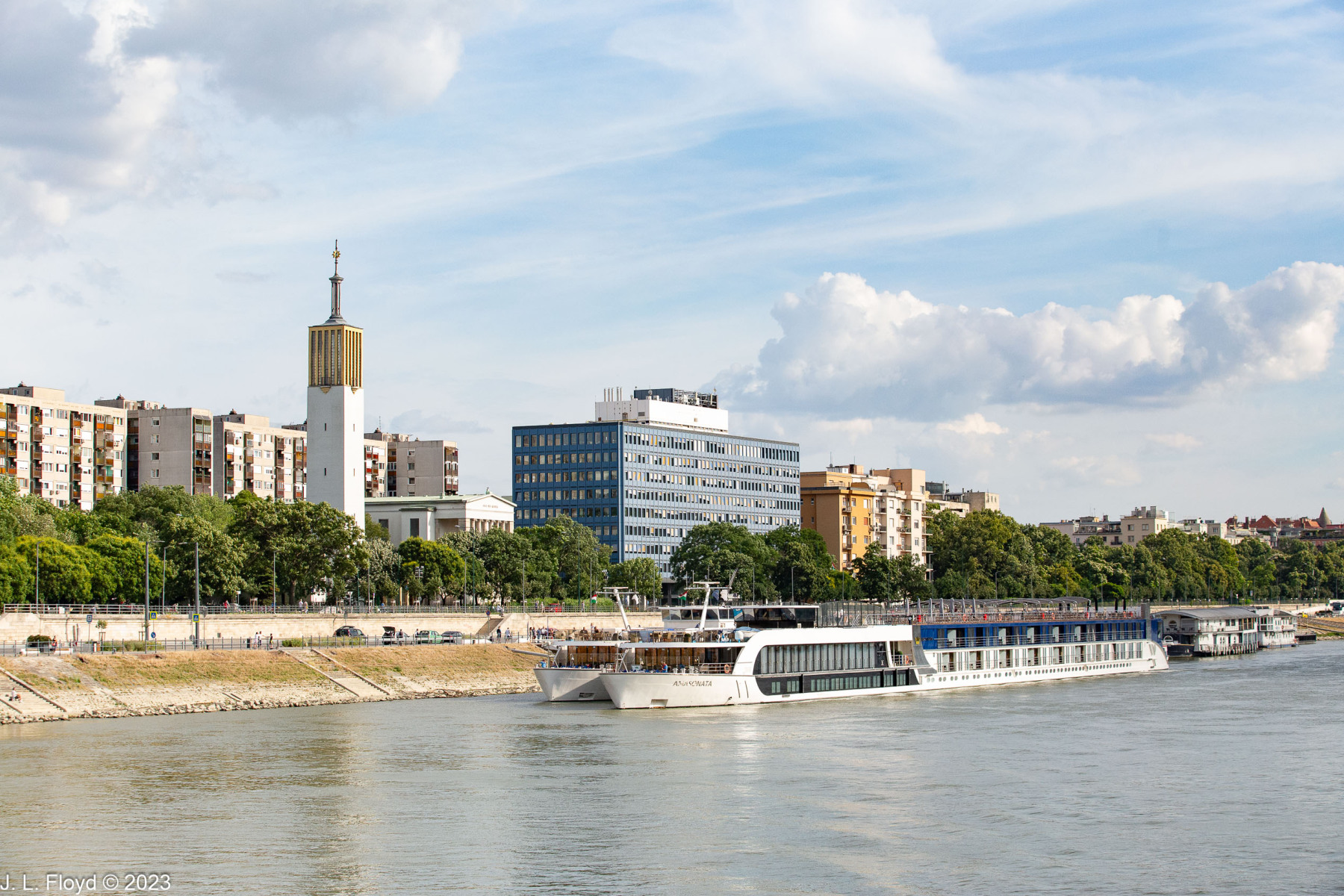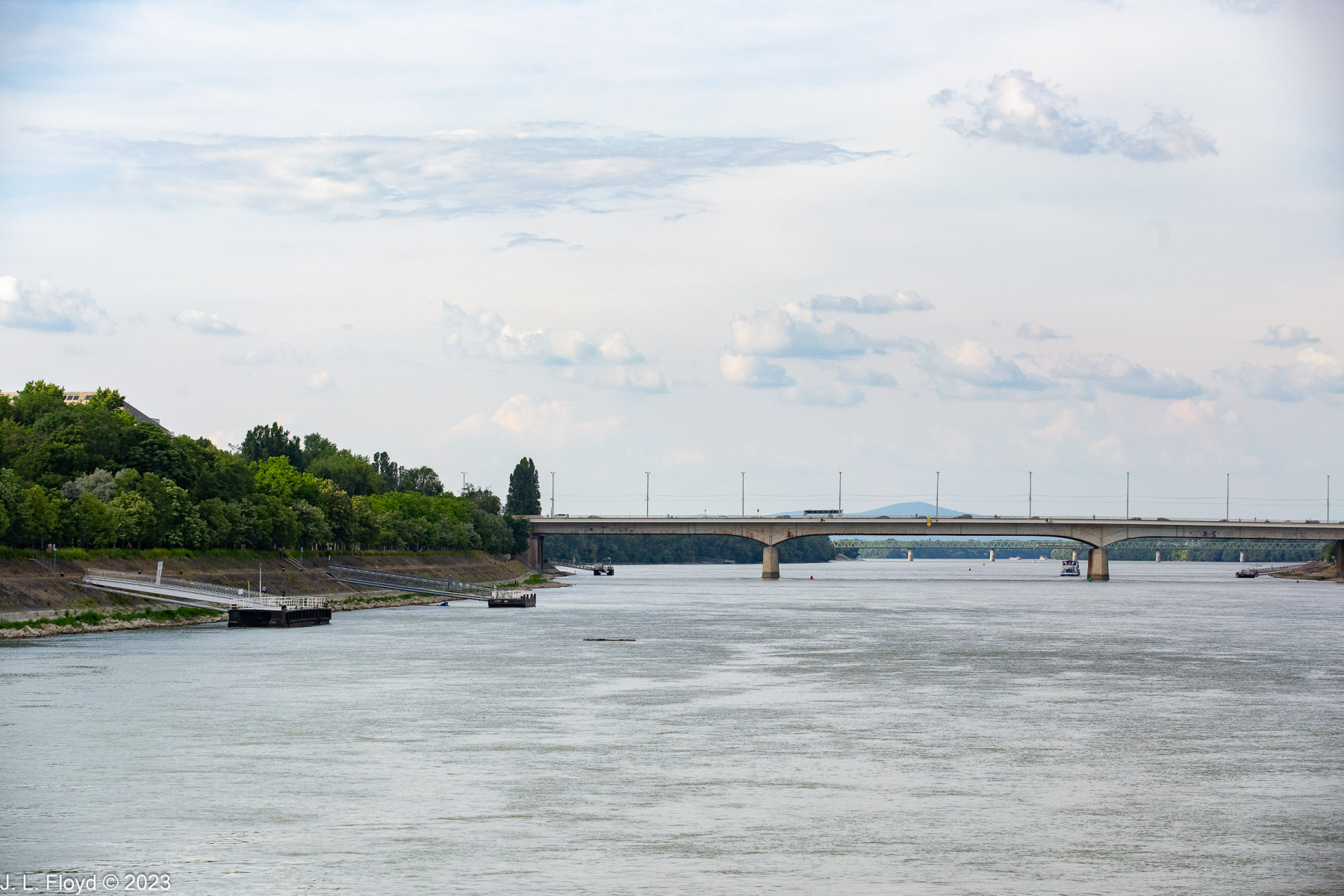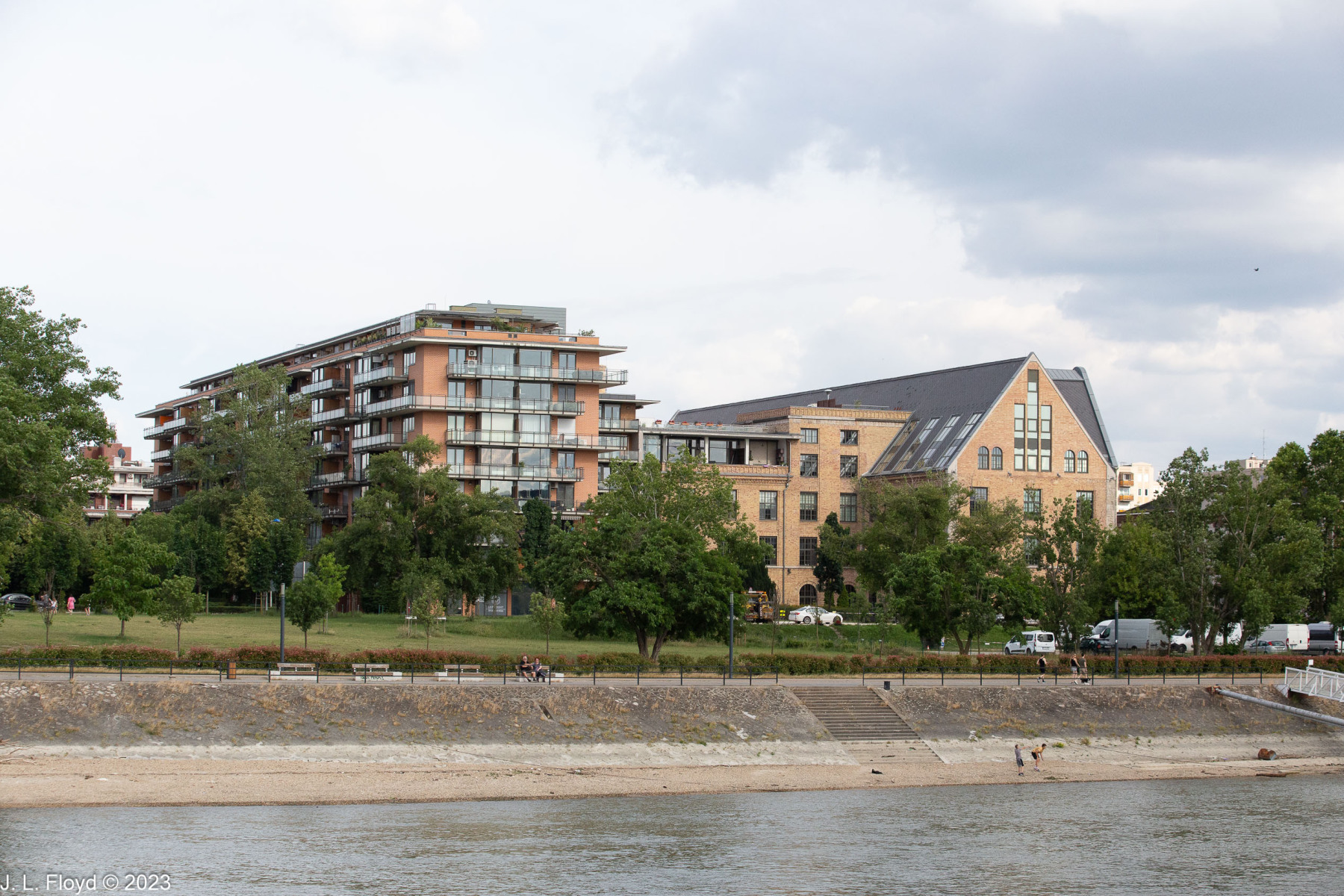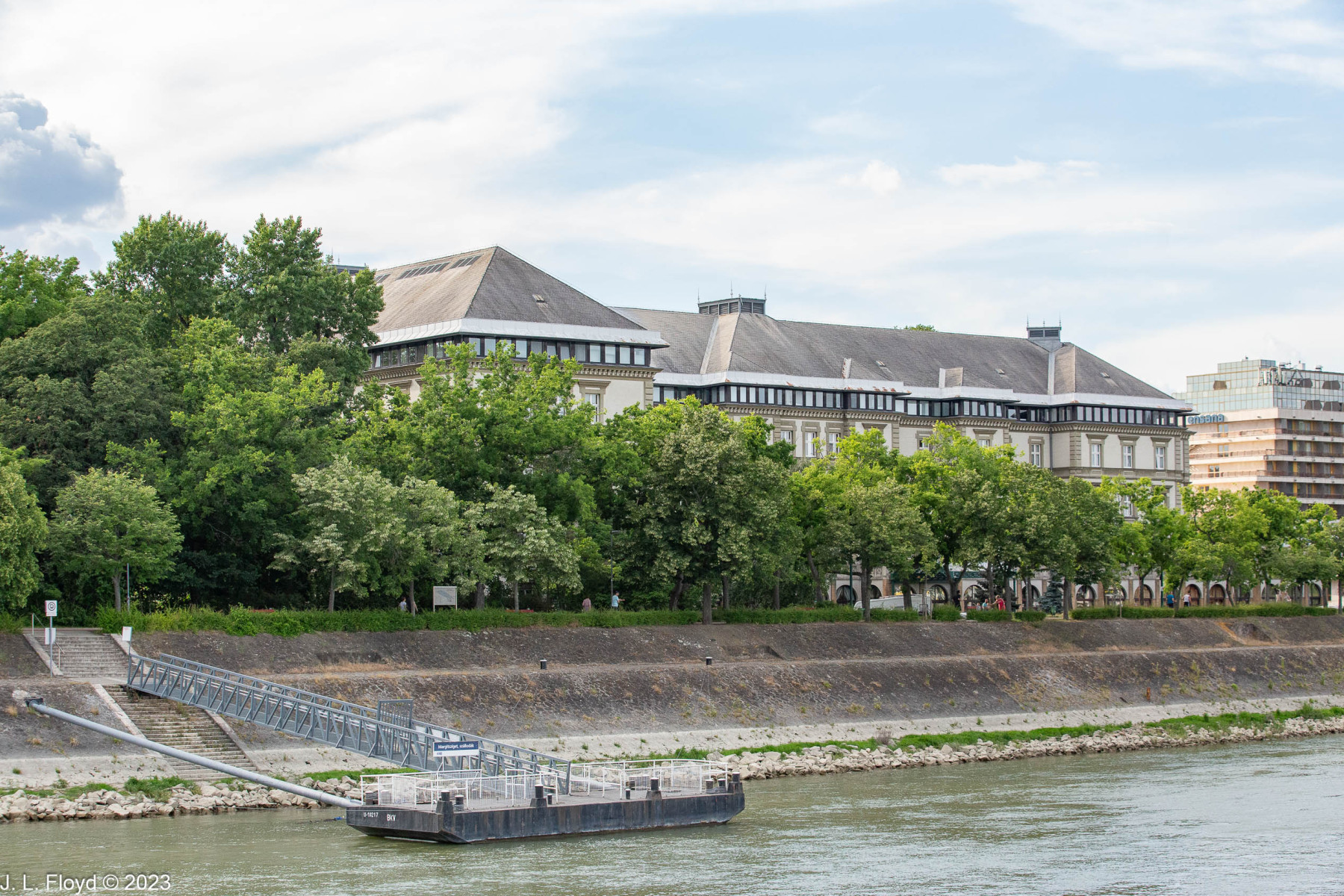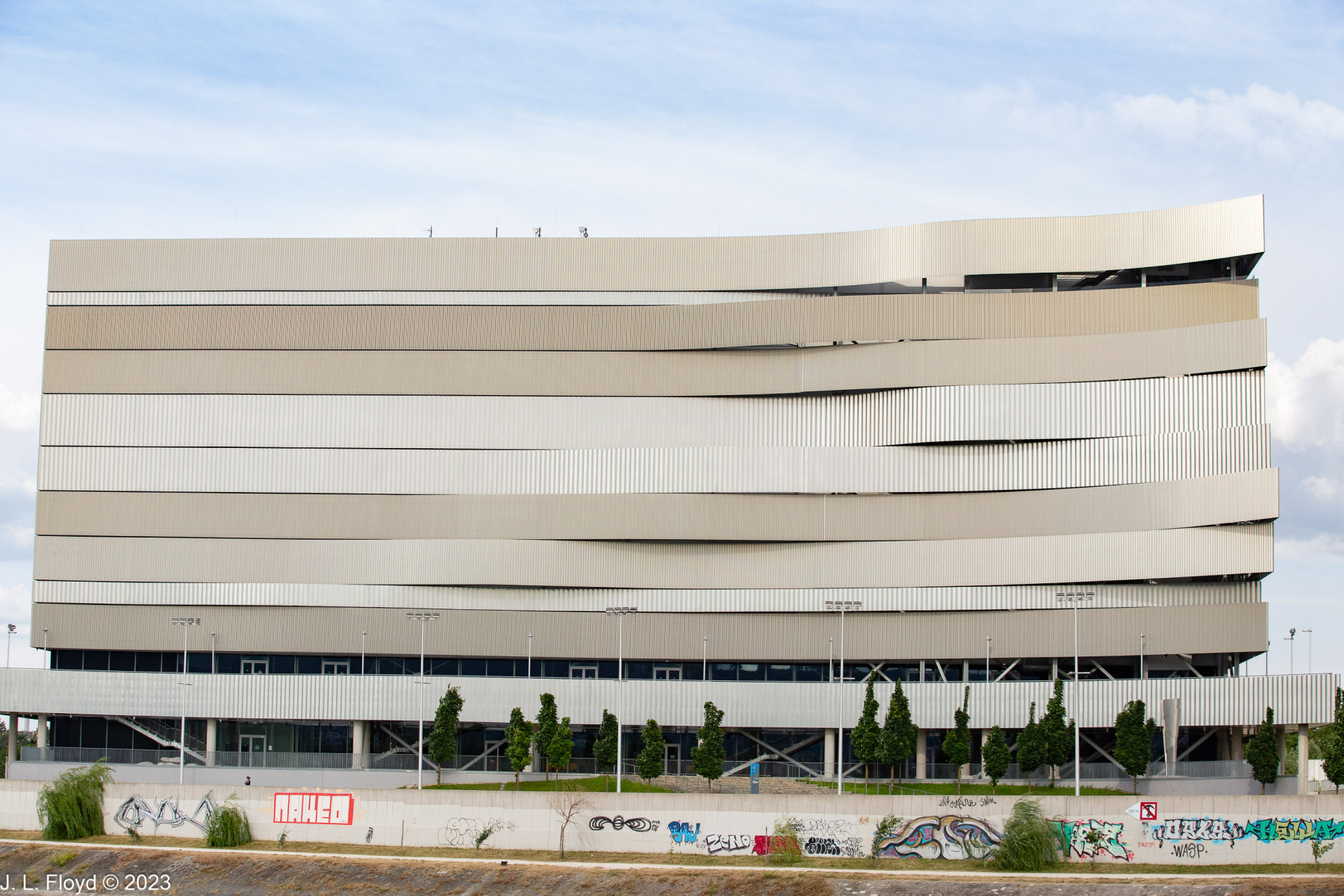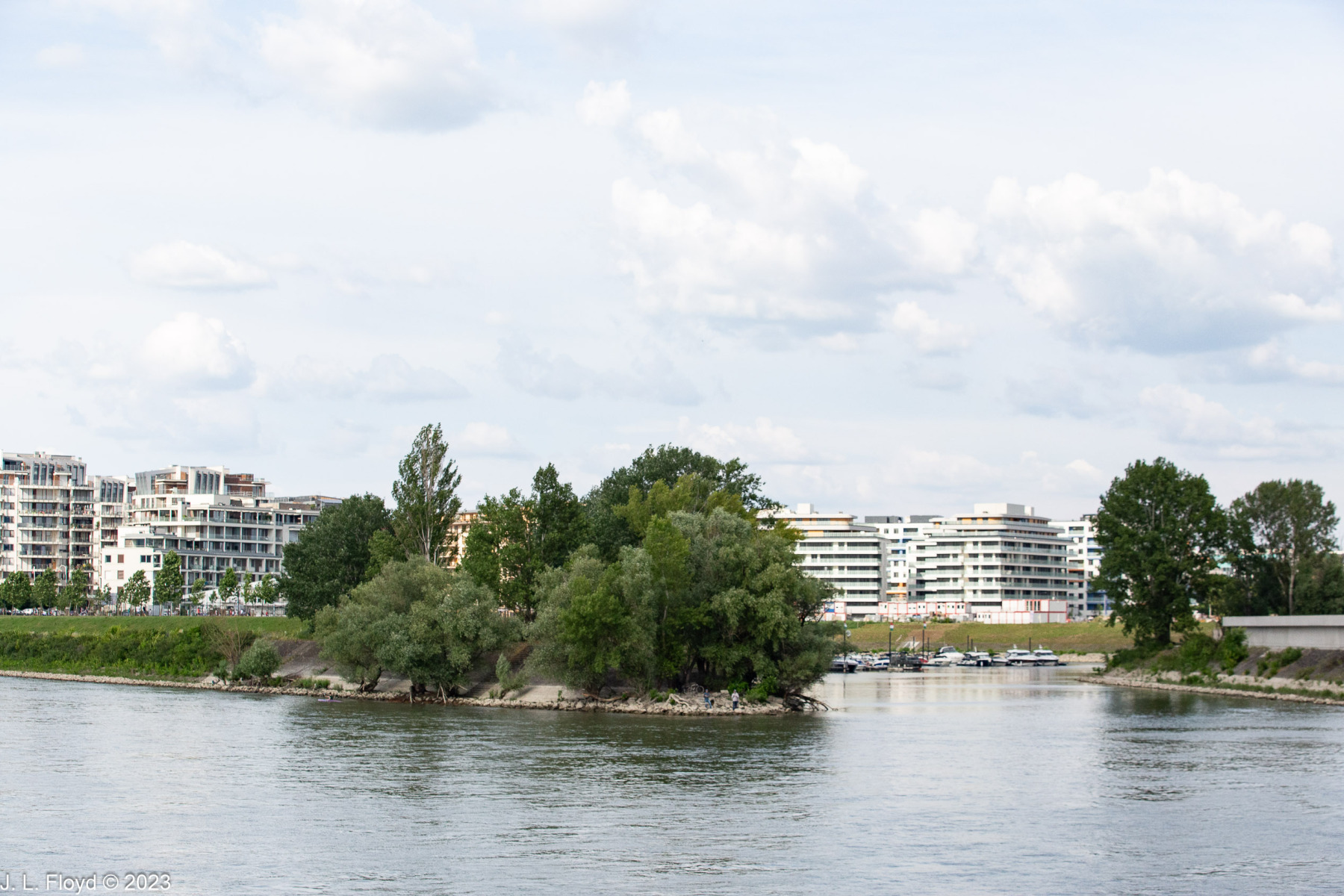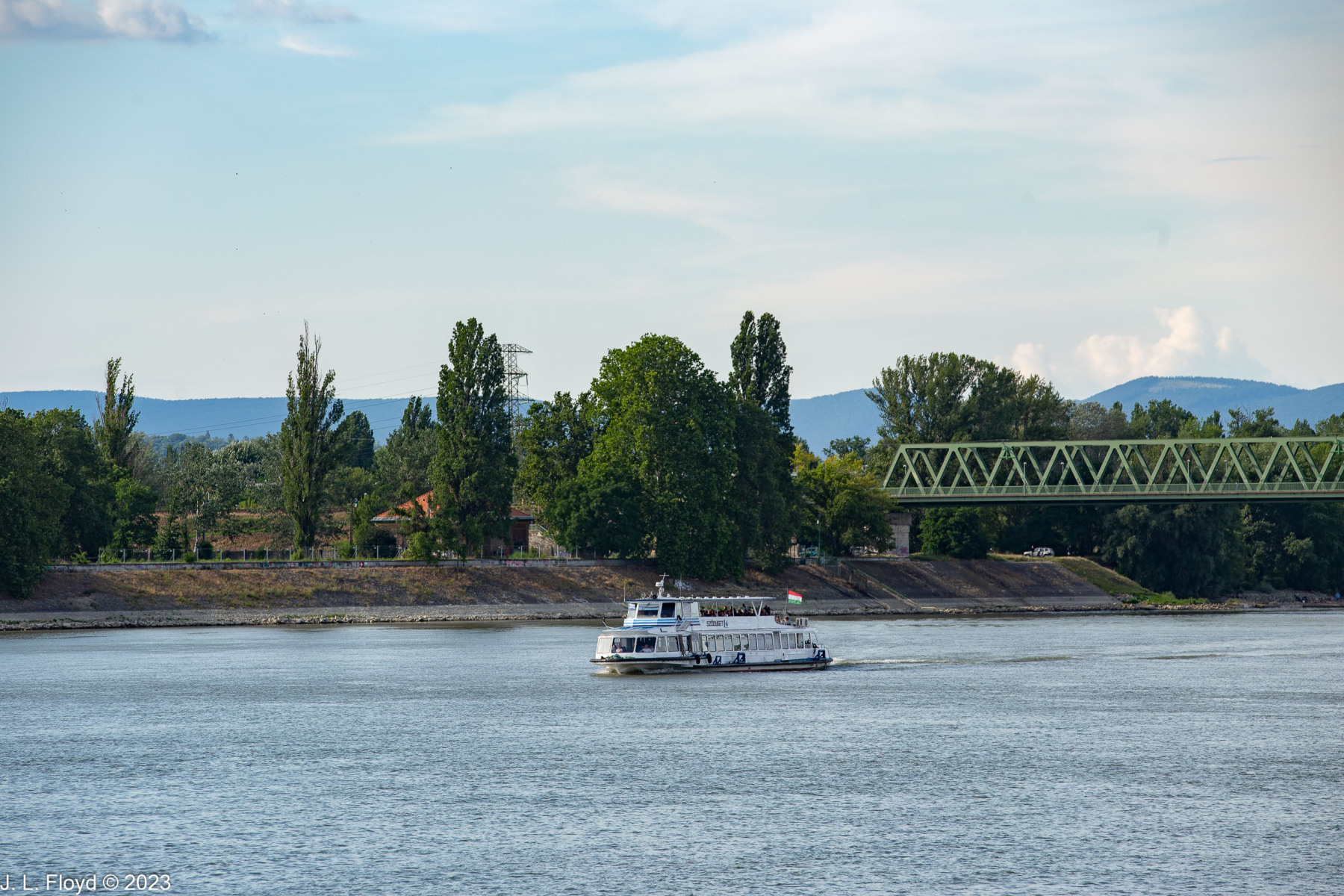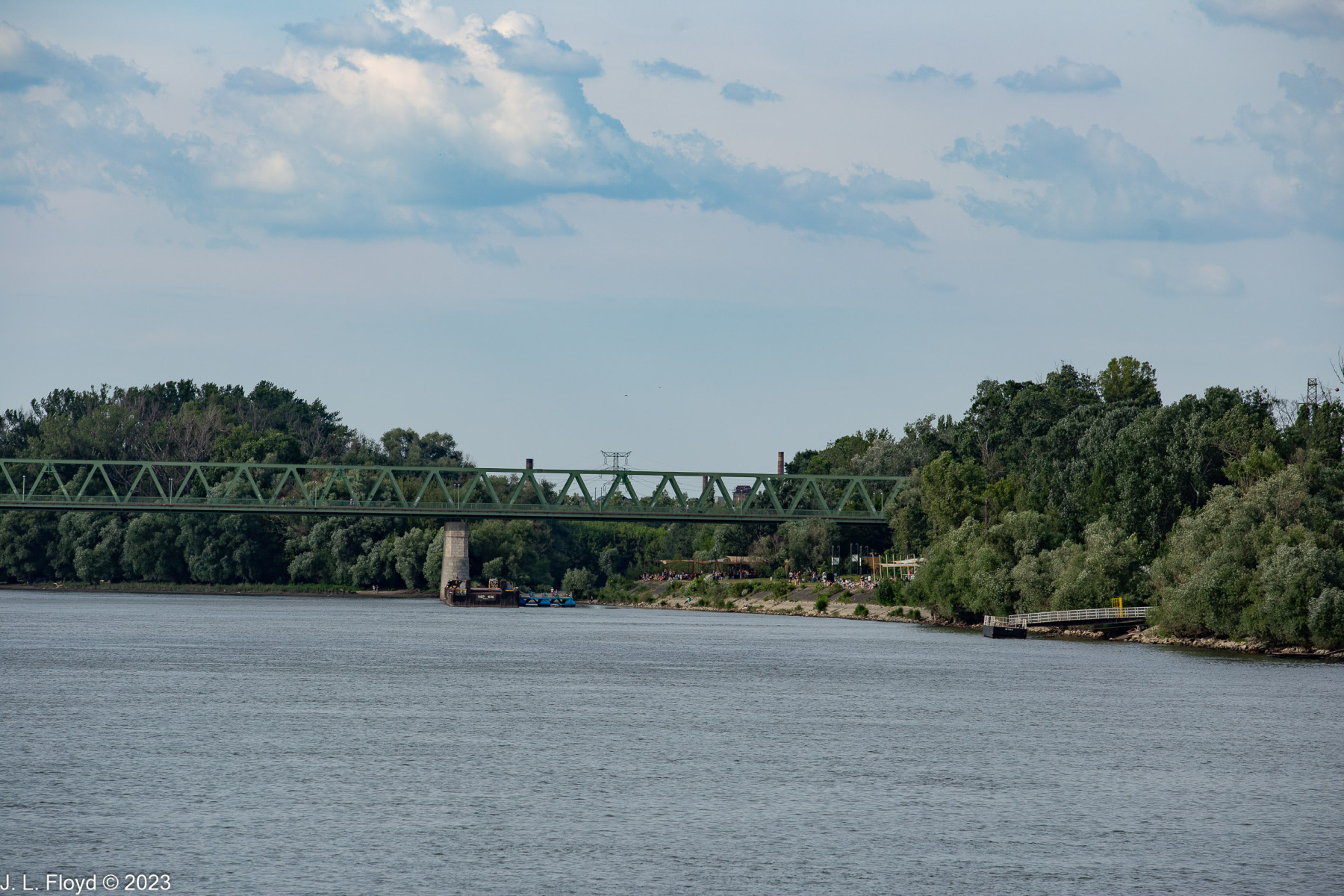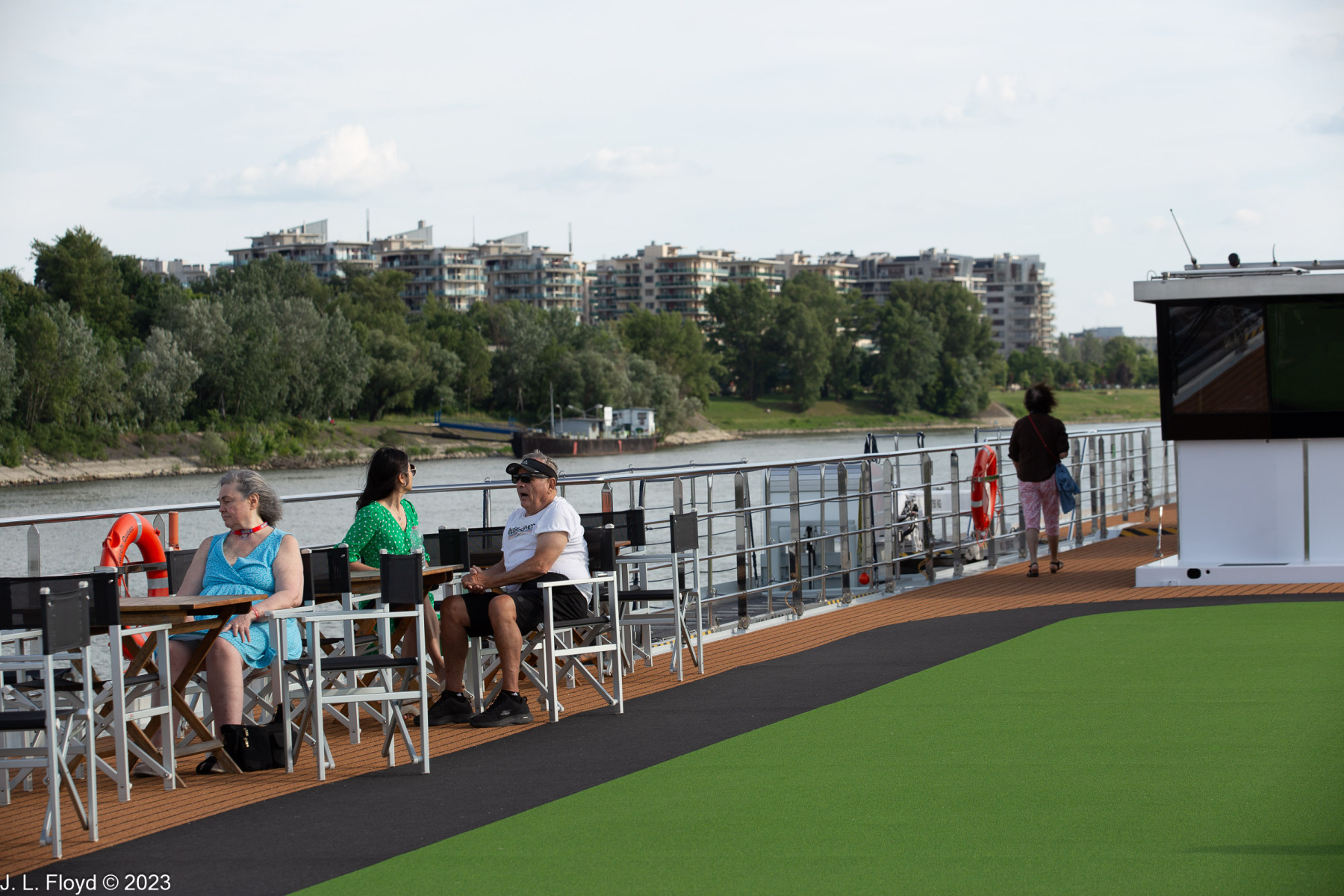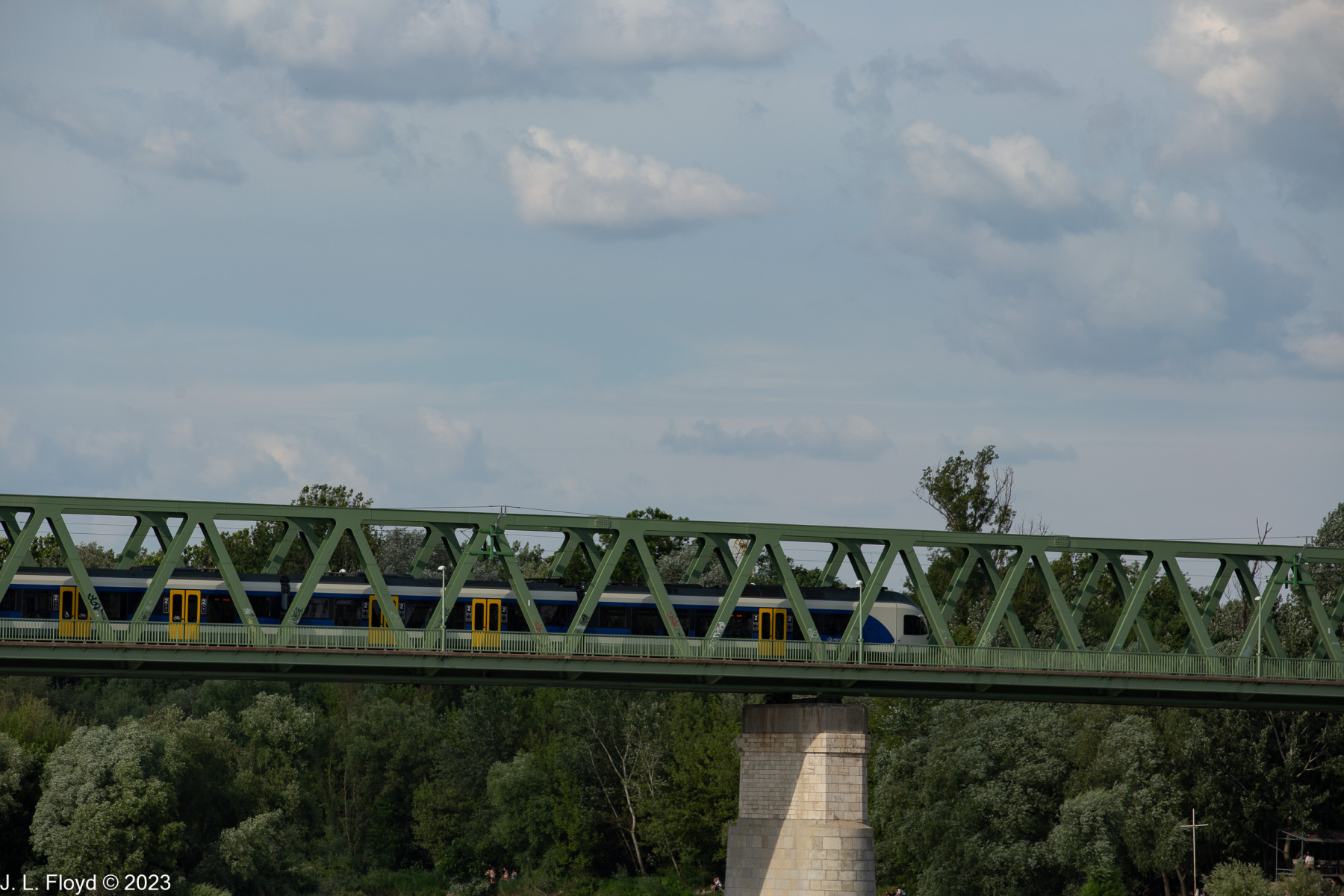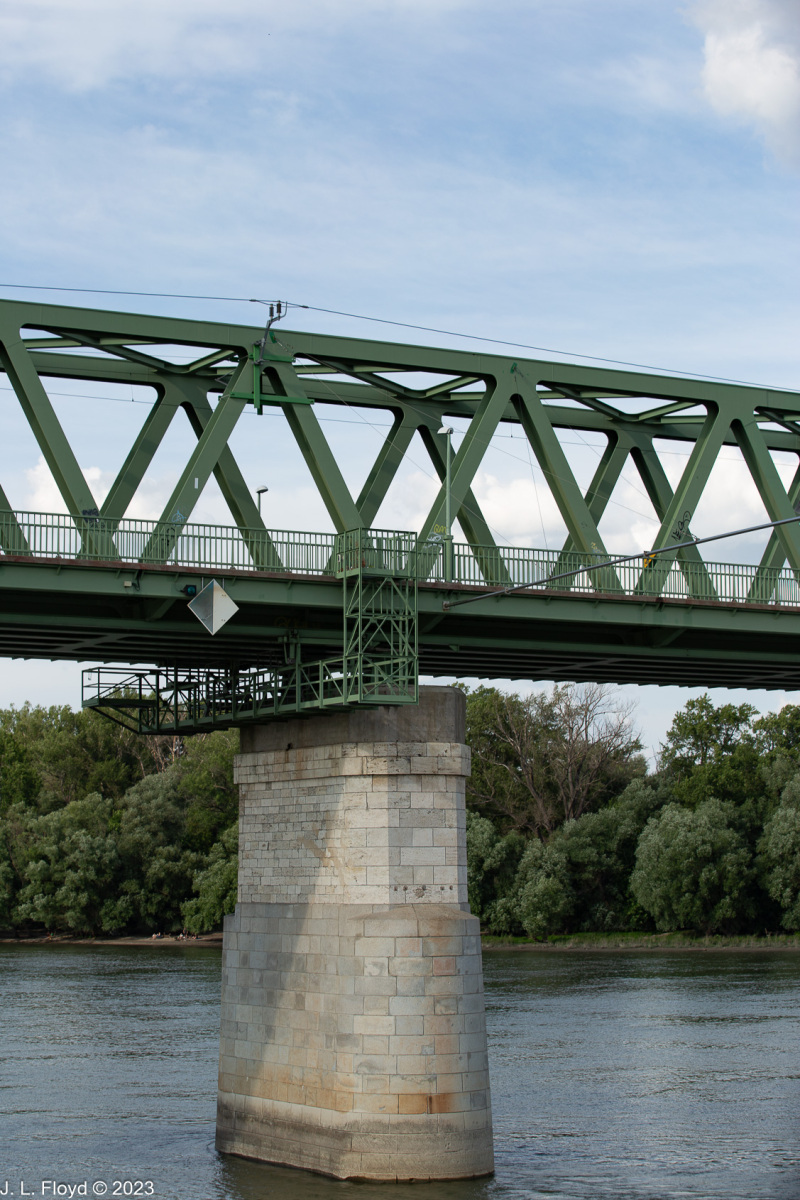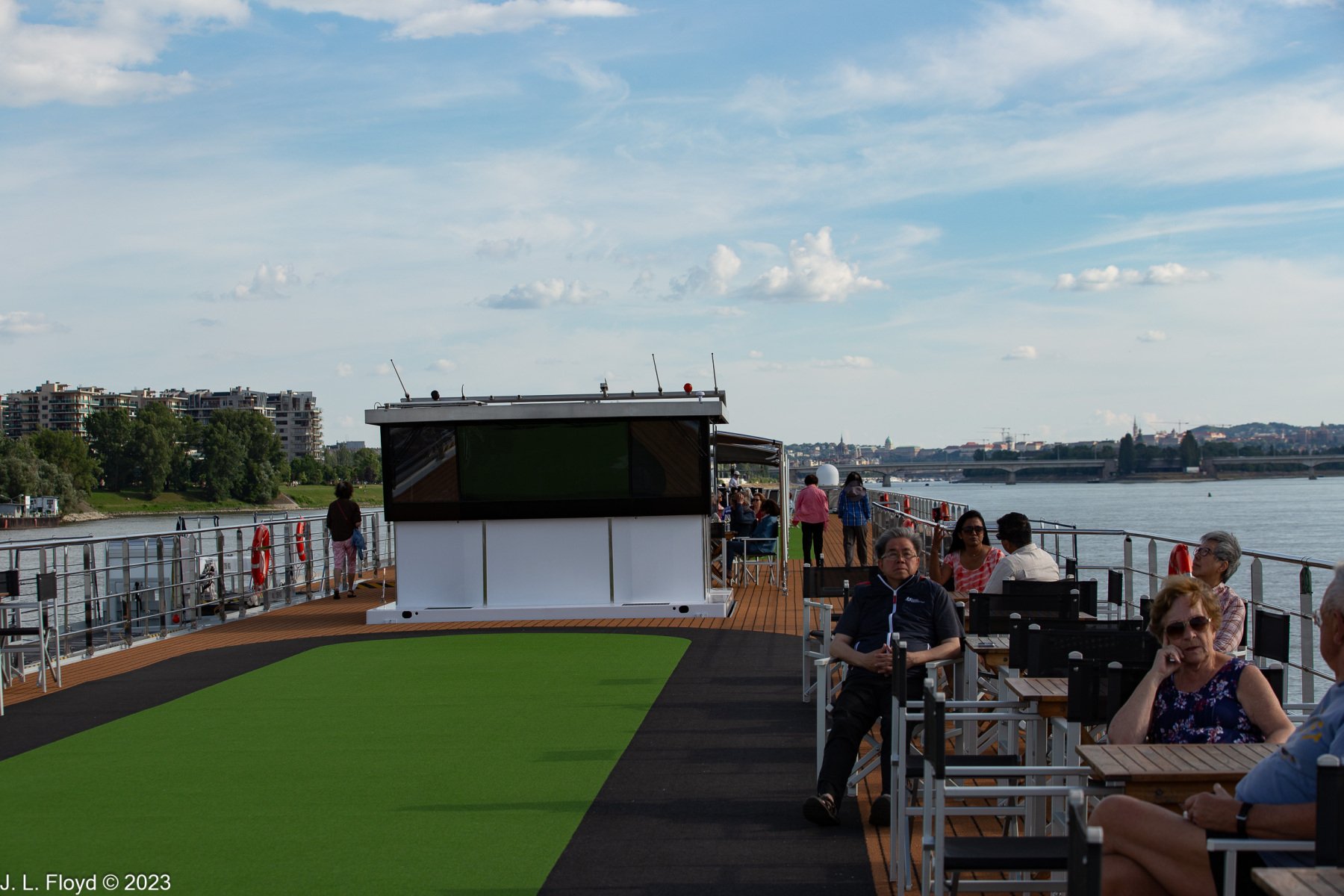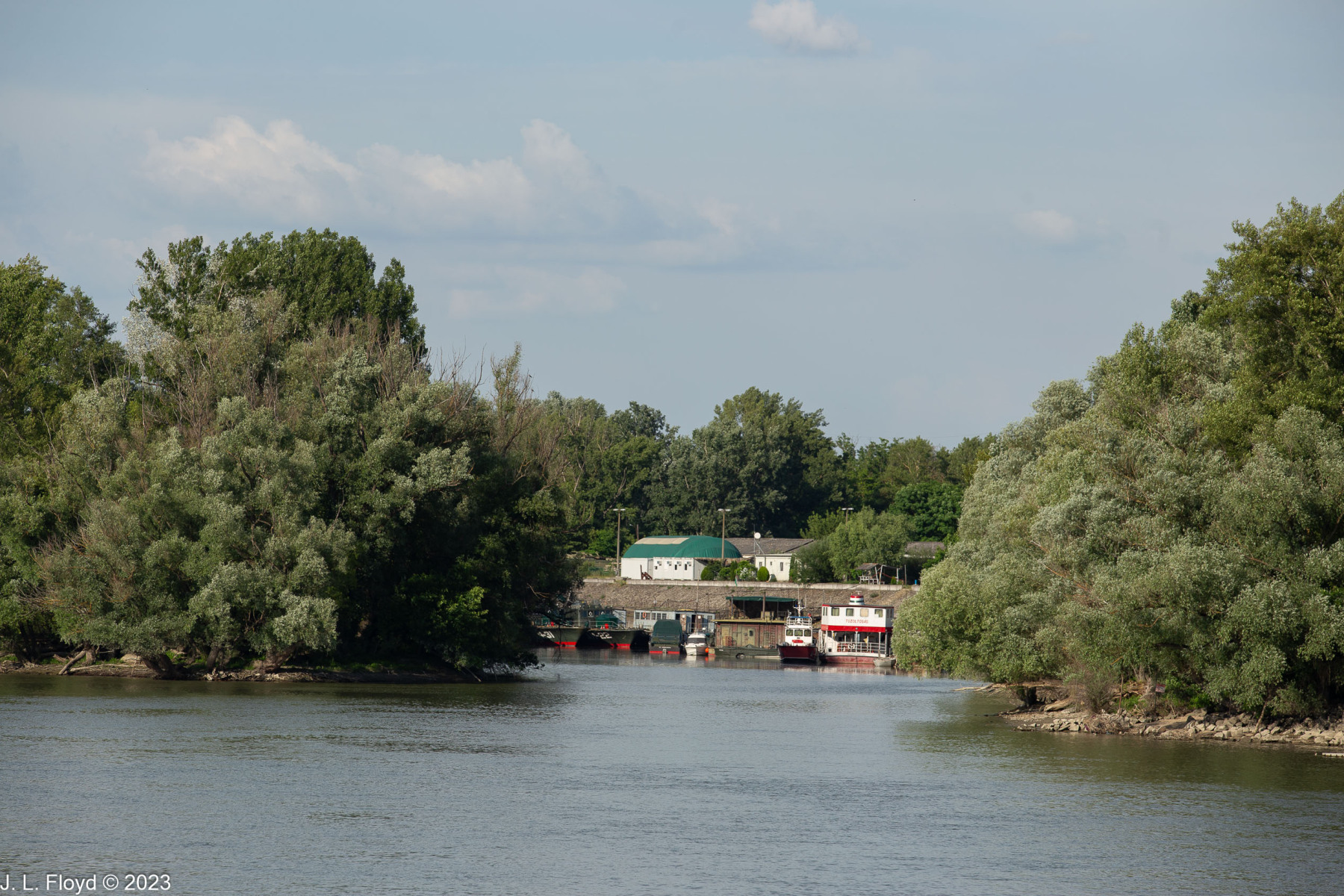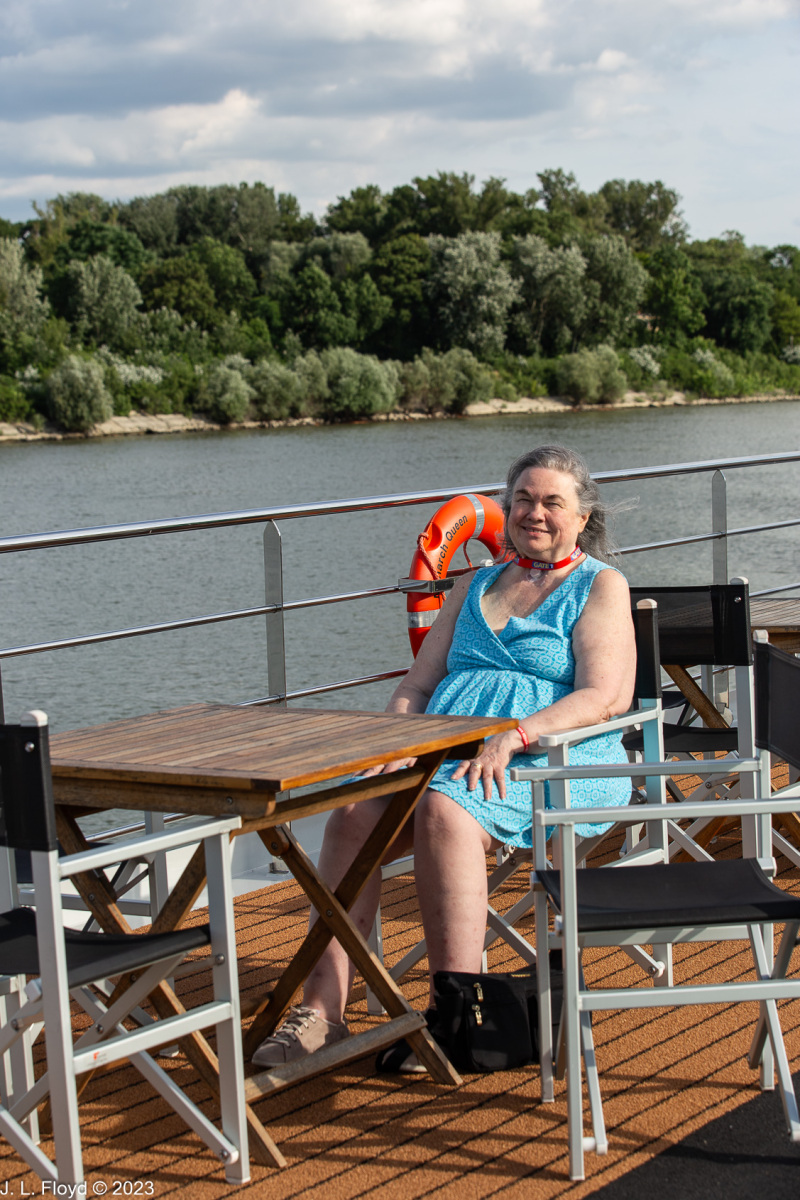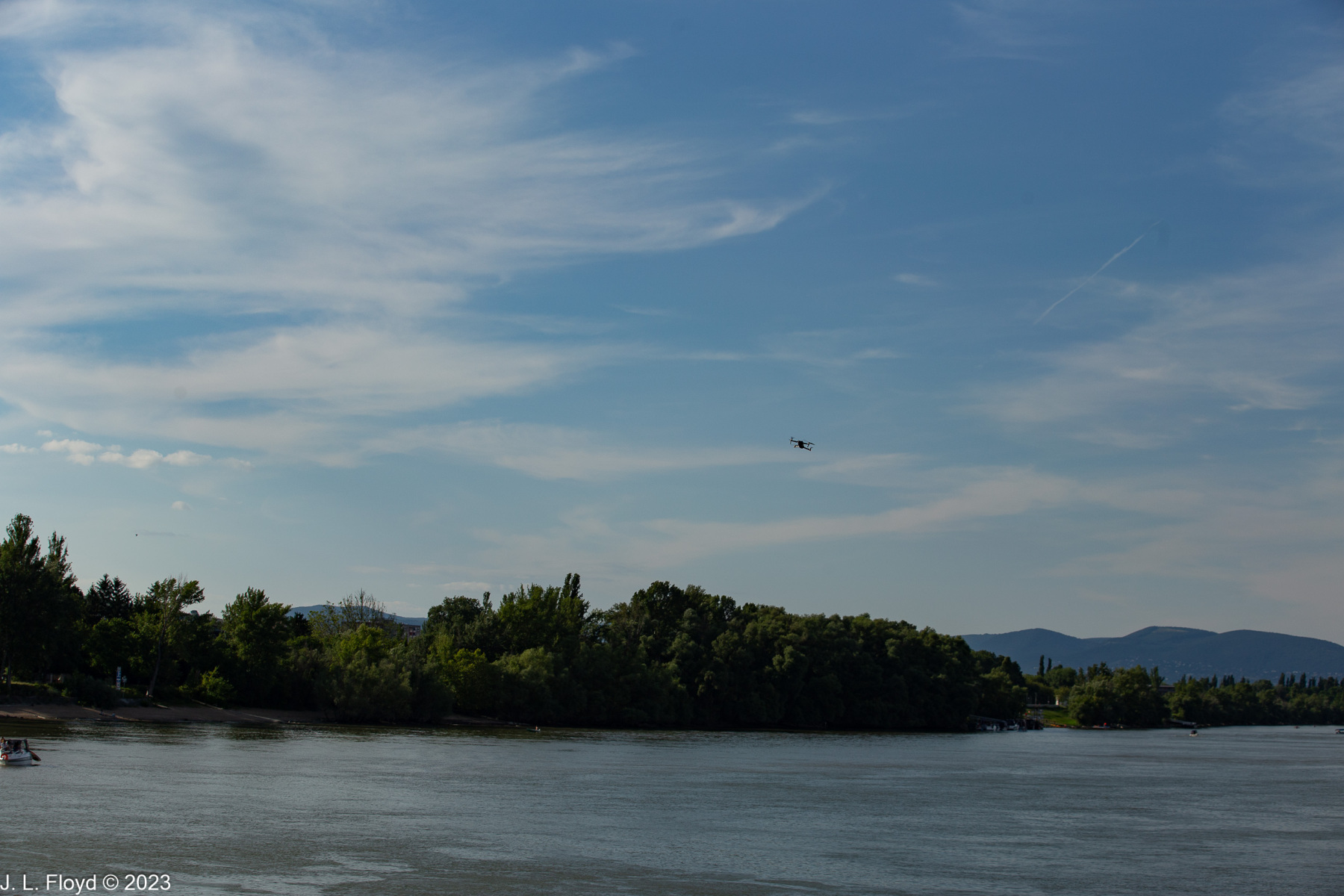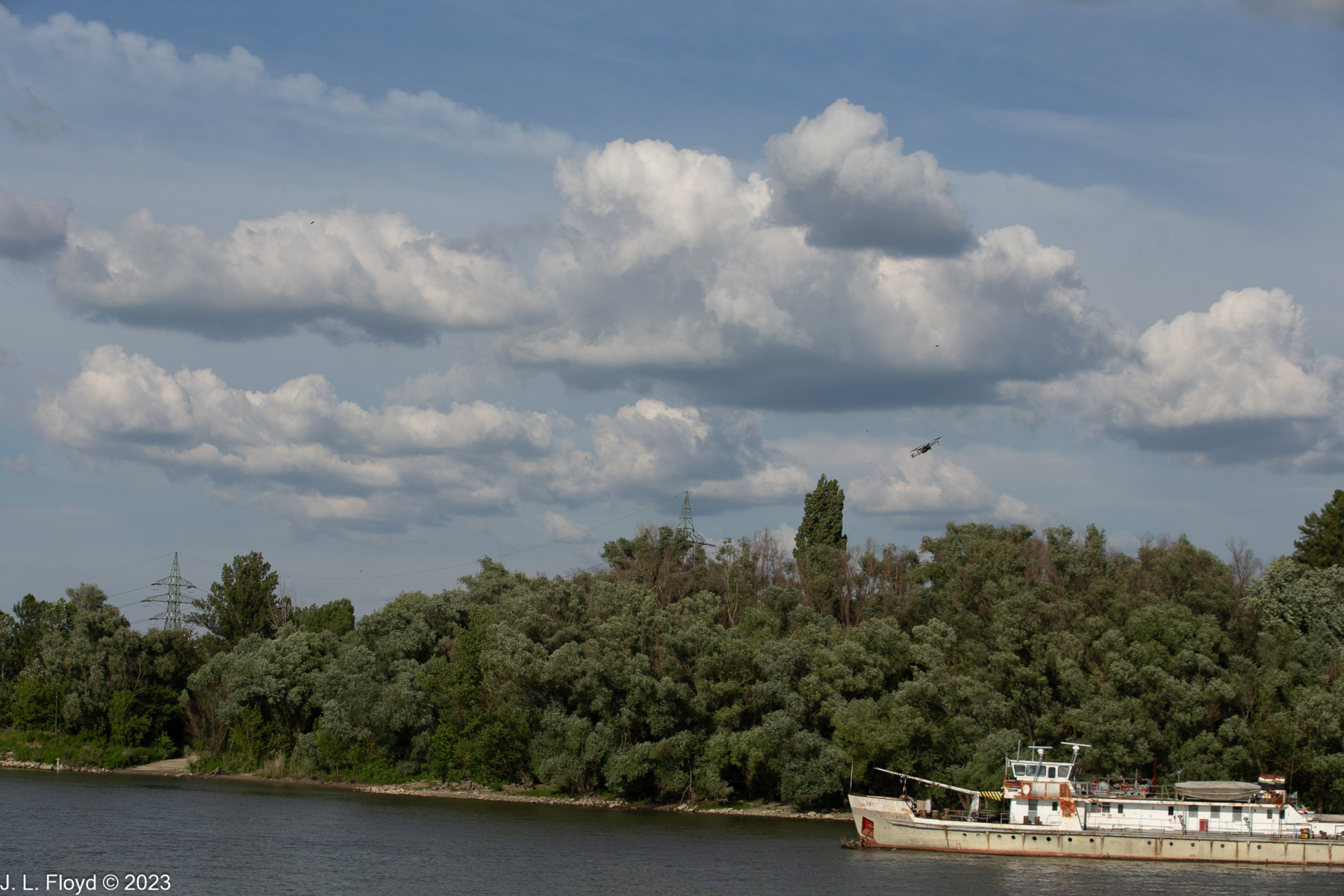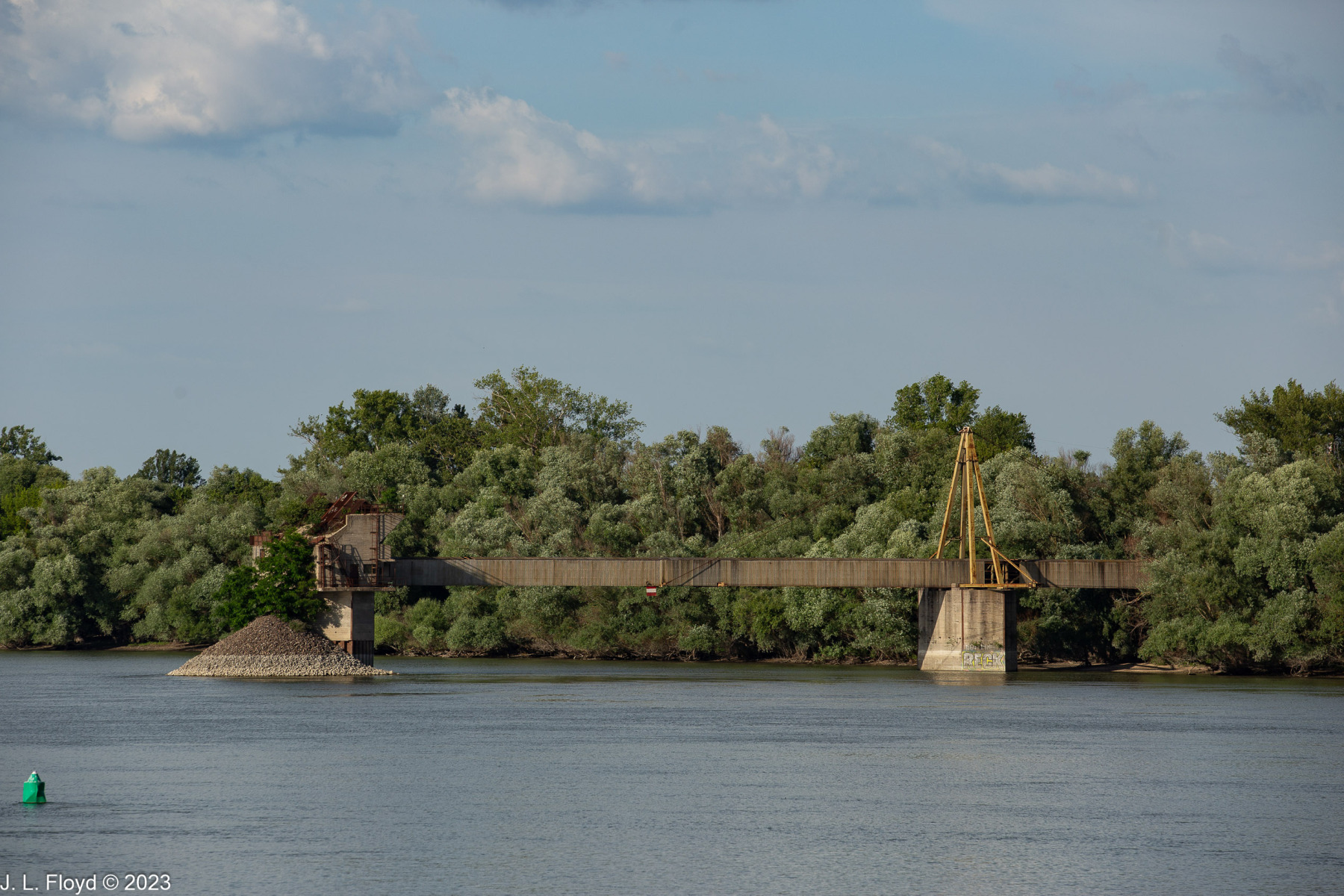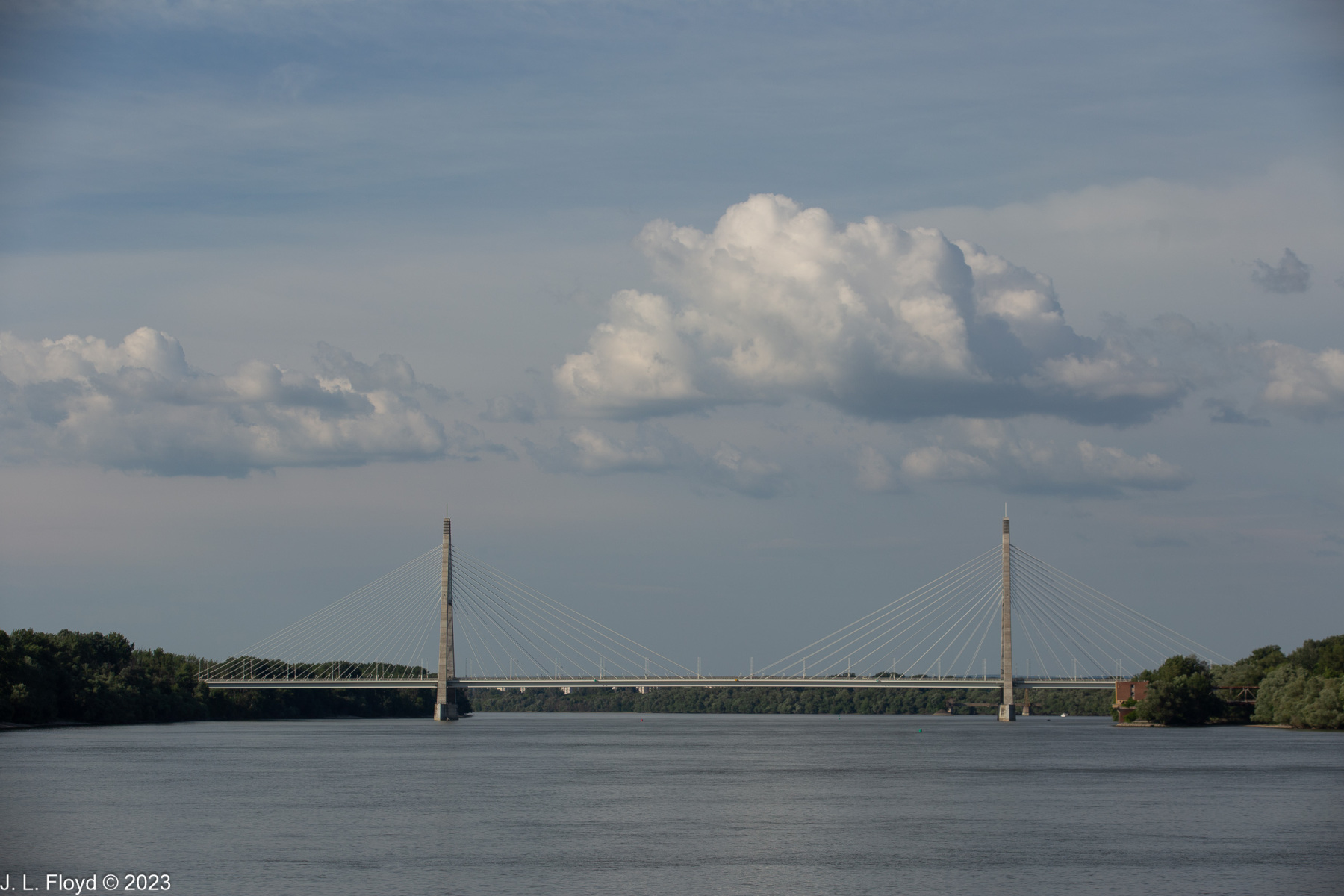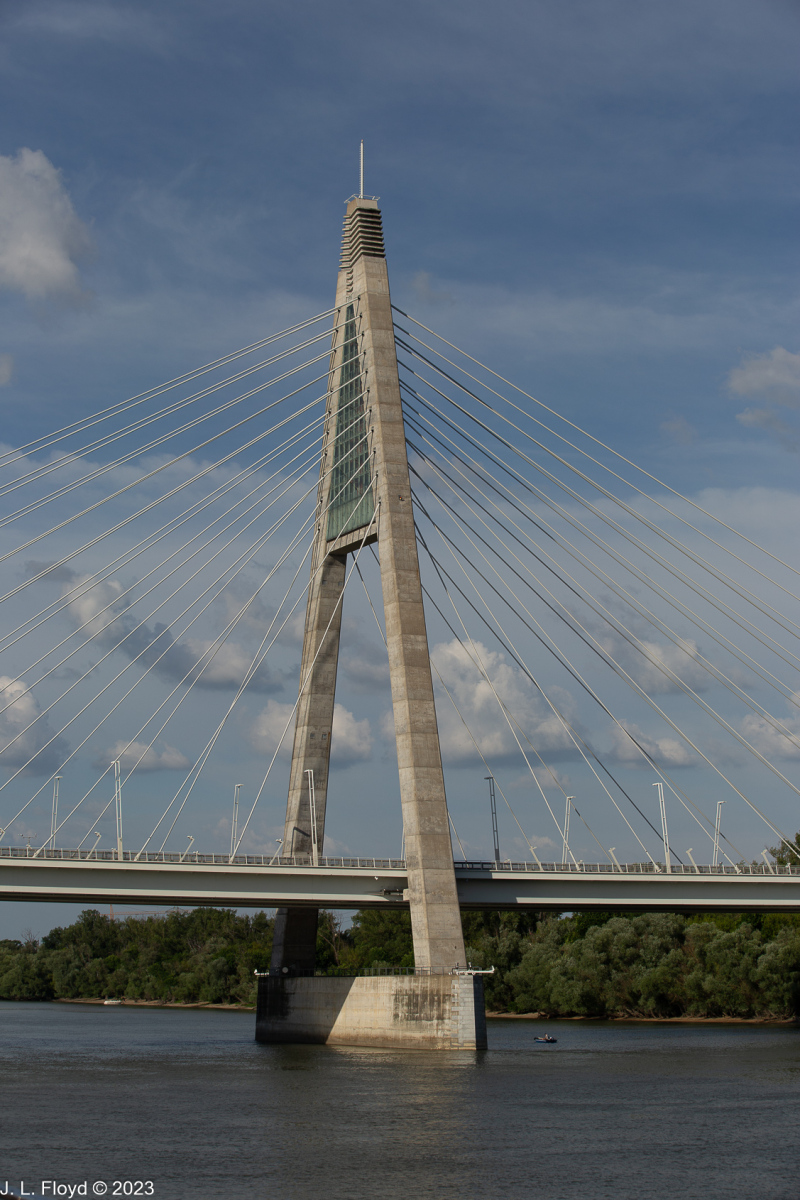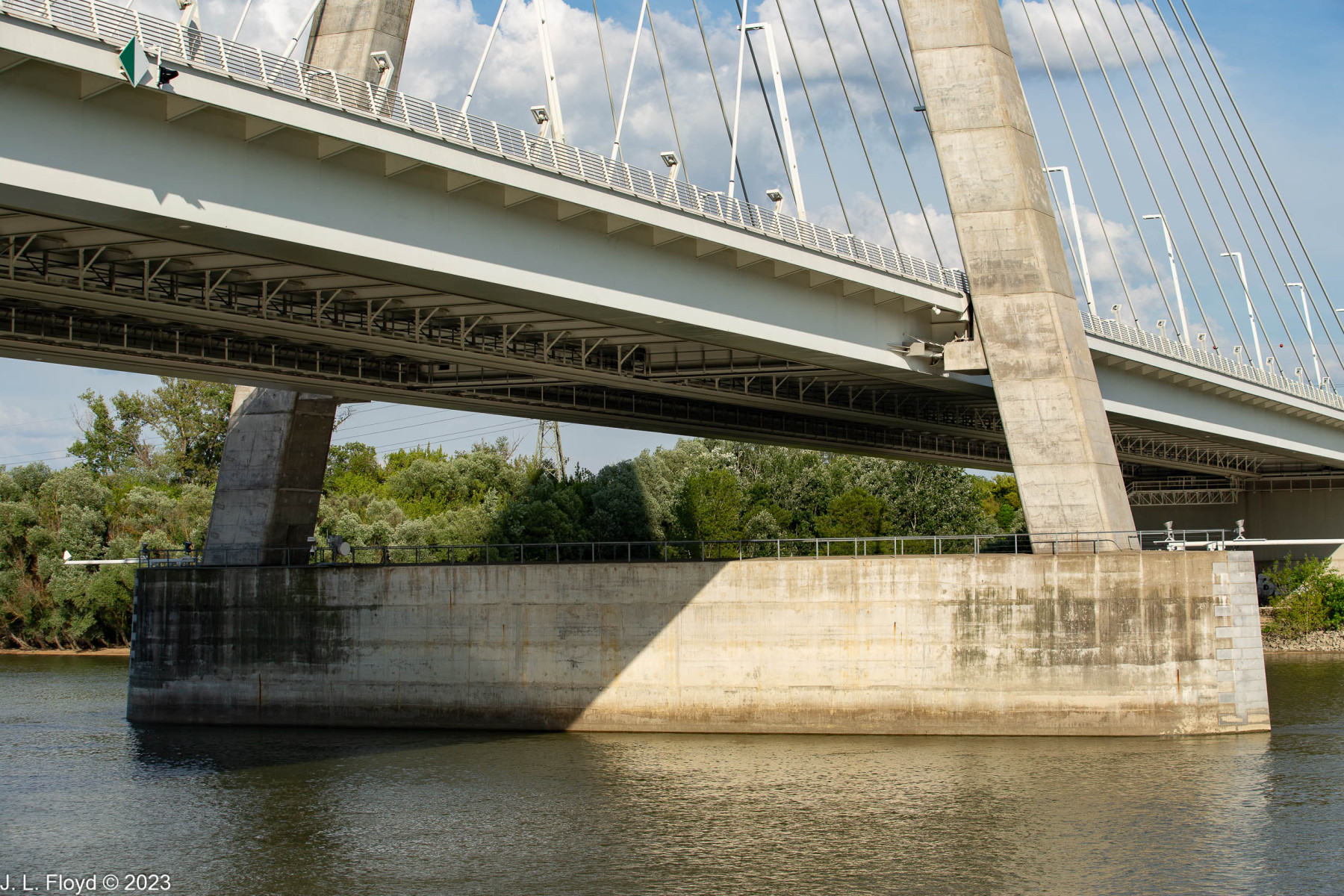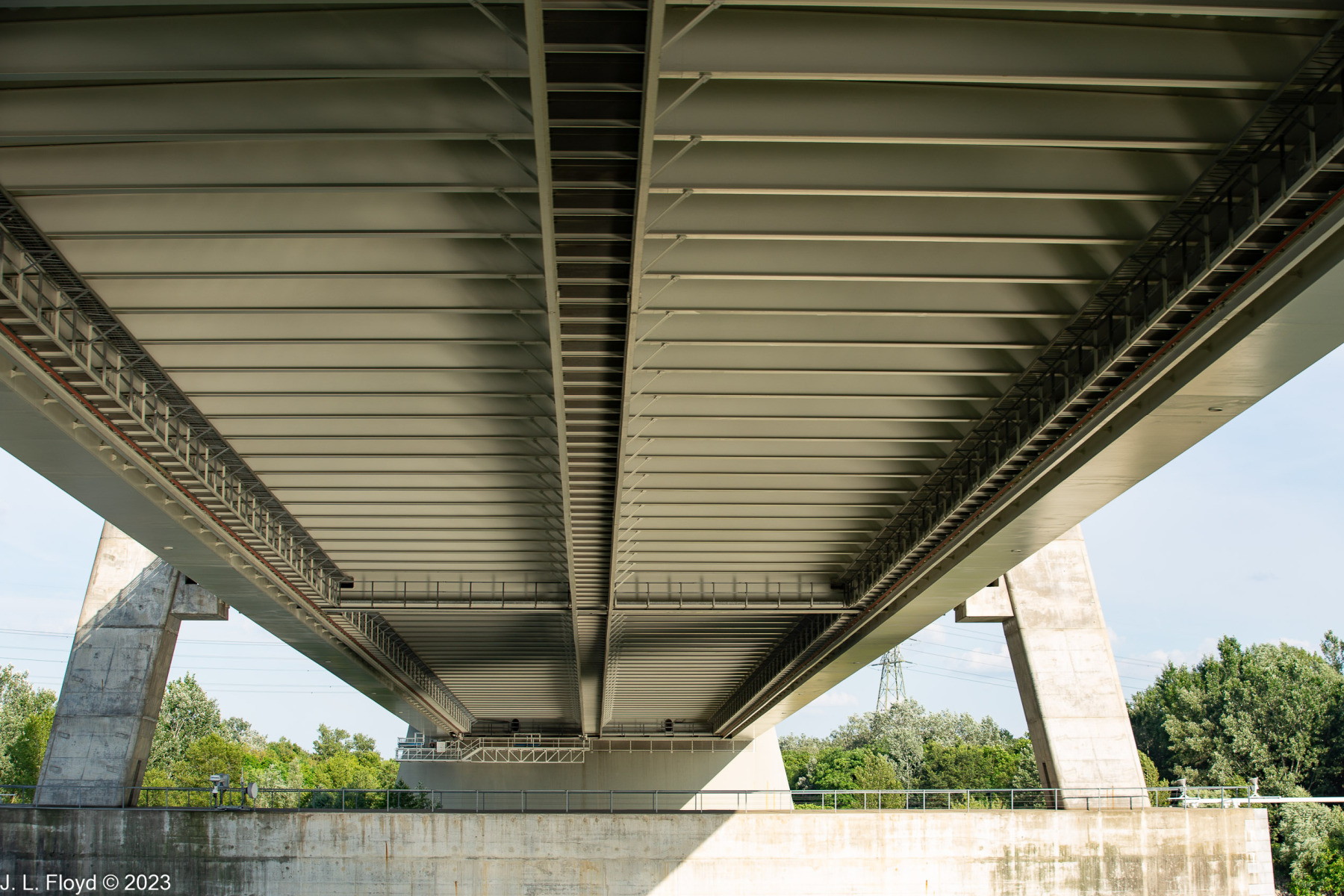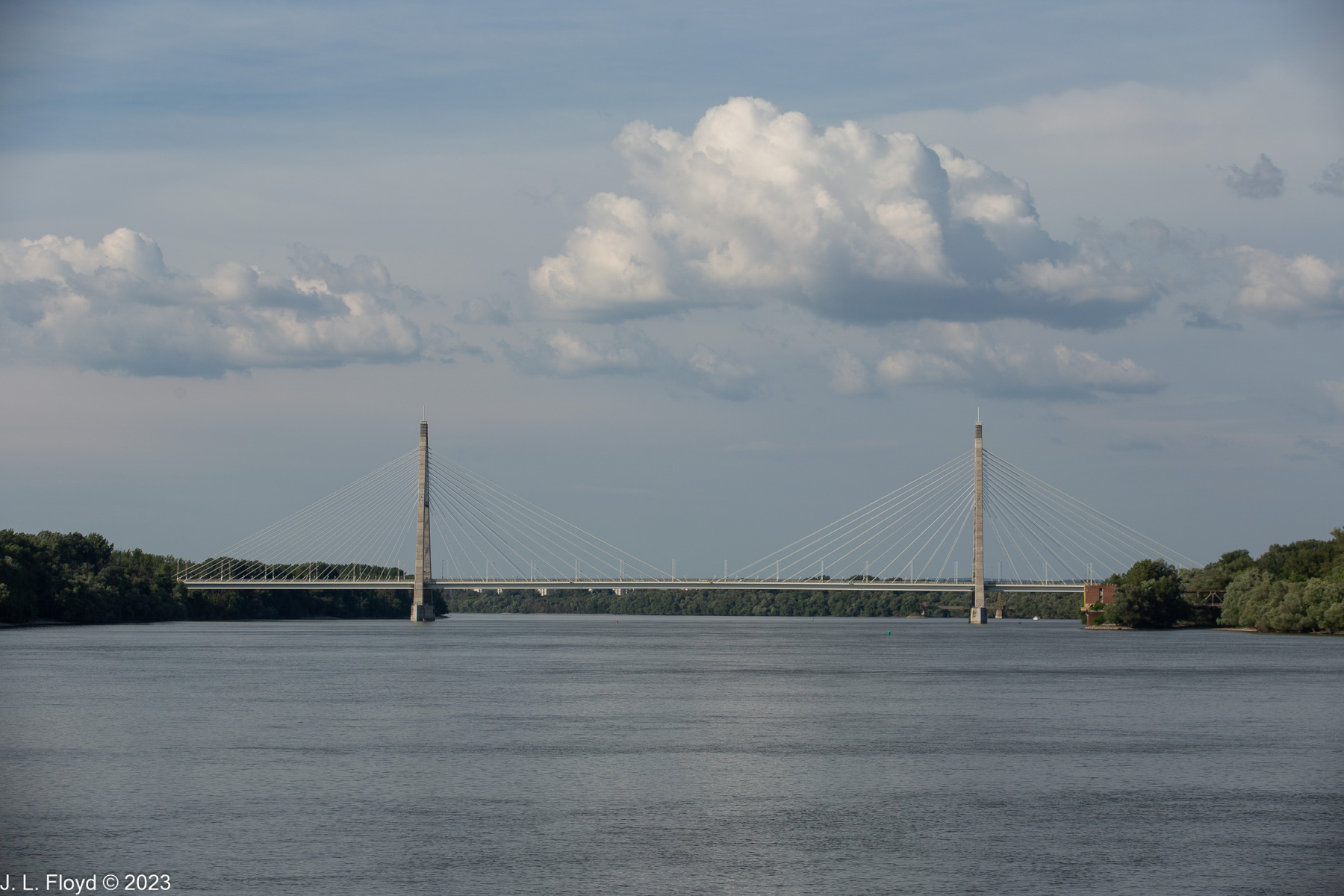The Danube is the second-longest river in Europe, after the Volga in Russia (which I’ve walked on, in the winter, but not cruised on). It rises in the Black Forest of Germany and flows southeast to the Black Sea, but in Hungary it takes a sharp turn due south near Visegrad and continues that way for 371 kilometers or 232 miles to Vukovar in Croatia, near its border with Serbia. Budapest is near the north end of this long north-south leg, only about 40 kilometers from Visegrad. Since our cruise was headed upriver, on the afternoon of June 17, 2023 the Monarch Queen began the voyage heading out of Budapest to the north.
By departure time we had already passed a day on board the ship. We first boarded on the afternoon of Friday, June 16, after completing our tour of Castle Hill. At 6 PM we gathered in the lounge for a briefing by Krysztina, the Cruise Director, who introduced us to the Captain and other officers of the ship. It turned out that the officers and crew were from all over the world, especially Eastern Europe (including the Ukraine). The Hotel Manager, Pavel, was from Rumania. The Activities Director, Nico, was from Italy; he was especially helpful to us in Budapest, as I related in my last post. Krysztina herself is a native of Hungary.
Like most river cruise boats, the Monarch Queen has a top deck, known as the sun deck, which is designed for passenger relaxation and entertainment. I spent a lot of time there during the cruise. Even before the ship left the dock I took a lot of pictures from the sun deck, and I continued doing so as the ship sailed up the river out of Budapest. Inevitably I took many photos of the same attractions I had already shot during our tours of the city; at the cost of some redundancy, I’m including some of them in this post because they are taken from a different perspective and, well, because I like them. But I also shot a lot of attractions that I haven’t touched on previously, so don’t hit the exit button in disgust just yet.
The Monarch Queen was parked on the Pest bank, just south of the Elizabeth Bridge. At the Pest end of the bridge stands the Inner City Parish Church, the main parish church of Pest. It is one of the oldest church sites in Budapest, dating from the 11th century. The church itself has been through several incarnations, the most recent being Baroque. After World War II, when the Elizabeth Bridge was being rebuilt, the Communist government of Hungary wanted to demolish the church, but the Catholic Church managed to negotiate its preservation. Next to the church stands a venerable building which now houses a theological seminary.
The Elizabeth Bridge itself was named for Elizabeth of Bavaria, who was wife of Emperor Franz Joseph and Empress of Austria from 1854. In contrast to Franz Joseph himself, Elizabeth loved Hungary and was popular there; she is still remembered fondly as “Sisi” by the Hungarians. She was assassinated in Switzerland by an anarchist in 1898. A statue of her now stands on the Buda side of the bridge.
The first version of the Elizabeth Bridge was completed in 1903; it was somewhat similar to the Széchenyi Chain Bridge farther north. Like all the other bridges of Budapest, it was destroyed by the Germans in World War II. The Communist government of the post-World War II era could not afford to reconstruct it in its original form, so it had a new plain suspension bridge built on the same foundations.
On the Buda side, on the hill above the Elizabeth Bridge stands a colonnaded monument to St. Gellért, one of the patron saints of Hungary, along with Saints István (Stephen) and Imre (Emeric). In fact, the hill itself is named Gellért Hill. Known as Gerardo di Sagredo in Italian, he was a native of Venice and Benedictine monk who went on a pilgrimage to the Holy Land in 1020 and wound up in Hungary instead. King Stephen persuaded him to stay there and made him tutor to his son. Eventually the king also made him a bishop. He was martyred in 1046 in a pagan uprising; the heathens supposedly put him in a barrel and rolled him down the hill which now bears his name.
At the top of Gellért Hill is the Hungarian Statue of Liberty. This is a bronze statue, 14 meters tall, standing on a pedestal that is 26 meters high, and holding a palm leaf. It was erected in 1947 to commemorate the 1945 Soviet liberation of Budapest from the Germans. On the pedestal was an inscription in Hungarian and Russian which translated to English as “To the memory of the liberating Soviet heroes from the grateful Hungarian people 1945.” After the collapse of Communism in 1989 the Hungarians, no longer feeling much gratitude to the Soviet army, changed the inscription to read “To the memory of those all who sacrificed their lives for the independence, freedom, and prosperity of Hungary”.
Budapest also has a Liberty Bridge. It is the next bridge south of the dock where the Monarch Queen was moored, and I was able to take a couple of pictures as the Monarch Queen was getting underway. To my shame I didn’t get one of the entire bridge, just two pictures of east half. It is a beautiful bridge, designed in an art nouveau style and decorated with Turul bird sculptures and the country’s coat of arms. It was built during the 1890s as the Emperor Franz Joseph Bridge and inaugurated by the Emperor himself. At its west terminus (Buda side) is Gellert Square, with the Gellert Spa and the Budapest University of Technology and Economics close by; at the east end, the Pest side, is Fővám Square, the location of the Central Market Hall, which we had visited that very morning, but I hadn’t been in a position to get a good photo of the bridge then.
As the Monarch Queen began its leisurely voyage northward, crossing under the Elizabeth Bridge and heading toward the Chain Bridge, we passed a number of sites I hadn’t noticed or paid much attention to before. There was the Orthodox Church of Our Lady, just north of the Elizabeth Bridge on the Pest side, in Petőfi Square, originally built in 1801. Next came the massive structure of the Budapest Marriott Hotel, built as the Duna Intercontinental Hotel in 1969; it only became the Marriott in 1993. It is a 5-star hotel and is said to have wonderful views from all of its rooms.
On the Buda side, we passed the Hauszmann Palace, an Italian Renaissance mansion built by the celebrated architect Alajos Hauszmann for himself in 1892. He lived there until 1919, when the short-lived Hungarian Soviet Republic confiscated it. I don’t know whether he got it back after the fall of the Soviet regime.
Back on the Pest side, we came to the Four Seasons Hotel near the end of the Chain Bridge. The Four Seasons, considered by some to be the best hotel in Budapest, began life as in 1906 as an office building, the foreign headquarters of the London-based Gresham Life Assurance Company. It also contained apartments for the staff. But it was designed and built by Hungarian architects in an elegant art nouveau style. At the end of World War II, the Soviet army used it as barracks; later, under the People’s Republic, it served as an apartment building. It only became the Four Seasons Hotel at the end of the 20th century, when private investors purchased the property and rebuilt it as a luxury hotel, restoring the original amenities and works of art – staircases, mosaics, ironwork, gardens. It is now owned by the Sultanate of Oman, though Four Seasons continues to manage it. It is considered one of the finest examples of art nouveau architecture in the world.
As we cruised by the Four Seasons Hotel and the Ministry of Interior next to it, we passed under the Sz
From the sundeck of the Monarch Queen we had great views not only of the Chain Bridge but also of Buda Palace on the hill above it. As we sailed further up the river, just before we reached Parliament Point I turned my camera astern and shot a telephoto view of the part of the city we had just left. In the center of that picture there is a tall building, in fact the tallest in Hungary, called the MOL Campus. It is the 28-story headquarters of the MOL Group, a multinational oil and gas conglomerate based in Hungary. It is Hungary’s most valuable enterprise, reporting a net profit of $770 million in 2019. MOL gas stations are all over Budapest. But the group is truly multinational; its members include the formerly state-owned Croatian and Slovak oil and gas companies, among others, and it has operations in 30 countries.
On the Buda side, we were passing a district called Watertown (Víziváros), a long, narrow neighborhood between Castle Hill and the Danube, and partially built on the side of Castle Hill. Historically, it was an area inhabited by fishermen and artisans. Its most prominent landmarks are churches – St. Anna’s Parish Church, the Church of the Stigmata of St. Francis, and the Reformed Church in Szilágyi Dezső Square, with a neo-Gothic architecture strikingly different from the Catholic churches nearby.
On the Pest side, we took a last look at the House of Parliament as we continued north to the Margit Hid (Margaret Bridge). It is Budapest’s second oldest permanent bridge, after the Chain Bridge, having been built by French engineers in the 1870s. It is also rather unusual in having not two but three end points – one on each bank of the river, of course, and the third on Margaret Island in the middle of the river. Margaret Island, Margitsziget in Hungarian, was an important center of religious life in medieval times, and it is strewn with ruins of churches and convents. It is named after Saint Margaret (1242–1270), the sainted daughter of King Béla IV of Hungary, who lived in a Dominican convent on the island. Nowadays, however, it is a parkland and recreation area.
Another bridge crosses the north end of Margaret Island, but it does not provide access to the island. Completed in 1950, it was opened as Stalin Bridge, but the name was changed to Árpád Bridge in 1958.
As we passed under Árpád Bridge we came into a stretch of the Danube which apparently catered to aquatic recreation. This was the Vizafogó district, where pleasant beaches, docks and boat ramps line the riverbank, with parks and upscale hotels, condos and apartment buildings set back from the river. We shortly encountered a modern structure with a peculiar design, looking like a large windowless aluminum box with strips peeling off from the sides. There was nothing that we could see from the river to identify it, but later I found out that it is the Dagály Budapest Aquatics Complex, commonly called the Danube Arena, built in 2017 to host the World Aquatics Championships, and as a possible Summer Olympics venue. Just beyond it is Foka-öböl, or Foka Bay, with a marina and a yacht club.
Before long we noticed that the riverbank was becoming more verdant and less populated. We had reached the northernmost precincts of Budapest, and would soon leave the city behind. We were passing Óbudai Island on the left, the Buda side, and on the right Népsziget, originally an island (the name means “People’s Island”) but now a peninsula, which forms a bay with the Pest bank. The bay used to be the location of two shipyards, but now there is only a ship repair facility. The peninsula itself, secluded and sparsely populated, is home only to a homeless shelter and a few other small establishments. It is crossed by the Újpest Railway Bridge, which runs from the Újpest district of Pest to the Aquincum district on the Buda side; but it seemed to us, viewing it from the river, to emerge right from the thick woodland on Népsziget. The first version of this bridge was built in 1896, destroyed in World War II like all the other bridges in Budapest, rebuilt afterward, and finally demolished in 2008 to make way for a completely new bridge built on the old, though renovated, piers.
Bemused by the tranquil ambience of the sundeck, I was reminded of an old song from the 1940s by Russ Morgan which I had first heard as a child:
Cruising down the river on a Sunday afternoon
With one you love the sun above waiting for the moon
An old accordion playing a sentimental tune
Cruising down the river on a Sunday afternoon.
However, the pleasant atmosphere was suddenly shattered by the appearance of a small drone, which appeared to be following us. In the days of the People’s Republic I would have thought it was flown by the secret police to try to catch us smuggling any would-be defectors out of the country. But it was difficult to imagine the current regime doing any such thing. My best guess is that it was flown by someone in the crew to take aerial pictures of the ship for marketing purposes. Eventually it disappeared, and I didn’t see where it landed.
We had one more bridge to cross (under) before we could consider ourselves to be out of Budapest. This was the Megyeri Bridge, opened in 2008 as a section of the M0 Ring Road circling Budapest. At the point where it crosses the Danube, there is a large island, Szentendre Island, in the middle of the river, so that the bridge must cross the eastern or main branch of the Danube, the island, and finally the west branch of the river. The eastern span of the bridge, is cable-stayed and quite spectacular. I couldn’t get enough pictures of it. But no less memorable than the bridge itself is the controversy that arose over its name.
In 2006, when work on the bridge was beginning, the Hungarian Ministry of Economic Affairs and Transport organized a public online vote to solicit possible names for it. The early leader in the contest was Chuck Norris, the American martial arts movie star who happened to be popular in Hungary (and also a Republican), but when Stephen Colbert heard about this he organized a campaign to get the bridge named after himself, posting instructions on his website for viewers to follow in casting votes. Some overenthusiastic computer-savvy fans wrote scripts (“bots”) to automate the voting process and used them to cast multiple votes. The result was that Colbert received 17 million votes, about 7 million more than the entire population of Hungary.
The Ministry countered by declaring a new round of voting, which this time would require registration to prevent multiple votes and automated voting. Colbert also asked his viewers to stop stuffing the ballot box. Nevertheless, Colbert won the second round of voting also.
The Hungarian Ambassador to the United States, András Simonyi, appeared on Colbert’s show to announce Colbert as the winner. However, he explained, under Hungarian law Colbert did not qualify as a candidate in the first place because he did not speak Hungarian and was still alive; contestants had to speak fluent Hungarian and be dead. The bridge was eventually named the Megyeri Bridge because it connected two suburbs of Budapest with “megyeri” in their names, Káposztásmegyer and Békásmegyer.
As the Megyeri Bridge receded into the distance, we bid a last goodbye to Budapest. A little later, as the Monarch Queen drew near to the great bend in the river which would take us west to Bratislava, I was able to mark the occasion with a farewell shot of the sun setting on the Danube.
